
Board of Governors of the Federal Reserve System
For use at 11:00 a.m. EST
March 1, 2024
Monetary Policy rePort
March 1, 2024

Letter of transmittaL
B G
F R S
Washington, D.C., March 1, 2024
T P S
T S H R
The Board of Governors is pleased to submit its Monetary Policy Report pursuant to
section 2B of the Federal Reserve Act.
Sincerely,
Jerome H. Powell, Chair
statement on Longer-run goaLs and monetary PoLicy strategy
Adopted effective January24, 2012; as reafrmed effective January30, 2024
The Federal Open Market Committee (FOMC) is rmly committed to fullling its statutory mandate from
the Congress of promoting maximum employment, stable prices, and moderate long-term interest rates. The
Committee seeks to explain its monetary policy decisions to the public as clearly as possible. Such clarity
facilitates well-informed decisionmaking by households and businesses, reduces economic and nancial
uncertainty, increases the eectiveness of monetary policy, and enhances transparency and accountability,
which are essential in a democratic society.
Employment, ination, and long-term interest rates uctuate over time in response to economic and nancial
disturbances. Monetary policy plays an important role in stabilizing the economy in response to these
disturbances. The Committee’s primary means of adjusting the stance of monetary policy is through changes
in the target range for the federal funds rate. The Committee judges that the level of the federal funds rate
consistent with maximum employment and price stability over the longer run has declined relative to its
historical average. Therefore, the federal funds rate is likely to be constrained by its eective lower bound
more frequently than in the past. Owing in part to the proximity of interest rates to the eective lower bound,
the Committee judges that downward risks to employment and ination have increased. The Committee is
prepared to use its full range of tools to achieve its maximum employment and price stability goals.
The maximum level of employment is a broad-based and inclusive goal that is not directly measurable
and changes over time owing largely to nonmonetary factors that aect the structure and dynamics of the
labor market. Consequently, it would not be appropriate to specify a xed goal for employment; rather, the
Committee’s policy decisions must be informed by assessments of the shortfalls of employment from its
maximum level, recognizing that such assessments are necessarily uncertain and subject to revision. The
Committee considers a wide range of indicators in making these assessments.
The ination rate over the longer run is primarily determined by monetary policy, and hence the Committee
has the ability to specify a longer-run goal for ination. The Committee rearms its judgment that ination
at the rate of 2percent, as measured by the annual change in the price index for personal consumption
expenditures, is most consistent over the longer run with the Federal Reserve’s statutory mandate. The
Committee judges that longer-term ination expectations that are well anchored at 2percent foster price
stability and moderate long-term interest rates and enhance the Committee’s ability to promote maximum
employment in the face of signicant economic disturbances. In order to anchor longer-term ination
expectations at this level, the Committee seeks to achieve ination that averages 2percent over time, and
therefore judges that, following periods when ination has been running persistently below 2percent,
appropriate monetary policy will likely aim to achieve ination moderately above 2percent for some time.
Monetary policy actions tend to inuence economic activity, employment, and prices with a lag. In setting
monetary policy, the Committee seeks over time to mitigate shortfalls of employment from the Committee’s
assessment of its maximum level and deviations of ination from its longer-run goal. Moreover, sustainably
achieving maximum employment and price stability depends on a stable nancial system. Therefore, the
Committee’s policy decisions reect its longer-run goals, its medium-term outlook, and its assessments of
the balance of risks, including risks to the nancial system that could impede the attainment of the
Committee’s goals.
The Committee’s employment and ination objectives are generally complementary. However, under
circumstances in which the Committee judges that the objectives are not complementary, it takes into account
the employment shortfalls and ination deviations and the potentially dierent time horizons over which
employment and ination are projected to return to levels judged consistent with its mandate.
The Committee intends to review these principles and to make adjustments as appropriate at its annual
organizational meeting each January, and to undertake roughly every 5years a thorough public review of its
monetary policy strategy, tools, and communication practices.
contents
Note: This report reects information that was publicly available as of noon EST on February29, 2024.
Unless otherwise stated, the time series in the gures extend through, for daily data, February27, 2024; for monthly
data, January2024; and, for quarterly data, 2023:Q4. In bar charts, except as noted, the change for a given period is
measured to its nal quarter from the nal quarter of the preceding period.
For gures 33 and 40 as well as gure C in the box “Recent Housing Market Developments,” note that the S&P/Case-Shiller U.S. National Home Price
Index, the S&P 500 Index, and the Dow Jones Bank Index are products of S&P Dow Jones Indices LLC and/or its afliates and have been licensed for use
by the Board. Copyright © 2024 S&P Dow Jones Indices LLC, a division of S&P Global, and/or its afliates. All rights reserved. Redistribution, reproduction,
and/or photocopying in whole or in part are prohibited without written permission of S&P Dow Jones Indices LLC. For more information on any of S&P
Dow Jones Indices LLC’s indices, please visit www.spdji.com. S&P® is a registered trademark of Standard & Poor’s Financial Services LLC, and Dow Jones®
is a registered trademark of Dow Jones Trademark Holdings LLC. Neither S&P Dow Jones Indices LLC, Dow Jones Trademark Holdings LLC, their afliates,
nor their third-party licensors make any representation or warranty, express or implied, as to the ability of any index to accurately represent the asset class
or market sector that it purports to represent, and neither S&P Dow Jones Indices LLC, Dow Jones Trademark Holdings LLC, their afliates, nor their third-
party licensors shall have any liability for any errors, omissions, or interruptions of any index or the data included therein.
contents
Summary .................................................................1
Recent Economic and Financial Developments ................................... 1
Monetary Policy ........................................................... 2
Special Topics ............................................................. 3
Part 1: Recent Economic and Financial Developments .....................5
Domestic Developments. . . . . . . . . . . . . . . . . . . . . . . . . . . . . . . . . . . . . . . . . . . . . . . . . . . . . 5
Financial Developments .................................................... 24
International Developments ................................................. 30
Part 2: Monetary Policy ..................................................35
Part 3: Summary of Economic Projections ................................45
Abbreviations ............................................................63
List of Boxes
Employment and Earnings across Demographic Groups ............................ 10
Recent Housing Market Developments ......................................... 19
Developments Related to Financial Stability ..................................... 27
Developments in the Federal Reserve’s Balance Sheet and Money Markets .............. 38
Monetary Policy Rules in the Current Environment ................................ 41
Forecast Uncertainty ....................................................... 60
1
While ination remains above the Federal
Open Market Committee’s (FOMC) objective
of 2percent, it has eased substantially over
the past year, and the slowing in ination
has occurred without a signicant increase
in unemployment. The labor market remains
relatively tight, with the unemployment rate
near historically low levels and job vacancies
still elevated. Real gross domestic product
(GDP) growth has also been strong, supported
by solid increases in consumer spending.
The FOMC has maintained the target range
for the federal funds rate at 5¼ to 5½percent
since its July2023 meeting. The Committee
views the policy rate as likely at its peak for
this tightening cycle, which began in early
2022. The Federal Reserve has also continued
to reduce its holdings of Treasury and agency
mortgage-backed securities.
As labor market tightness has eased and
progress on ination has continued, the risks
to achieving the Committee’s employment and
ination goals have been moving into better
balance. Even so, the Committee remains
highly attentive to ination risks and is acutely
aware that high ination imposes signicant
hardship, especially on those least able to meet
the higher costs of essentials.
The FOMC is strongly committed to
returning ination to its 2percent objective.
In considering any adjustments to the target
range for the federal funds rate, the Committee
will carefully assess incoming data, the
evolving outlook, and the balance of risks.
The Committee does not expect it will be
appropriate to reduce the target range until it
has gained greater condence that ination is
moving sustainably toward 2percent.
Recent Economic and Financial
Developments
Ination. Consumer price ination has
slowed notably but remains above 2percent.
The price index for personal consumption
expenditures (PCE) rose 2.4percent over the
12months ending in January, down from a
peak of 7.1percent in 2022. The core PCE
price index—which excludes volatile food
and energy prices and is generally considered
a better guide to the direction of future
ination—rose 2.8percent in the 12months
ending in January, and the slowing in ination
was widespread across both goods and
services prices. More recently, core PCE prices
increased at an annual rate of 2.5percent over
the sixmonths ending in January, though
measuring ination over relatively short
periods risks exaggerating the inuence of
idiosyncratic or temporary factors. Measures
of longer-term ination expectations are
within the range of values seen in the decade
before the pandemic and continue to be
broadly consistent with the FOMC’s longer-
run objective of 2percent.
The labor market. The labor market has
remained relatively tight, with job gains
averaging 239,000 per month since June
and the unemployment rate near historical
lows. Labor demand has eased—as job
openings have declined in many sectors of the
economy—but continues to exceed the supply
of available workers. Labor supply has trended
higher over the past year, reecting a continued
strong pace of immigration and increases in
the labor force participation rate, particularly
among prime-age workers. Reecting the
improved balance between labor demand and
supply, nominal wage gains slowed in 2023,
but they remain above a pace consistent with
2percent ination over the longer term, given
prevailing trends in productivity growth.
Economic activity. Real GDP increased
3.1percent last year, notably faster than in
2022 despite tighter nancial conditions,
including elevated longer-term interest rates.
Consumer spending grew at a solid pace,
and housing market activity started to turn
back up in the second half of last year after
summary
2 SUMMARY
having declined since early 2021. However,
real business xed investment growth slowed,
likely reecting tighter nancial conditions and
downbeat business sentiment. In contrast to
GDP, manufacturing output was little changed,
on net, last year, a downshift following two
years of robust post-pandemic gains.
Financial conditions. Conditions in nancial
markets tightened considerably further over the
summer and early fall before reversing course
toward the end of the year. The FOMC raised
the target range for the federal funds rate a
further 25 basis points at its meeting last July,
bringing the overall increase in the target range
for this tightening cycle to 525 basis points.
The market-implied expected path of the
federal funds rate has moved up, on net, since
the middle of 2023, and yields on longer-term
nominal Treasury securities are notably higher
on balance. Credit remains generally available
to most households and businesses but at
elevated interest rates, which have weighed
on nancing activity. Lending by banks to
households and businesses slowed notably
since June as banks continued to tighten
standards and demand for loans softened.
Financial stability. Overall, the banking system
remains sound and resilient; although acute
stress in the banking system has receded
since last March, a few areas of risk warrant
continued monitoring. Upward pressure on
asset valuations continued, with real estate
prices elevated relative to rents and high
price-to-earnings ratios in equity markets.
Borrowing from nonnancial businesses
and households continued to increase at a
pace slower than that of nominal GDP, and
the combined debt-to-GDP ratio now sits
close to its 20-year low. Vulnerabilities from
nancial-sector leverage remain notable. While
risk-based bank capital ratios stayed solid
and increased broadly, declines in the fair
values of xed-rate assets have been sizable
relative to the regulatory capital at some
banks. Meanwhile, leverage at hedge funds
has stabilized at high levels, and leverage
at life insurers increased to values close to
the historical averages but with a liability
composition that has become more reliant
on nontraditional sources of funding. Most
banks maintained high liquidity and stable
funding, while bank funding costs continue to
increase. (See the box “Developments Related
to Financial Stability” in Part 1.)
International developments. Following a
rebound in early 2023, growth in foreign
economic activity was subdued in the
second half of last year. Economic growth
was particularly weak in advanced foreign
economies (AFEs) as monetary policy
tightening weighed on activity and high
ination eroded real household incomes.
Structural adjustment to higher energy prices
in Europe continued to hinder economic
performance, while property-sector weakness
and sluggish domestic demand restrained
Chinese economic activity. Foreign headline
ination has fallen further, reecting declines
in core and food ination. However, the pace
of disination has varied across countries and
sectors, with the moderation in goods ination
generally outpacing that in services ination.
Most foreign central banks paused policy
interest rate hikes in the second half of last
year and have since held rates steady. Policy
rate paths implied by nancial market pricing
suggest that central banks in many AFEs are
expected to begin lowering their policy rates
in 2024. Several central banks in emerging
market economies have already begun easing
monetary policy. The trade-weighted exchange
value of the U.S. dollar has increased slightly,
on net, since the middle of last year.
Monetary Policy
Interest rate policy. After signicantly
tightening the stance of monetary policy
since early 2022, the FOMC has maintained
the target range for the policy rate at 5¼to
5½percent since its meeting last July.
Although the FOMC judges that the risks to
achieving its employment and ination goals
are moving into better balance, the Committee

MONETARY POLICY REPORT: MARCH 2024 3
remains highly attentive to ination risks.
The Committee has indicated that it does
not expect it will be appropriate to reduce
the target range until it has gained greater
condence that ination is moving sustainably
toward 2percent. In considering any
adjustments to the target range for the federal
funds rate, the Committee will carefully assess
incoming data, the evolving outlook, and the
balance of risks.
Balance sheet policy. The Federal Reserve has
continued the process of signicantly reducing
its holdings of Treasury and agency securities
in a predictable manner, contributing to the
tightening of nancial conditions.
1
Beginning
in June2022, principal payments from
securities held in the System Open Market
Account have been reinvested only to the
extent that they exceeded monthly caps. Under
this policy, the Federal Reserve has reduced
its securities holdings about $640billion since
mid-June2023, bringing the total reduction in
securities holdings since the start of balance
sheet runo to about $1.4trillion. The
FOMC has stated that it intends to maintain
securities holdings at amounts consistent with
implementing monetary policy eciently
and eectively in its ample-reserves regime.
To ensure a smooth transition, the FOMC
intends to slow and then stop reductions in
its securities holdings when reserve balances
are somewhat above the level that the FOMC
judges to be consistent with ample reserves.
Special Topics
Employment and earnings across groups. An
exceptionally tight labor market over the past
two years has been especially benecial for
historically disadvantaged groups of workers.
As a result, many of the long-standing
disparities in employment and wages by sex,
1. See the May4, 2022, press release regarding the
Plans for Reducing the Size of the Federal Reserve’s
Balance Sheet, available on the Board’s website at https://
www.federalreserve.gov/newsevents/pressreleases/
monetary20220504b.htm.
race, ethnicity, and education have narrowed,
and some gaps reached historical lows in
2023. However, despite this narrowing,
signicant disparities in absolute levels across
groups remain. (See the box “Employment
and Earnings across Demographic Groups”
in Part 1.)
Housing sector. The rise in mortgage rates
over the past two years has reduced housing
demand, resulting in a steep drop in housing
activity in 2022 and a marked slowing in
house price growth from its historically high
pace. Osetting factors boosting housing
demand, such as the robust job market and
the increased prevalence of remote work,
have prevented signicant price declines.
High mortgage rates have also discouraged
some potential sellers with low rates on their
current mortgages from moving, which has
kept the existing home market unusually thin.
The shortage of available existing homes has
pushed some remaining homebuyers toward
new homes and supported a modest rebound
in construction of single-family homes later
in 2023. In contrast, multifamily starts rose
to historically high levels in 2022 but have
more recently fallen back because of builders’
concerns about the eect of the signicant
amount of new multifamily supply on rents
and property prices. (See the box “Recent
Housing Market Developments” in Part 1.)
Federal Reserve’s balance sheet and money
markets. The size of the Federal Reserve’s
balance sheet has decreased since June as
the FOMC continued to reduce its securities
holdings. Despite ongoing balance sheet
runo, reserve balances—the largest liability
on the Federal Reserve’s balance sheet—edged
up as declines in the usage of the overnight
reverse repurchase agreement facility—
another Federal Reserve liability—more
than matched the decline in assets. (See the
box “Developments in the Federal Reserve’s
Balance Sheet and Money Markets” in Part2.)
Monetary policy rules. Simple monetary policy
rules, which prescribe a setting for the policy
4 SUMMARY
interest rate in response to the behavior of
a small number of economic variables, can
provide useful guidance to policymakers.
With ination easing and supply and demand
conditions in labor markets coming into better
balance, the policy rate prescriptions of most
simple monetary policy rules have decreased
recently and now call for levels of the federal
funds rate that are close to the current target
range for the federal funds rate. (See the
box “Monetary Policy Rules in the Current
Environment” inPart2.)
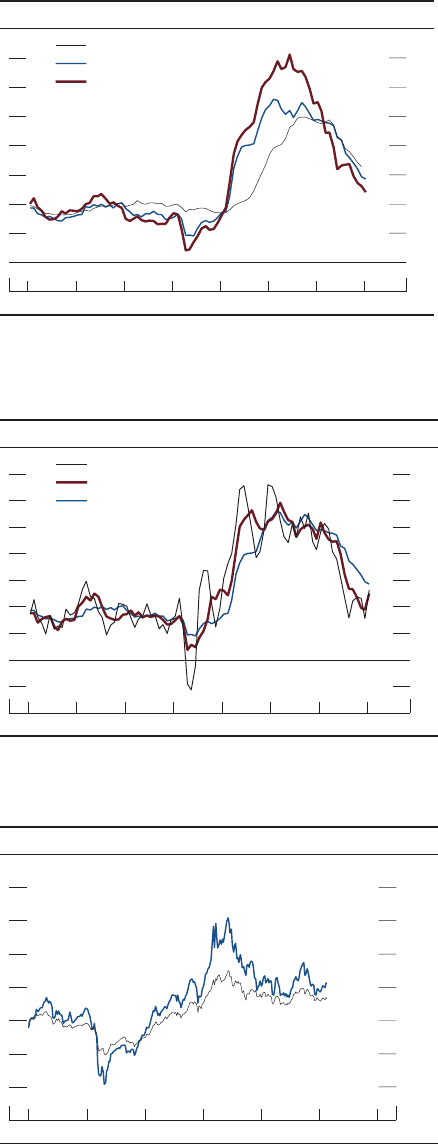
5
Domestic Developments
Ination has eased but remains elevated
After surging in 2021 and 2022, ination
slowed notably last year. The price index for
personal consumption expenditures (PCE)
rose 2.4percent over the 12months ending
in January, down from a peak of 7.1percent
in 2022, though still above the Federal Open
Market Committee’s (FOMC) longer-run
objective of 2percent (gure1). The core PCE
price index—which excludes volatile food
and energy prices—rose 2.8percent over the
12months ending in January. More recently,
core PCE prices increased at an annual rate
of 2.5percent over the six months ending
in January, though measuring ination over
relatively short periods risks exaggerating
the inuence of idiosyncratic or temporary
factors (gure2). The trimmed mean measure
of PCE prices constructed by the Federal
Reserve Bank of Dallas—which provides an
alternative approach to reducing the inuence
of idiosyncratic price movements—increased
3.3percent over the 12months ending
in December, somewhat higher than the
coreindex (gure 1).
Consumer energy prices have
declined, while food price ination has
slowedmarkedly
After hovering around $80 per barrel in the
rst half of last year, oil prices rose notably
in late summer, albeit to levels still well below
those seen in 2022, but have since declined,
on net, to around $83 per barrel (gure3).
Gasoline prices have followed a similar
pattern. The moderation in oil prices last
fall reects weak economic activity abroad
and increases in U.S. and other non-OPEC
(Organization of the Petroleum Exporting
Countries) oil production. Since late last year,
geopolitical tensions in the Middle East and
rerouting of shipping away from the Red Sea
have placed some upward pressure on oil
Part 1
recent economic and financiaL deveLoPments
Excluding food and energy
Total
0
1
2
3
4
5
6
7
Percent change from year earlier
20242023202220212020201920182017
1. Personal consumption expenditures price indexes
Monthly
N
OTE
: Trimmed mean data extend through December 2023.
S
OURCE
: For trimmed mean, Federal Reserve Bank of Dallas; for a
ll
else, Bureau of Economic Analysis; all via Haver Analytics.
Trimmed mean
12-month change
6-month change
1
+
_
0
1
2
3
4
5
6
7
Percent, annual rate
20242023202220212020201920182017
2. Core personal consumption expenditure price index
Monthly
SOURCE: Bureau of Economic Analysis, personal consumption
expenditures via Haver Analytics.
3-month change
Brent spot price
20
40
60
80
100
120
140
Dollars per barrel
2019 2020 2021 2022 2023 2024
3. Spot and futures prices for crude oil
Weekly
24-month-ahead
futures contracts
N
OTE
: The data are weekly averages of daily data and extend throug
h
February 23, 2024.
S
OURCE
: ICE Brent Futures via Bloomberg.
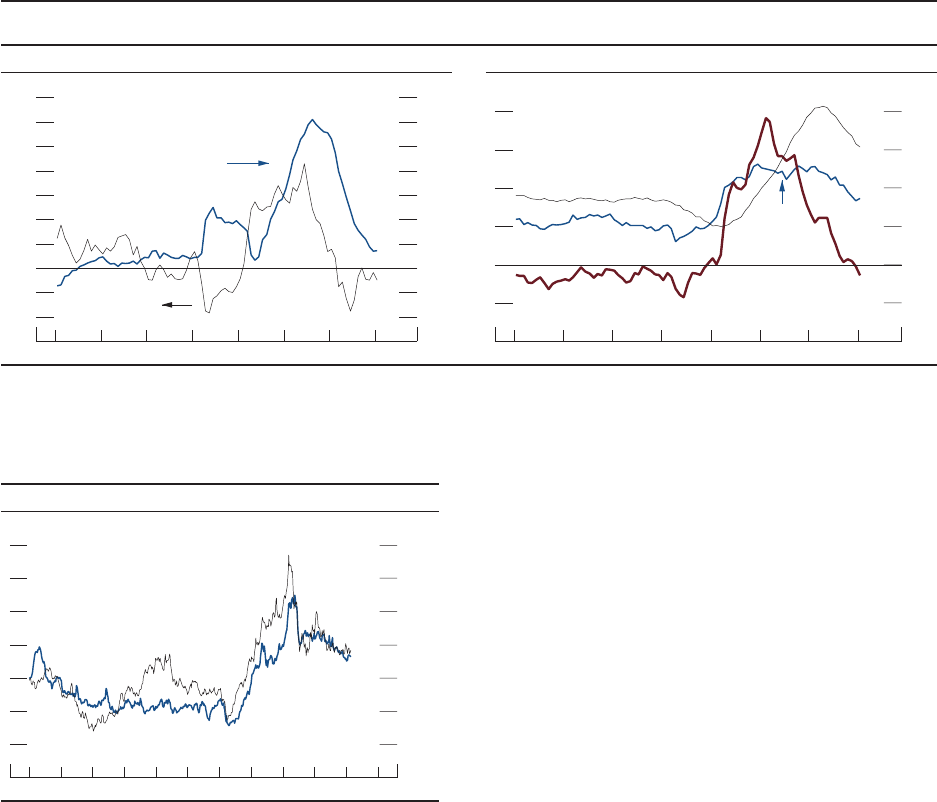
6 PART 1: RECENT ECONOMIC AND FINANCIAL DEVELOPMENTS
prices. Continuing geopolitical tensions pose
an upside risk to energy prices. Natural gas
prices remain well below the elevated 2022
levels due to strong production and high
inventory levels. All told, consumer energy
prices fell 4.9percent in the 12months ending
in January (gure4, left panel).
Food price ination slowed markedly last
year, as prices of agricultural commodities
and livestock fell (gure5). This moderation
brought the 12-month change in food prices
down to 1.4percent in January, a substantial
slowing from the 11percent increase recorded
over 2022 (gure4, left panel).
Prices of both energy and food products are
of particular importance for lower-income
households, for which such necessities account
for a large share of expenditures. Reecting the
sharp increases seen in 2021 and 2022, these
price indexes are about 25percent higher than
before the pandemic.
Core goods prices have been declining as
supply bottlenecks ease and import price
ination falls . . .
Outside of food and energy prices, there has
been signicant deceleration across the main
spending categories, though disination
Food and
beverages
Services
ex. energy
and housing
Goods ex. food, beverages, and energy
20
10
0
10
20
30
40
50
60
70
4
2
0
2
4
6
8
10
12
14
Percent change from year earlier
20242023202220212020201920182017
Food and energy
Percent change from year earlier
Energy
+
–
+
–
2
+
_
0
2
4
6
8
Percent change from year earlier
20242023202220212020201920182017
Components of core prices
Monthly
Housing services
NOTE: The data are monthly.
SOURCE: Bureau of Economic Analysis via Haver Analytics.
4. Subcomponents of personal consumption expenditures price indexes
Agriculture
and livestock
60
80
100
120
140
160
180
Week ending January 3, 2014 = 100
2014 2016 2018 2020 2022 2024
5. Spot prices for commodities
Weekly
Industrial metals
N
OTE
: The data are weekly averages of daily data and extend through
February 23, 2024.
S
OURCE
: For industrial metals, S&P GSCI Industrial Metals Spot
Index; for agriculture and livestock, S&P GSCI Agriculture & Livestock
Spot Index; both via Haver Analytics.
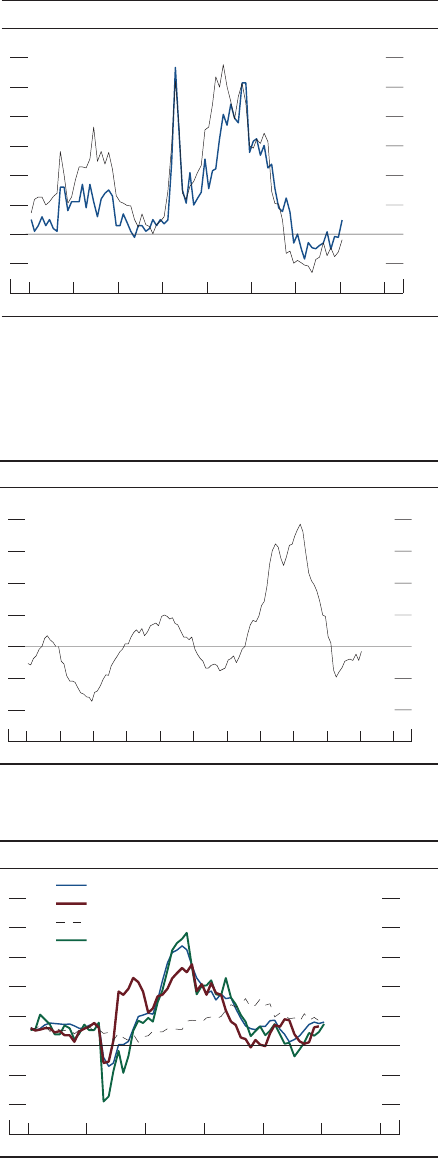
MONETARY POLICY REPORT: MARCH 2024 7
has been more pronounced in some than in
others (gure4, right panel). Core goods
prices fell 0.6percent in the 12 months
ending in January, and the deceleration was
broad based, as the supply chain issues and
other capacity constraints that had earlier
boosted ination so much eased substantially.
For example, suppliers’ delivery times had
lengthened considerably during the pandemic
but have been getting shorter over the past
year (gure6). Core goods ination was also
held down last year by a net decline in nonfuel
import prices, which, in turn, largely reected
falling commodity prices (gure7).
. . . while core services price ination has
been slowing but remains elevated
Price ination for both housing services and
core services other than housing slowed over
the past year, though it remains elevated.
Increases in housing services prices began
to moderate, coming in at 6.1percent in the
12months ending in January, down from a
peak of more than 8percent (gure4, right
panel). This slowing is consistent with the
notably smaller increases in market rents on
new housing leases to new tenants seen since
late 2022 (gure8). Because prices for housing
services measure the rents paid by all tenants
(and the equivalent rent implicitly paid by all
homeowners)—including those whose leases
have not yet come up for renewal—they tend
to adjust slowly to changes in rental market
conditions. The softening in market rents
therefore points to a continued deceleration in
housing services prices over the year ahead.
Prices for nonhousing core services—a
broad group that includes services such as
travel and dining, nancial services, and car
repair—rose 3.5percent in the 12 months
ending in January, down from their recent
peak of 5.2percent (gure4, right panel).
As labor costs are a signicant input in these
service sectors, the ongoing softening of labor
demand and improvements in labor supply
should contribute to a further slowing in core
services price ination as labor cost growth
moderates.
Nonmanufacturing
45
50
55
60
65
70
75
80
Diusion index
20242023202220212020201920182017
6. Suppliers’ delivery times
Monthly
Manufacturing
NOTE: Values greater than 50 indicate that more respondents reported
longer delivery times relative to a month earlier than reported shorter
delivery times.
S
OURCE: Institute for Supply Management, Report on Business, via
Haver Analytics.
4
2
+
_
0
2
4
6
8
Percent change from year earlier
202420222020201820162014
7. Nonfuel import price index
Monthly
S
OURCE
: Bureau of Labor Statistics via Haver Analytics.
Zillow
RealPage
CoreLogic single-family detached
1.0
.5
+
_
0
.5
1.0
1.5
2.0
2.5
Percent change from month earlier
202420232022202120202019
8. Housing rents
Monthly
NOTE: CoreLogic data extend through December 2023. Zillow,
CoreLogic, and RealPage measure market-rate rents—that is, rents for a
new lease by a new tenant.
S
OURCE: Bureau of Economic Analysis, PCE, via Haver Analytics;
CoreLogic, Inc.; Zillow, Inc.; RealPage, Inc.; Federal Reserve Board sta
calculations.
PCE housing services

8 PART 1: RECENT ECONOMIC AND FINANCIAL DEVELOPMENTS
Measures of longer-term ination
expectations have been stable, while
shorter-term expectations have
fallenback
The generally held view among economists and
policy analysts is that ination expectations
inuence actual ination by aecting wage-
and price-setting decisions. Survey-based
measures of expected ination over a longer
horizon have generally been moving sideways
over the past year, within the range seen during
the decade before the pandemic, and they
appear broadly consistent with the FOMC’s
longer-run 2percent ination objective. This
development is seen for surveys of households,
such as the University of Michigan Surveys
of Consumers, and for surveys of professional
forecasters (gure9). For example, the median
forecaster in the Survey of Professional
Forecasters, conducted by the Federal Reserve
Bank of Philadelphia, continued to expect
PCE price ination to average 2percent over
the ve years beginning ve years fromnow.
Moreover, ination expectations over a shorter
horizon—which tend to follow observed
ination more closely—have been reversing
their earlier run-ups. In the Michigan survey,
the median value for ination expectations
over the next year was 3.0percent in February,
well below the peak rate of 5.4percent
observed in spring 2022. Expected ination
for the next year as measured in the Survey
of Consumer Expectations, conducted by
the Federal Reserve Bank of New York, has
also declined, on net, over this period and has
returned to the range of values seen before
thepandemic.
Market-based measures of longer-term
ination compensation, which are based on
nancial instruments linked to ination such
as Treasury Ination-Protected Securities,
are also broadly in line with readings seen in
the years before the pandemic and consistent
with ination returning to 2percent. These
measures have been little changed, on net,
since last summer (gure10).
SPF, next 10 years
Michigan survey, next 5 to 10 years
SPF, 6 to 10 years ahead
1.5
2.0
2.5
3.0
3.5
4.0
4.5
5.0
5.5
6.0
6.5
Percent
202420222020201820162014201220102008
9. Measures of ination expectations
NOTE: The Survey of Professional Forecasters (SPF) data are
quarterly and extend through 2024:Q1. The data for the Michigan surve
y
are monthly and extend through February 2024; the February data are
preliminary.
S
OURCE
: University of Michigan Surveys of Consumers; Federal
Reserve Bank of Philadelphia, SPF.
Michigan survey, next 12 months
5-year
0
.5
1.0
1.5
2.0
2.5
3.0
3.5
4.0
Percent
202420232022202120202019201820172016
10. Ination compensation implied by Treasury
Ination-Protected Securities
Daily
5-to-10-year
N
OTE:The data are at a business-day frequency and are estimated
from smoothed nominal and ination-indexed Treasury yield curves.
S
OURCE: Federal Reserve Bank of New York; Federal Reserve Board
sta calculations.
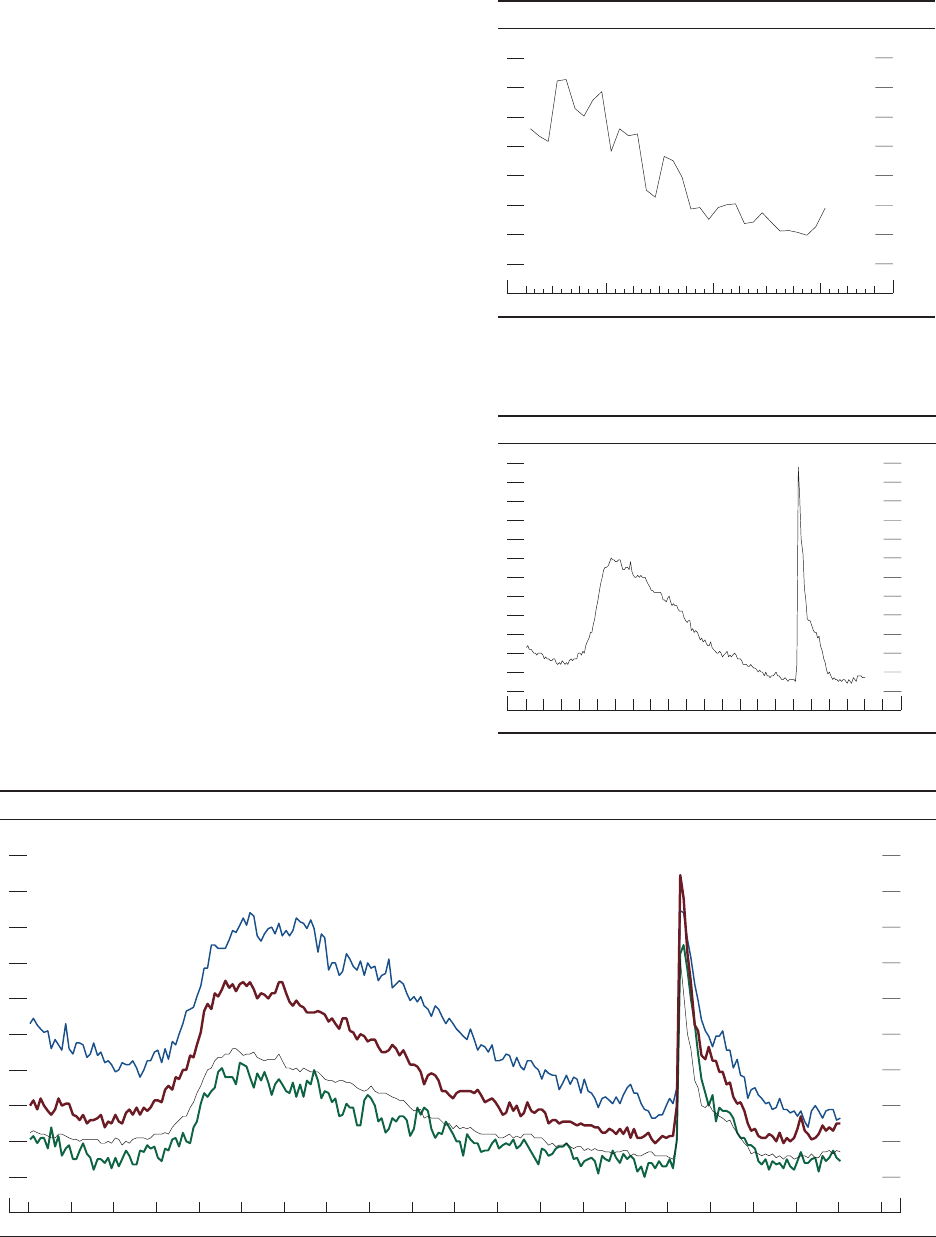
MONETARY POLICY REPORT: MARCH 2024 9
Black or African American
Asian
Hispanic or Latino
2
4
6
8
10
12
14
16
18
20
Percent
2024202220202018201620142012201020082006
13. Unemployment rate, by race and ethnicity
Monthly
White
N
OTE
: Unemployment rate measures total unemployed as a percentage of the labor force. Persons whose ethnicity is identied as Hispanic or Latino
may
be of any race. Small sample sizes preclude reliable estimates for Native Americans and other groups for which monthly data are not reported b
y
the Bureau of Labor Statistics.
S
OURCE
: Bureau of Labor Statistics via Haver Analytics.
The labor market remains strong
Payroll employment gains have been robust,
averaging 239,000 since June of last year.
The pace of job gains has nevertheless been
softening, having averaged more than 375,000
per month in 2022 and about 290,000 in the
rst half of 2023 (gure11). This slowing
has come primarily from the professional and
business services, manufacturing, and leisure
and hospitality sectors, which tend to be
cyclically sensitive. In contrast, employment
growth has remained strong in the health-
care and social assistance sector and at state
and local governments, which tend to be less
cyclically sensitive and are still recovering from
pandemic-era stang shortages.
The unemployment rate edged up, on net,
since the middle of last year, but at 3.7percent
in January, it is only slightly above its pre-
pandemic level and remains very low by
historical standards (gure12). Indeed,
unemployment rates among most age,
educational attainment, sex, and ethnic and
racial groups are near their respective historical
lows (gure13). (The box “Employment
and Earnings across Demographic Groups”
provides further details.)
100
200
300
400
500
600
700
800
Thousands of jobs
2024202320222021
11. Nonfarm payroll employment
Monthly
N
OTE
: The data shown are a 3-month moving average of the change in
nonfarm payroll employment.
S
OURCE
: Bureau of Labor Statistics via Haver Analytics.
3
4
5
6
7
8
9
10
11
12
13
14
15
Percent
2024202220202018201620142012201020082006
12. Civilian unemployment rate
Monthly
S
OURCE
: Bureau of Labor Statistics via Haver Analytics.
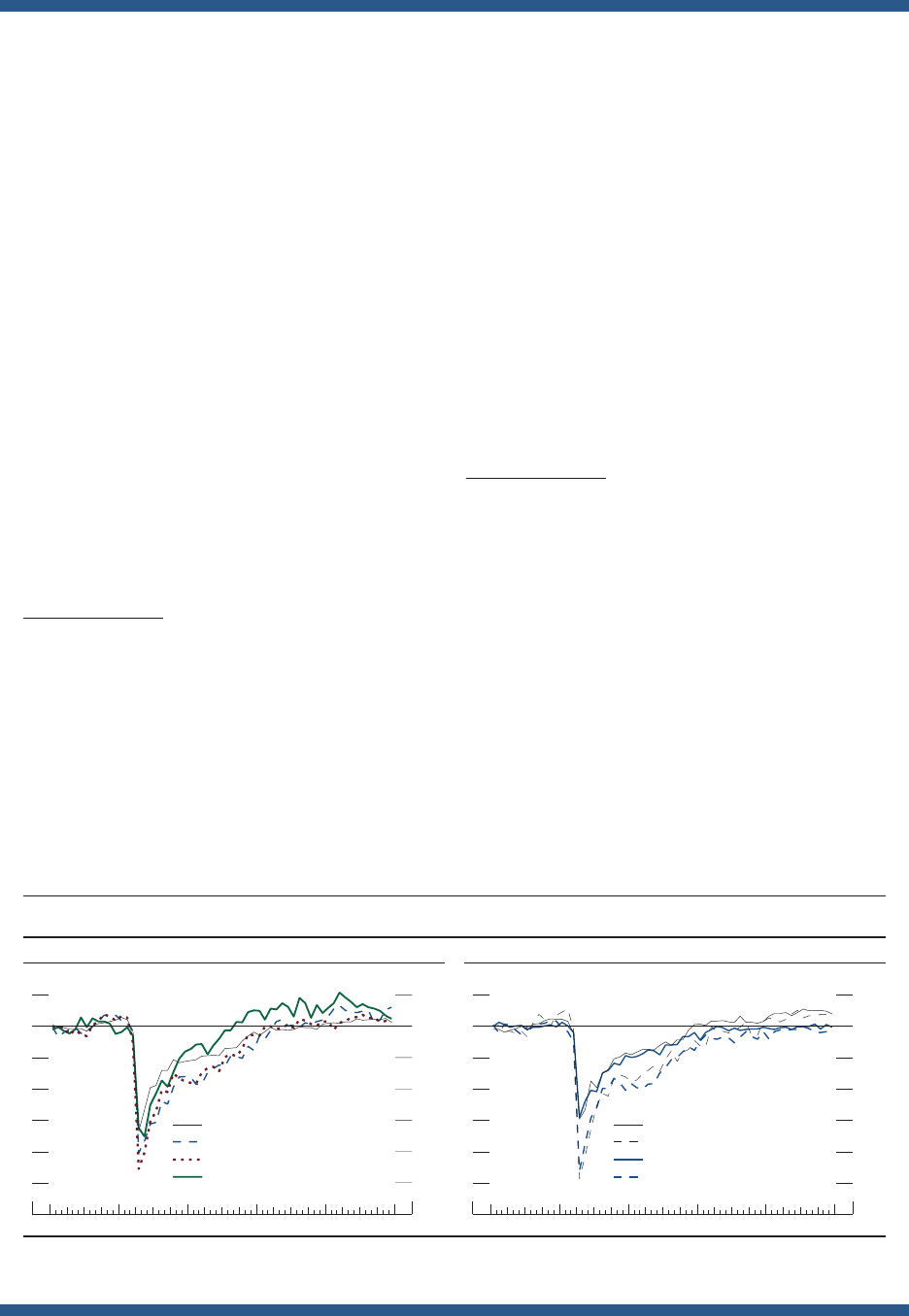
10 PART 1: RECENT ECONOMIC AND FINANCIAL DEVELOPMENTS
workers was also historically high in early 2023,
although it has since moved down closer to its
2019level.
3
Similarly, the EPOP ratio for prime-age women
increased steadily over the past two years and reached
a record high in 2023 ( gureA, right panel). As a
result, the EPOP ratio gap between prime-age men
and women fell to a record low. The recent increase in
female employment is mostly attributable to rising labor
force participation, which had also been increasing
briskly before the pandemic, bolstered by a growing
share of women with a college degree.
4
Other factors,
including tight labor market conditions and greater
availability of remote-work options, may have also
contributed to rising prime-age female labor force
participation.
5
3. As monthly series have greater sampling variability
for smaller groups, we do not plot EPOP ratio estimates for
American Indians or Alaska Natives.
4. For a discussion of the contribution of educational
attainment to prime-age female labor force participation
before the pandemic, see Didem Tüzemen and Thao Tran
(2019), “The Uneven Recovery in Prime-Age Labor Force
Participation,” Federal Reserve Bank of Kansas City,Economic
Review, vol. 104 (Third Quarter), pp. 21–41, https://www.
kansascityfed.org/Economic%20Review/documents/652/2019-
The%20Uneven%20Recovery%20in%20Prime-Age%20
Labor%20Force%20Participation.pdf.
5. For a discussion on access to remote work and
participation rates, see Maria D. Tito (2024), “Does the
Ability to Work Remotely Alter Labor Force Attachment?
An Analysis of Female Labor Force Participation,” FEDS
Notes (Washington: Board of Governors of the Federal
Reserve System, January19), https://doi.org/10.17016/2380-
7172.3433.
Economic expansions have tended to narrow long-
standing disparities in employment and earnings across
demographic groups, which can help make up for
disproportionate losses experienced during downturns.
These bene ts have been especially pronounced during
the current expansion, which has been characterized
by an exceptionally tight labor market and robust
demand for workers over the past two years.
Among prime-age individuals (ages 25 to 54),
employment for Black or African American workers,
which declined more relative to white and Asian
workers in early 2020, reached a historical peak in
2023 ( gureA, left panel). As a result, the gap in the
employment-to-population (EPOP) ratio between
prime-age Black and white workers fell to its lowest
point in almost 50years.
1
Hispanic or Latino workers
experienced especially large employment losses in
2020, due in part to greater exposure to the industries
most affected by the pandemic.
2
By early 2022,
however, this group’s EPOP ratio gap relative to prime-
age white workers had recovered to its 2019 average
and has remained near this historically low level for the
past two years. The EPOP ratio for prime-age Asian
1. In fact, for the population aged 16 or older, the
EPOP ratio was the same for Black and white individuals
in January2024 (not shown). This equivalence, however,
partly re ects the fact that these groups have different age
distributions, with whites older, on average, and thus more
likely to be retired.
2. On the relationship between occupation, industry, and
the differential effect of the COVID-19 pandemic across
demographic groups, see Guido Matias Cortes and Eliza
Forsythe (2023), “Heterogeneous Labor Market Impacts of the
COVID-19 Pandemic,” ILR Review, vol. 76 (January), pp.30–55.
(continued)
Employment and Earnings across Demographic Groups
Black or African American
Men, some college or more
Men, high school or lessAsian
Hispanic or Latino
15
12
9
6
3
+
_
0
3
Percentage points
20232022202120202019
Race and ethnicity
Monthly
NOTE: The data extend through December 2023. Prime age is 25 to 54. All series are seasonally adjusted by the Federal Reserve Board sta.
SOURCE: Bureau of Labor Statistics; U.S. Census Bureau, Current Population Survey; Federal Reserve Board sta calculations.
White
15
12
9
6
3
+
_
0
3
Percentage points
20232022202120202019
Sex and educational attainment
Monthly
Women, some college or more
Women, high school or less
A. Prime-age employment-to-population ratios compared with the 2019 average ratio, by group
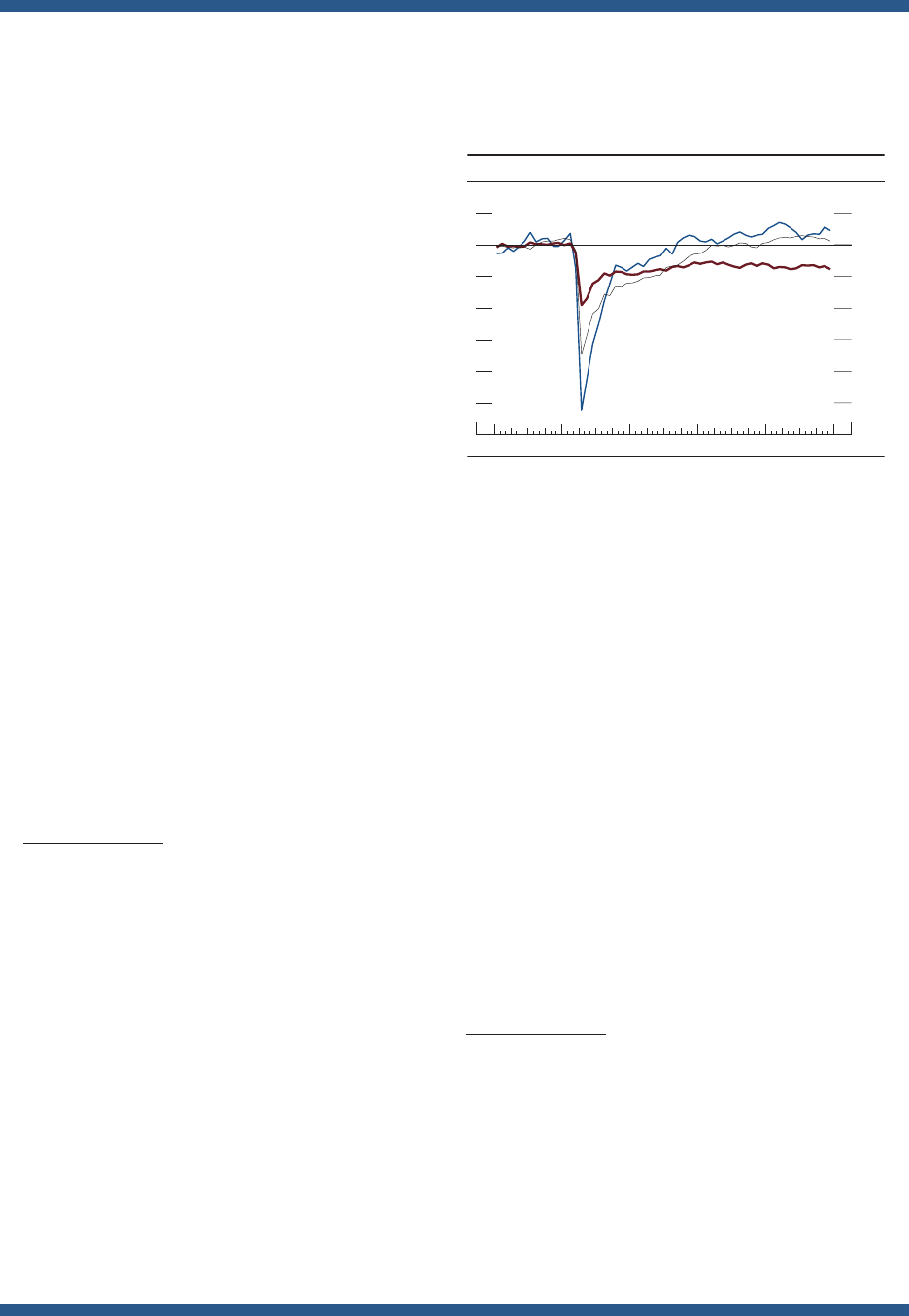
MONETARY POLICY REPORT: MARCH 2024 11
two years have also led to strong nominal wage growth,
especially for groups at the lower end of the earnings
distribution. As shown in the top-left panel of gureC,
real wage growth—as measured by the Federal Reserve
Bank of Atlanta’s Wage Growth Tracker and de ated by
the personal consumption expenditures price index—
has been consistently stronger for workers in lower
wage quartiles.
9
Stronger wage growth at the bottom of the income
distribution is re ected in the experiences of different
education and demographic groups. In the rst two
years of the recovery, real wage growth was stronger
for workers with a high school diploma or less relative
to workers with a bachelor’s degree or more ( gureC,
top-right panel) and, in the past two years, has also
been stronger for nonwhite workers relative to white
workers ( gureC, bottom-left panel). Wages for men
and women, by contrast, have largely grown in tandem
( gureC, bottom-right panel).
10
In addition to the
in uence of a tight labor market, differences in wage
9. To reduce noise due to sampling variation, which can
be pronounced when considering disaggregated groups’
wage changes, the series shown in gure C are the 12-month
moving averages of the groups’ median 12-month real wage
changes. Thus, by construction, these series lag the actual real
wage changes.
10. The measure of real earnings growth shown in the
gure uses the same price index for all groups, but in ation
experiences can differ across demographic groups because
of differences in what they purchase or where they shop.
See Jacob Orchard (2021), “Cyclical Demand Shifts and
Cost of Living Inequality,” working paper, February (revised
September2022).
Robust labor demand over the past two years has
also reversed pandemic-induced employment losses
across education groups. For both prime-age men
and women, the EPOP ratio fell signi cantly more for
workers with a high school diploma or less compared
with those with at least some college education, largely
re ecting industry exposure to pandemic-related
closures or some differences in the ability to work
remotely across jobs. Notably, the EPOP ratio declined
similarly for men and women with the same education
level, a result that contrasts with those in previous
recessions, in which male EPOP losses have historically
outpaced female losses.
6
The unusually large effect on
women during the pandemic also re ects the industry
composition of job losses, as well as caregiving needs.
7
While employment disparities across many
demographic groups are now within historically narrow
ranges, substantial gender, racial, and ethnic gaps
remain, underscoring long-standing structural factors.
Currently, prime-age women are employed at a rate
11percentage points less than men, while prime-age
Black and Hispanic workers are employed at a rate
3 to 4percentage points less than white workers.
Further, the differential effect of the pandemic on
the employment of older workers has proven highly
persistent. The EPOP ratio for workers aged 55 or older
remains approximately 2percentage points below its
pre-pandemic level and has changed little since late
2021 ( gureB). This shortfall is wholly attributable to
decreases in labor force participation stemming from
increased retirements concentrated among workers
aged 60 or older.
8
In addition to narrowing many employment gaps,
historically tight labor market conditions over the past
6. See Claudia Goldin (2022), “Understanding the
Economic Impact of COVID-19 on Women,” Brookings Papers
on Economic Activity, Spring, pp. 65–110, https://www.
brookings.edu/wp-content/uploads/2022/03/16265-BPEA-
Sp22_Goldin_WEB-Appendix.pdf; and Stefania Albanesi and
Jiyeon Kim (2021), “Effects of the COVID-19 Recession on the
US Labor Market: Occupation, Family, and Gender,” Journal of
Economic Perspectives, vol. 35 (Summer), pp. 3–24.
7. On the role of caregiving, see Joshua Montes,
Christopher Smith, and Isabel Leigh (2021), “Caregiving for
Children and Parental Labor Force Participation during the
Pandemic,” FEDS Notes (Washington: Board of Governors
of the Federal Reserve System, November5), https://www.
federalreserve.gov/econres/notes/feds-notes/caregiving-for-
children-and-parental-labor-force-participation-during-the-
pandemic-20211105.html.
8. For an analysis on the increase in retirements following
the pandemic, see Joshua Montes, Christopher Smith, and
Juliana Dajon (2022), “ ‘The Great Retirement Boom’: The
Pandemic-Era Surge in Retirements and Implications for Future
Labor Force Participation,” Finance and Economics Discussion
Series 2022-081 (Washington: Board of Governors of the
Federal Reserve System, November), https://doi.org/10.17016/
FEDS.2022.081.
Ages 16 to 24
Ages 55+
15
12
9
6
3
+
_
0
3
Percentage points
20232022202120202019
B. Employment-to-population ratios relative to 2019
average, by age
Monthly
Ages 25 to 54
N
OTE
: The data extend through December 2023. Data before Januar
y
2023
are estimated by Federal Reserve Board sta in order to eliminat
e
discontinuities in the published history.
S
OURCE
:Bureau of Labor Statistics; U.S. Census Bureau, Curren
t
Population Survey; Federal Reserve Board sta calculations.
(continued on next page)
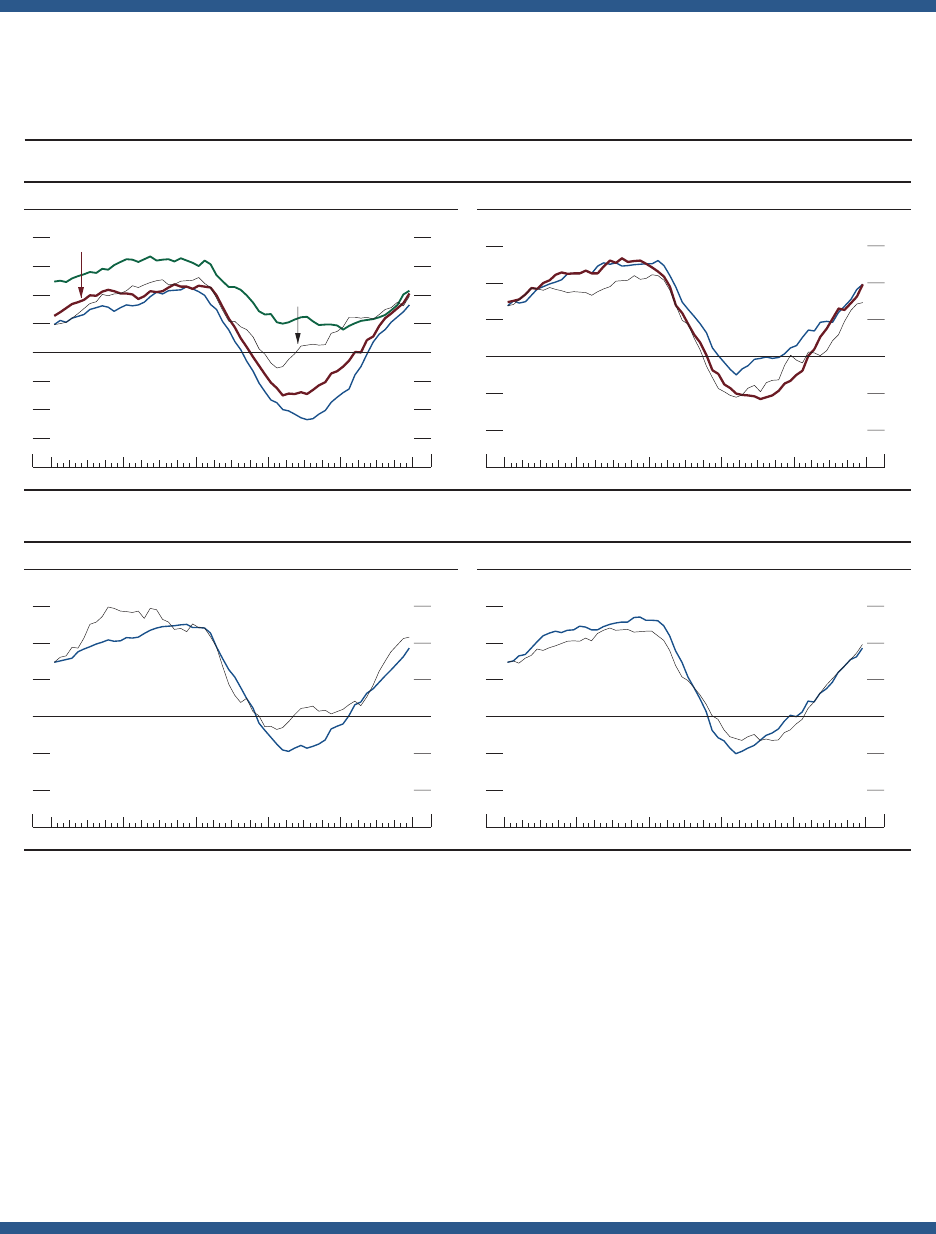
12 PART 1: RECENT ECONOMIC AND FINANCIAL DEVELOPMENTS
growth across groups have narrowed considerably.
While the labor market is still tight by historical
standards, factors disproportionately boosting wage
growth for the lowest earners have largely faded. In
2023, nominal wage growth slowed for workers with
below-median earnings but stepped up for workers
above the median. Even so, the gaps in relative wages
between workers in the rst three quartiles and those
in the highest quartile continue to close, albeit at a
slowerpace.
growth across groups partially re ect factors speci c
to the post-pandemic recovery, such as the sectoral
composition of labor demand and supply. Wages, for
instance, grew faster than average in the leisure and
hospitality industry, a relatively low-wage sector that
suffered disproportionate employment losses during
the pandemic, followed by a surge in vacancies that
employers struggled to ll as the economy reopened.
Over the past year, real wages have been rising for
all groups shown here, and differences in real wage
Employment and Earnings (continued)
4th quartile
High school or less
1st quartile3rd quartile
Bachelor’s degree or more
3
2
1
+
_
0
1
2
3
4
Percent
20232022202120202019
Wage quartiles
Monthly
2nd quartile
2
1
+
_
0
1
2
3
Percent
20232022202120202019
Educational attainment
Monthly
Associate’s degree
C. Median real wage growth, by group
White
Men
2
1
+
_
0
1
2
3
Percent
20232022202120202019
Race
Monthly
Nonwhite
2
1
+
_
0
1
2
3
Percent
20232022202120202019
Sex
Monthly
N
OTE
: The data extend through December 2023. Series show 12-month moving averages of the median percent change in the hourly wage o
f
individuals
observed 12 months apart, deated by the 12-month moving average of the 12-month percent change in the personal con
sumption
expenditures
price index. In the top-left panel, workers are assigned to wage quartiles based on the average of their wage reports in both
Current
Population Survey outgoing rotation group interviews; workers in the lowest 25 percent of the average wage distribution are ass
igned to the 1st quartile,
and those in the top 25 percent are assigned to the 4th quartile.
S
OURCE
: Federal Reserve Bank of Atlanta, Wage Growth Tracker; Bureau of Labor Statistics; U.S. Census Bureau, Current Population Survey.
Women
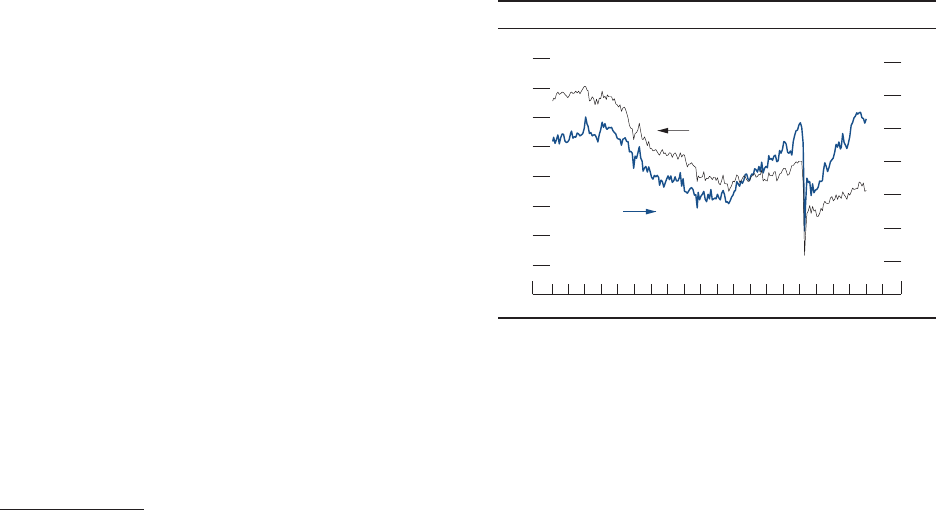
MONETARY POLICY REPORT: MARCH 2024 13
Labor demand has been gradually
cooling. . .
Demand for labor continued to cool last year
but remains robust. The Job Openings and
Labor Turnover Survey (JOLTS) indicated
that there were nearly 9million job openings
at the end of 2023—down about 3million
from the all-time high recorded in March2022
but still around 2million above pre-pandemic
levels. An alternative measure of job vacancies
constructed by the Federal Reserve Board
sta using job postings data from the large
online job board Indeed also shows that
vacancies continued to move gradually
lower through mid-February but remained
above pre-pandemic levels. In addition,
measures of layos, such as initial claims
for unemployment insurance and the rate of
layos and discharges in the JOLTS, have
remained very low by historical standards.
. . . and labor supply has increased
further . . .
Meanwhile, the supply of labor has
continued to increase on net. The labor force
participation rate, which measures the share of
people either working or actively seeking work,
continued to trend higher for most of last year
but has softened in recent months (gure14).
Importantly, labor force participation for
prime-age workers increased notably through
last September and, although it has edged
down more recently, remains above its pre-
pandemic level.
Labor supply was also boosted last year by
relatively strong population growth. The
Census Bureau estimates that the resident
population increased 1.7million (0.5percent)
in 2023, with almost 70percent of that
increase coming from immigration.
2
Last
2. A recent report from the Congressional Budget
Oce estimates that immigration has been considerably
higher than in the Census Bureau’s estimates in recent
years; see Congressional Budget Oce (2024), The
Demographic Outlook: 2024 to 2054 (Washington: CBO,
January), https://www.cbo.gov/publication/59697. The
labor force estimates published by the Bureau of Labor
Statistics are based on the civilian noninstitutionalized
population aged 16 or older, which constitutes about
80percent of the resident population.
Ages 25 to 54
79
80
81
82
83
84
85
Percent
60
61
62
63
64
65
66
67
2024202220202018201620142012201020082006
14. Labor force participation rate, by age
Percent
Ages 16+
N
OTE: The labor force participation rate is a percentage of the relevant
population. Data are monthly, and values before January 2023 are
estimated by Federal Reserve Board sta in order to eliminate
discontinuities in the published history.
S
OURCE: Bureau of Labor Statistics via Haver Analytics; U.S. Census
Bureau; Federal Reserve Board sta calculations.

14 PART 1: RECENT ECONOMIC AND FINANCIAL DEVELOPMENTS
year’s rate of population growth was slightly
faster than in 2022 and about twice as fast as
in 2020 and 2021, when growth was held down
by COVID-19-related increases in mortality
and restrictions on immigration. Although
population growth has largely returned to its
pace from the years preceding the pandemic,
it remains well below its average from
1990 to2015.
. . . but the labor market remains
relatively tight
Even with easing labor demand and rising
labor supply, the labor market remains
relatively tight. Some indicators suggest that
the labor market remains tighter than before
the pandemic, while others have returned
to their 2019 ranges, when the labor market
was also relatively tight. The number of total
available jobs (measured by employed workers
plus job openings) still exceeds the number
of available workers (measured by the labor
force). This jobs–workers gap was around
2.8million in December, down markedly from
its peak of 6.0million recorded in March2022
but still above its 2019 average of 1.1million
(gure15).
3
In contrast, the percentage of
workers quitting their jobs each month, an
indicator of the availability of attractive job
prospects, was 2.2percent in December, close
to its 2019 average. Surveys indicate that
households’ and small businesses’ perceptions
of labor market tightness have also come down
from their recent peaks. In addition, business
contacts in nearly all Federal Reserve Districts
cited signs of a cooling labor market, such
as larger applicant pools and lower turnover
rates; however, some employers continued to
report diculty nding workers, particularly
employers seeking specialized skills.
4
3. The ratio of job openings to unemployment shows
that there were 1.4job openings per unemployed person
in December2023. For comparison, this ratio averaged
1.2 in 2019 and 0.6 over the 10-year period from 2010
to2019.
4. See the January2024 Beige Book, available on
the Board’s website at https://www.federalreserve.gov/
monetarypolicy/publications/beige-book-default.htm.
Available workers
135
140
145
150
155
160
165
170
175
Millions
2023202120192017201520132011200920072005
15. Available jobs versus available workers
Monthly
N
OTE
: The data extend through December 2023. Available jobs are
employment plus job openings as of the end of the previous month.
Available workers are the labor force. Data for employment and labor
force before January 2023 are estimated by Federal Reserve Board sta
in order to eliminate discontinuities in the published history.
S
OURCE
: Bureau of Labor Statistics via Haver Analytics; U.S. Census
Bureau; Federal Reserve Board sta calculations.
Available jobs
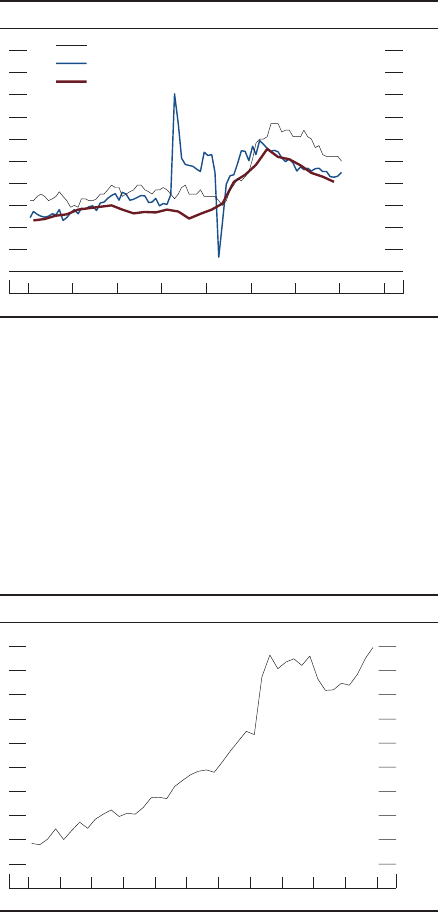
MONETARY POLICY REPORT: MARCH 2024 15
Wage growth has slowed but
remainselevated
Consistent with the easing in labor market
tightness, nominal wage growth slowed in 2023
but remains elevated (gure16). Total hourly
compensation as measured by the employment
cost index increased 4.2percent over the
12months ending in December, a noticeable
slowing from the 5.1percent increase in 2022.
Other aggregate measures, such as average
hourly earnings (a less comprehensive measure
of compensation) and the Federal Reserve
Bank of Atlanta’s Wage Growth Tracker,
which reports the median 12-month wage
growth of individuals responding to the
Current Population Survey, have slowed as
well. With PCE prices having risen 2.6percent
in 2023, these measures suggest that most
workers saw increases in the purchasing power
of their wages over the pastyear.
Labor productivity strengthened last year
The extent to which nominal wage gains raise
rms’ costs and act as a source of ination
pressure depends importantly on the pace of
productivity growth. Labor productivity in the
business sector has been extremely variable
since the pandemic began, increasing sharply
in 2020 and then declining, on average, over
2021 and 2022 (gure17). Productivity is
reported to have risen a robust 2.7percent
last year. When averaged over the pandemic
period, output per hour rose at a moderate
average annual rate of 1½percent, in line with
the average rate of growth observed during the
business cycle from the fourth quarter of 2007
to the fourth quarter of 2019.
As always, the pace of future productivity
growth remains highly uncertain. It is possible
that productivity growth could remain at
around this same moderate pace. However,
it is also possible that the rapid adoption of
new technologies like articial intelligence
and robotics—as well as the high rate of new
business formation that the pandemic brought
about—could boost productivity growth above
that pace in coming years.
Average hourly earnings, private sector
Employment cost index, private sector
0
1
2
3
4
5
6
7
8
9
10
Percent change from year earlier
20242023202220212020201920182017
16. Measures of change in hourly compensation
Atlanta Fed’s Wage Growth Tracker
NOTE: For the private-sector employment cost index, change is over
the
12 months ending in the last month of each quarter; for
private-sector
average hourly earnings, the data are 12-month percent changes; for
the
Atlanta Fed’s Wage Growth Tracker, the data are shown as a
3-month
moving average of the 12-month percent change.
SOURCE
: Bureau of Labor Statistics; Federal Reserve Bank of Atlanta,
Wage Growth Tracker; all via Haver Analytics.
94
96
98
100
102
104
106
108
110
112
2017 average = 100
202320212019201720152013
17. U.S. labor productivity
Quarterly
NOTE: The data are output per hour in the business sector.
SOURCE: Bureau of Labor Statistics via Haver Analytics.
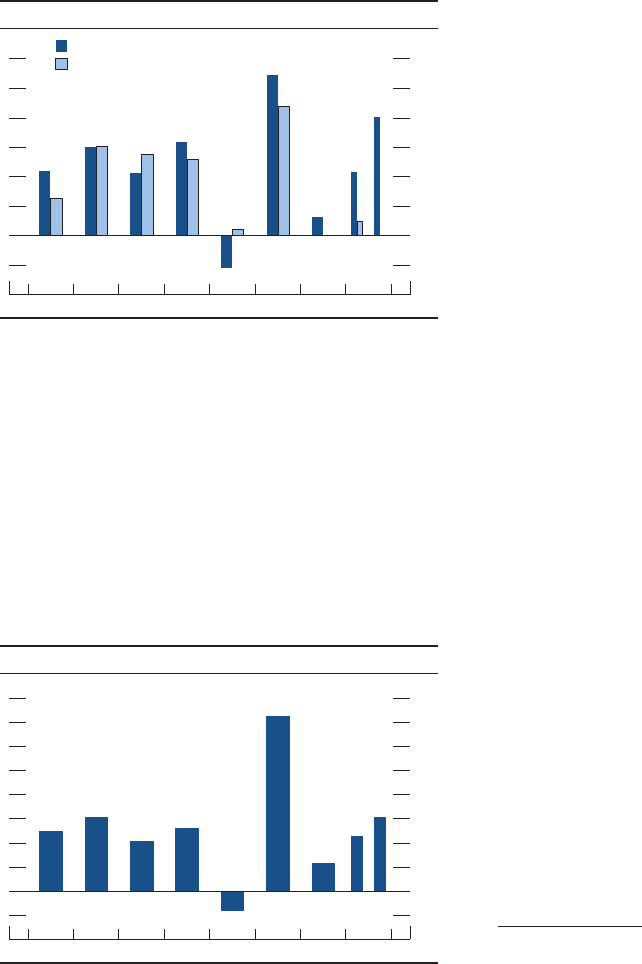
16 PART 1: RECENT ECONOMIC AND FINANCIAL DEVELOPMENTS
Gross domestic product rose at a solid
pace last year
Real gross domestic product (GDP) is
reported to have increased at an annual rate
of 4.0percent in the second half of 2023,
up from 2.2percent in the rst half. For
2023 as a whole, GDP increased 3.1percent,
notably faster than in 2022 despite restrictive
nancial conditions, including elevated longer-
term interest rates (gure18).
5
Among the
components of GDP, consumer spending rose
solidly in the second half of last year, and
residential investment started to turn back up
following its earlier sharp declines, but growth
of business investment slowed.
In contrast to GDP, manufacturing output
was little changed, on net, last year, a
downshift following two years of robust post-
pandemic gains. Motor vehicle production
continued to rebound from supply chain
disruptions in 2021 and 2022, although last
year’s production was held down by strikes at
several major automakers. Outside of motor
vehicles, industrial production generally
moved sideways last year, but it was down
from its post-pandemic peak in early 2022,
as inventories normalized and new orders
fellback.
Consumer spending growth was resilient
even as household nances deteriorated
Consumer spending adjusted for ination grew
at a solid rate of 3.0percent in the second half
of 2023 and 2.7percent for last year as a whole
(gure19). Consumers’ resilience in the face
5. Real gross domestic income (GDI) has been
notably weaker than GDP in recent quarters; both series
measure the same economic concept, and any dierence
between the two gures reects measurement error. GDI
reportedly increased at a 0.8percent pace in the rst three
quarters of last year after having been unchanged over
the four quarters of 2022—well below the corresponding
gures for GDP. As a result, productivity calculated from
the income side of the national accounts would also be
considerably weaker than the published gures over the
past couple of years.
1
+
_
0
1
2
3
4
5
6
Percent, annual rate
20232022202120202019201820172016
18. Change in real gross domestic product and gross
domestic income
H1
H2
H1
H2
N
OTE
: The data for gross domestic income extend through 2023:H1.
The key identies bars in order from left to right.
S
OURCE
: Bureau of Economic Analysis via Haver Analytics.
Gross domestic product
Gross domestic income
1
+
_
0
1
2
3
4
5
6
7
8
Percent, annual rate
20232022202120202019201820172016
19. Change in real personal consumption expenditures
H1
H2
S
OURCE
: Bureau of Economic Analysis via Haver Analytics.
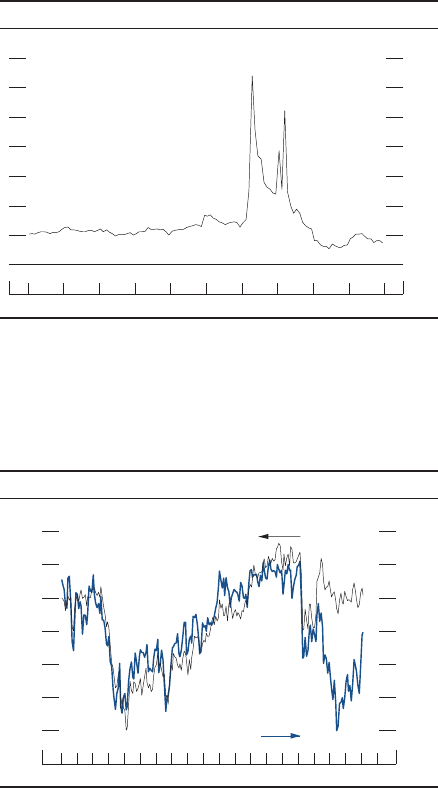
MONETARY POLICY REPORT: MARCH 2024 17
of tight nancial conditions was supported
by the strong labor market and rising real
incomes. Indeed, after declining, on average,
in 2021 and 2022, real disposable personal
income increased robustly last year. However,
last year’s spending was also accompanied by
households drawing down their liquid assets,
such as checking accounts, and by relying
more on credit. Indeed, the saving rate was
3.9percent in the fourth quarter of 2023,
well below pre-pandemic levels (gure20). In
addition, although household wealth relative
to income remains high in the aggregate, it has
declined, on net, since the end of 2021 and so
is likely providing less support to consumer
spending. Consumer spending since the
pandemic has been more robust than measures
of consumer sentiment would suggest.
Although sentiment in the Michigan survey
has improved markedly in recent months, it
remains much further below its pre-pandemic
level than does a similar measure from the
Conference Board, which puts more weight on
labor market conditions (gure21).
Consumer nancing conditions tightened
last year
Credit remains available for most consumers,
though interest rates on both credit cards
and auto loans remain higher than the levels
observed in 2018 at the peak of the previous
monetary policy tightening cycle. Indeed,
interest rates on credit cards have continued
to increase since the rst half of last year. In
addition, banks reported continued tightening
of lending standards across consumer
credit products, in part reecting lenders’
concerns about further deterioration in
credit performance and higher funding costs.
Delinquency rates for credit cards rose further
over the second half of 2023, while those for
auto loans attened out; both rates are notably
above levels observed just before the pandemic.
Reecting these and other factors, consumer
credit expanded moderately during the second
half of last year, driven by robust growth in
credit card balances and modest growth in
0
5
10
15
20
25
30
35
PercentMonthly
2023202220212020201920182017201620152014
20. Personal saving rate
NOTE: The data extend through December 2023.
S
OURCE
: Bureau of Economic Analysis via Haver Analytics.
Michigan survey
50
60
70
80
90
100
110
February 1966 = 100
25
45
65
85
105
125
145
2024202220202018201620142012201020082006
1985 average = 100
21. Indexes of consumer sentiment
Conference Board
N
OTE: The data are monthly and extend through February 2024. The
February data for the Michigan survey are preliminary.
S
OURCE: University of Michigan Surveys of Consumers; Conference
Board.
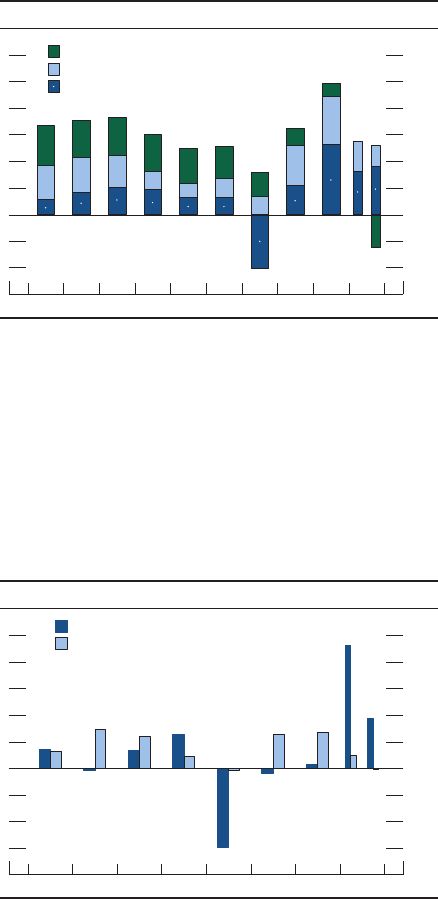
18 PART 1: RECENT ECONOMIC AND FINANCIAL DEVELOPMENTS
auto loans (gure22). In contrast, student
loan balances fell in the second half of last
year, in large part driven by the cancellation
of debt for certain borrowers in income-driven
repayment plans.
Residential investment turned around and
grew modestly in the second half of 2023
After declining steeply in 2022 on the heels of
the substantial rise in mortgage interest rates,
residential investment fell a bit further in the
rst half of 2023 but picked up in the second
half of the year. The pickup in housing activity
since mid-2023 masked some important
dierences across components of the market,
with sales of existing homes much weaker than
sales of new homes and with construction of
single-family homes remaining relatively solid
while multifamily construction declined. (The
box “Recent Housing Market Developments”
provides further discussion.)
Capital spending growth softened amid
tighter nancial conditions and subdued
sentiment
Tighter nancial conditions and downbeat
business sentiment led to a slowdown in
business investment spending growth in the
second half of 2023 (gure23). Equipment
investment spending declined in the second
half of the year, while investment in
intellectual property products—which include
software and research and development—
continued to decelerate from its solid pace
of growth over the previous few years.
Investment in nonresidential structures, which
had surged in early 2023 because of a boom
in manufacturing construction—especially
for factories that produce semiconductors or
electric vehicle batteries—also decelerated in
the second half of 2023, although the level of
structures investment remained much higher
than in previous years. Although indicators
of business sentiment and prot expectations
have improved in recent months, sentiment
remains subdued.
15
10
5
+
_
0
5
10
15
20
25
Percent, annual rate
20232022202120202019201820172016
23. Change in real business xed investment
H1
H2
N
OTE
: Business xed investment is known as “private nonresidential
xed investment” in the national income and product accounts. The
key
identies bars in order from left to right. Equipment and intangible
capital investment was little changed in 2023:H2.
S
OURCE
: Bureau of Economic Analysis via Haver Analytics.
Structures
Equipment and intangible capital
10
5
+
_
0
5
10
15
20
25
30
Billions of dollars, monthly rate
2023202220212020201920182017201620152014
22. Consumer credit ows
H1
H2
N
OTE
: Student loan balances were little changed in 2023:H1.
S
OURCE
: Federal Reserve Board, Statistical Release G.19, “
Consumer
Credit.”
Student loans
Auto loans
Credit cards

MONETARY POLICY REPORT: MARCH 2024 19
However, several other factors have supported
underlying demand for housing, somewhat limiting
the effect of higher mortgage rates. First, the labor
market has remained strong, with historically low
unemployment and real wage growth turning positive
last year. Second, households may still be gradually
adjusting to long-term remote or hybrid work exibility
by seeking additional space. Third, a rising fraction of
buyers have been able to purchase homes with cash
rather than taking out mortgages. The share of homes
purchased with cash was about 15percent in 2020 and
increased to about 25percent in 2023, with the drop in
home sales concentrated in mortgage borrowers.
Housing supply has also faced constraints, due
to both short- and long-term factors. In the short
term, higher interest rates and tighter underwriting
by banks signi cantly increased builders’ costs of
nancing, discouraging new construction. In the long
term, despite a surge in construction in late 2020 and
2021, it appears that a variety of factors—including
zoning and other regulatory hurdles—have prevented
construction from keeping up with underlying demand,
resulting in a gross housing vacancy rate that is at a
historical low.
2
2. See Joseph Gyourko and Raven Molloy (2015),
“Chapter19—Regulation and Housing Supply,” Handbook of
Regional and Urban Economics, vol. 5, pp. 1289–337.
The rise in mortgage interest rates since early 2022
has reduced the overall demand for housing and
slowed activity in the housing sector appreciably.
The change in mortgage rates was unusually large
and rapid, with 30-year xed rates rising from about
3.2percent in January2022 to almost 8percent in
October2023, the highest level since 2000 ( gureA).
Although mortgage rates have declined somewhat
since October, they still averaged around 7percent in
February 2024.
The run-up in mortgage rates through late 2023,
combined with a further rise in house prices, resulted
in a sharp increase in typical mortgage payments and
has reduced housing demand and home sales. The
median monthly principal and interest payment on
newly originated home-purchase mortgages for owner-
occupied properties increased from below $1,400 in
January2022 to around $1,800 in early 2023 and has
remained around that elevated level ( gureB). As a
result, home sales (including both new and existing
properties) have fallen sharply over the past two years.
Home purchases by low-income households have
fallen disproportionately more, because mortgage
lenders impose maximums on the ratio of a borrower’s
debt service payments to the borrower’s income.
1
1. See Daniel Ringo (2022), “Declining Affordability and
Home Purchase Borrowing by Lower Income Households,”
FEDS Notes (Washington: Board of Governors of the Federal
Reserve System, July8), https://doi.org/10.17016/2380-
7172.3160.
Recent Housing Market Developments
(continued on next page)
1,000
1,200
1,400
1,600
1,800
2,000
2,200
Dollars
202420232022202120202019
B. Median monthly mortgage payments
Monthly
NOTE:The data shown are median monthly scheduled principal and
interest
payments on home purchase mortgages for owner-occupied
properties
by month of rate lock. The Optimal Blue data are aggregated
and
anonymized. The data do not contain lender or customer identities
or complete rate sheets.
S
OURCE
: Optimal Blue LLC, Optimal Blue Mortgage Price Data.
2
3
4
5
6
7
8
Percent
202420222020201820162014
A. Mortgage interest rates
Weekly
NOTE: The data are contract rates on 30-year, xed-rate
conventional
home mortgage commitments and extend through February 22, 2024.
SOURCE: Freddie Mac Primary Mortgage Market Survey via H
aver
Analytics.

20 PART 1: RECENT ECONOMIC AND FINANCIAL DEVELOPMENTS
Recent Housing Market Developments (continued)
have interest rates below 4percent ( gureE). If these
homeowners with low mortgage rates want to move
to a different home with a new mortgage, their new
mortgage payment would be much higher. As a result,
many homeowners who might otherwise have moved
have instead opted to remain in their current home. The
net effect has been an unusually thin market for existing
homes, with a dramatic reduction in the number of
people both selling and bidding on homes. The decline
in the supply of existing homes for sale also makes it
dif cult for the remaining buyers in the market to nd
their preferred home and may be driving some to the
new home market even as overall sales are depressed.
New homebuilders have also been able to offer buyers
The recent performance of home prices re ects this
interplay between housing demand and supply. House
price growth slowed rapidly from its historically high
pace in response to the jump in interest rates, but it
has bounced back recently on a year-over-year basis,
leaving house price levels near record highs ( gureC).
The interplay between demand and supply has
played out quite differently across segments of the
housing market. In particular, the contrast between
the evolution of new and existing home sales has
been notable ( gureD). Many households purchased
homes or re nanced when xed mortgage rates were
at historically low levels in 2020 and 2021, and,
as a result, the majority of outstanding mortgages
(continued)
Zillow
CoreLogic
20
15
10
5
+
_
0
5
10
15
20
25
Percent change from year earlier
20242019201420092004199919941989
C. Growth rate in house prices
Monthly
N
OTE
: CoreLogic and S&P/Case-Shiller data extend through
December 2023.
S
OURCE
: CoreLogic, Inc., Home Price Index; Zillow, Inc., Real Estat
e
Data;
S&P/Case-Shiller U.S. National Home Price Index. The
S&P/Case-Shiller
index is a product of S&P Dow Jones Indices LLC
and/or
its aliates. (For Dow Jones Indices licensing information, see
the note on the Contents page.)
S&P/Case-Shiller
Existing home sales
3.0
3.5
4.0
4.5
5.0
5.5
6.0
Millions, annual rate
.2
.4
.6
.8
1.0
1.2
1.4
2024202220202018201620142012201020082006
D. New and existing home sales
Millions, annual rate
New home sales
N
OTE: The data are monthly. New and existing home sales
include
only single-family sales.
SOURCE: For new home sales, U.S. Census Bureau; for existing hom
e
sales, National Association of Realtors; all via Haver Analytics.
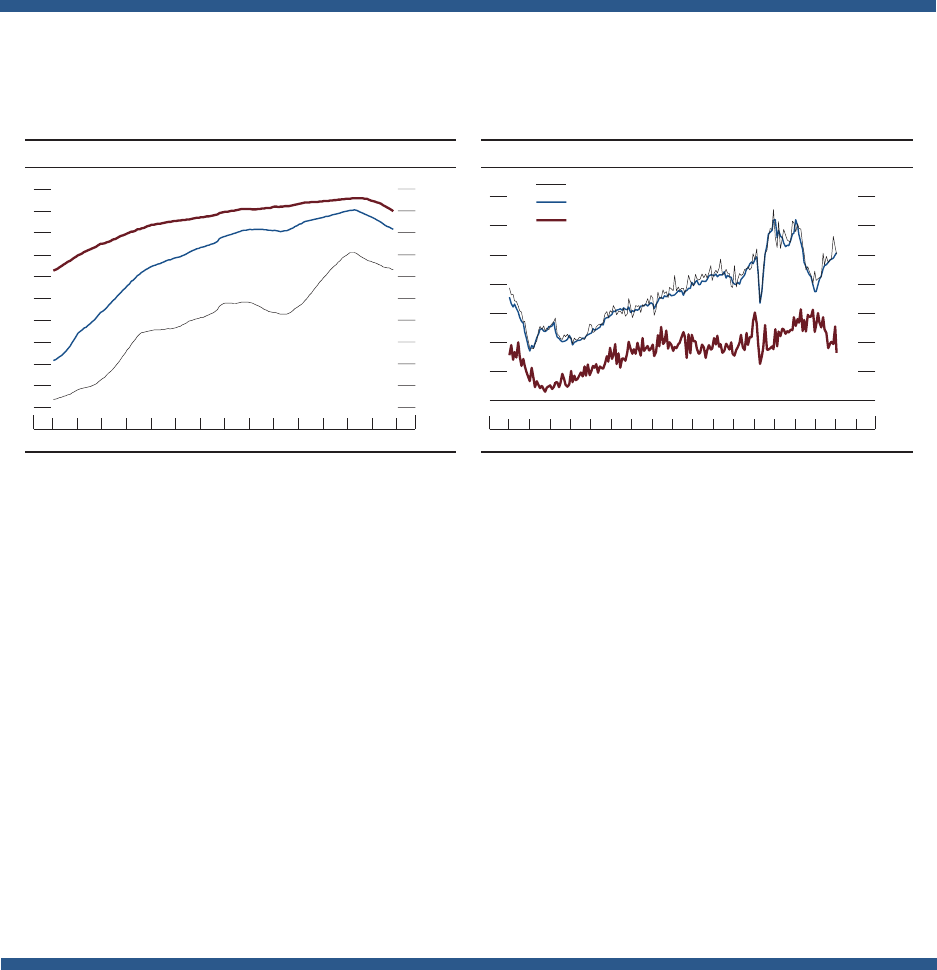
MONETARY POLICY REPORT: MARCH 2024 21
Single-family permits
Multifamily starts
0
.2
.4
.6
.8
1.0
1.2
1.4
Millions of units, annual rate
202420222020201820162014201220102008
F. Private housing starts and permits
Monthly
S
OURCE
: U.S. Census Bureau via Haver Analytics.
Single-family starts
properties remained strong through 2022 even as
single-family construction declined sharply. Unlike the
cost of buying a home, rental demand is not directly
harmed by higher mortgage rates and may even be
supported, to some extent, by a shift away from home
purchases as rates rise. Multifamily projects also take
signi cantly longer to plan and build than single-family
projects and are slower to react to changing economic
conditions. Over the past year, we have seen more new
properties delivered to the market, which contributed to
increases in multifamily vacancy rates and a signi cant
deceleration in market rents. These developments,
combined with concerns about the effect of the large
amount of new supply still scheduled to be delivered to
market over the next year, have started to drive down
prices of existing multifamily properties. As a result,
the rate of new multifamily construction has come
back down over the past year even as single-family
construction has picked back up.
signi cant incentives while still maintaining positive
pro t margins. The relative strength in the new home
demand has encouraged builders to increase the rate
of new construction after having sharply pulled back in
2022 when rates rst started to rise ( gureF).
The balance between supply and demand in the
multifamily market—which is dominated by rental
units—is fundamentally different from that in the
single-family market. Initially, as the pandemic eased,
market rents surged along with single-family home
prices in response to the increased demand for living
space, whether owned or rented. These higher rents
encouraged a dramatic increase in multifamily starts
from what were already quite strong historical levels,
averaging 510,000 units per year in 2021 and 2022,
compared with an average of 314,000 units per year
from 2000 to 2020. Construction of multifamily
Below 5 percent
Below 6 percent
0
10
20
30
40
50
60
70
80
90
100
Percent
2023202120192017201520132011
E. Distribution of interest rates on outstanding mortgages
Monthly
Below 4 percent
N
OTE
: The data extend through November 2023. The sample only
includes outstanding mortgages current on their payments.
S
OURCE
: Black Knight McDash.
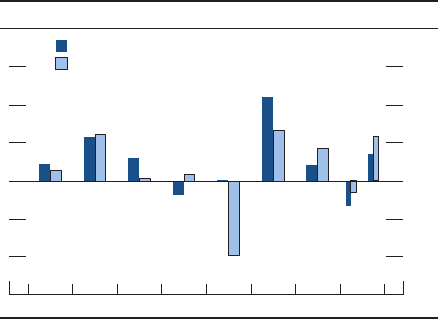
22 PART 1: RECENT ECONOMIC AND FINANCIAL DEVELOPMENTS
Business nancing conditions were
moderately restrictive overall, but credit
remained generally available
Credit remained generally available to most
nonnancial corporations but at elevated
interest rates and amid moderately restrictive
nancial conditions overall. Banks continued
to tighten lending standards for all loan
types over the second half of last year, and
business loan growth at banks continued
to slow. In contrast, issuance of corporate
bonds remained solid across credit categories,
although well below the levels prevailing at the
beginning of the tightening cycle.
For small businesses, which are more reliant
on bank nancing than large businesses, credit
conditions tightened further over the second
half of last year. Surveys indicate that credit
supply for small businesses has tightened
further, and interest rates on loans to small
businesses moved higher and now stand near
the top of the range observed since 2008.
Loan default and delinquency rates have also
increased and now slightly exceed their pre-
pandemic rates.
Trade recovered in the second half
of2023
Real imports remained relatively unchanged
for the year as a whole after declining in the
rst half of last year and then recovering over
the second half as domestic demand picked up
(gure24). Despite lackluster foreign growth,
exports picked up more strongly than imports
over the second half of the year. As such, net
exports added about 0.3percentage point to
GDP growth in the fourth quarter of 2023
after being neutral for growth in the previous
two quarters. The current account decit
narrowed slightly in the third quarter of 2023
to 2.9percent of GDP, remaining larger than
before the pandemic.
Federal scal policy actions were roughly
neutral for GDP growth in 2023
Federal purchases grew modestly in 2023, and
several recently enacted policies began to boost
10
5
+
_
0
5
10
15
Percent, annual rate
20232022202120202019201820172016
24. Change in real imports and exports of goods
and services
H1
H2
S
OURCE
: Bureau of Economic Analysis via Haver Analytics.
Imports
Exports
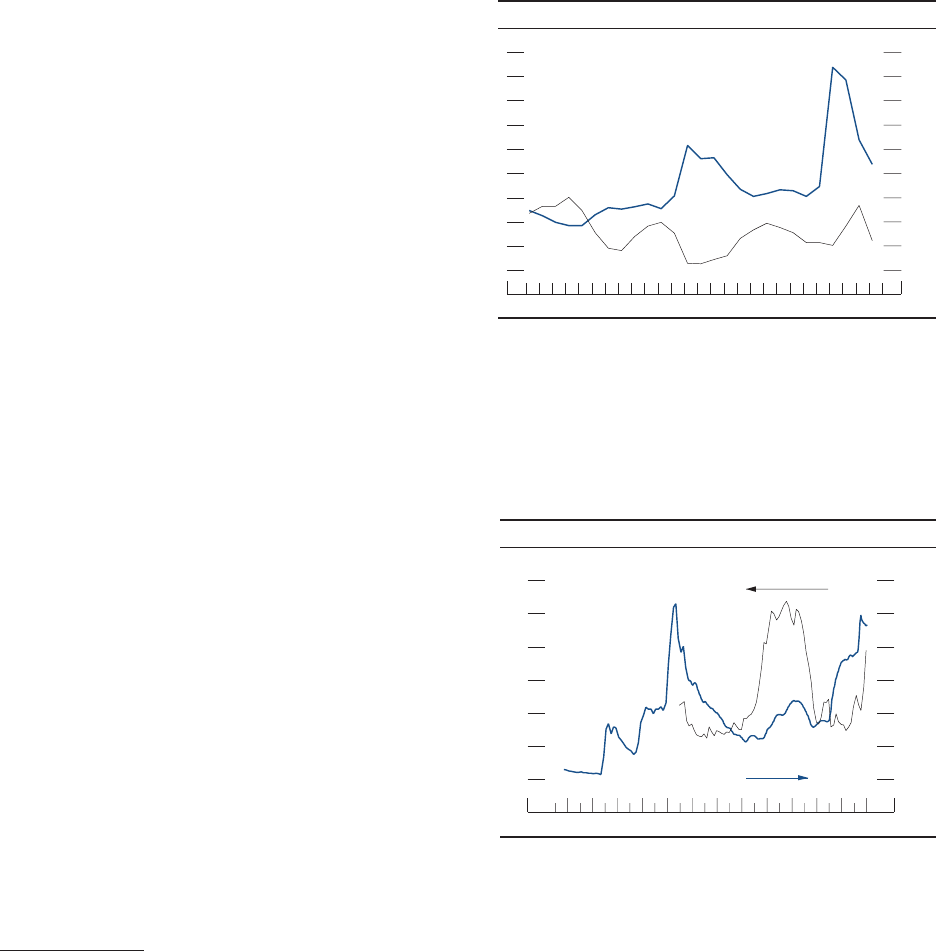
MONETARY POLICY REPORT: MARCH 2024 23
investment and consumption. This support
to economic activity was about oset by the
unwinding of the remaining pandemic-related
scal policy support. All told, the contribution
of discretionary changes in federal scal policy
to real GDP growth was roughly neutral
lastyear.
The budget decit and federal debt
remain elevated
After surging to 15percent of GDP in scal
year 2020, the budget decit declined through
2022 as the imprint of the pandemic faded
(gure25). The budget decit edged up to
6.3percent of GDP in scal 2023 as tax
receipts declined from their elevated level in
2022 and net interest outlays increased.
6
As a result of the unprecedented scal
support enacted early in the pandemic, federal
debt held by the public jumped roughly
20percentage points to 100percent of GDP
in scal 2020—the highest debt-to-GDP ratio
since 1947 (gure26). After falling slightly
through 2022, the debt-to-GDP ratio edged up
in 2023, as rising interest rates contributed to
higher net interest outlays. The Congressional
Budget Oce projects that further increases
in interest costs, along with positive primary
decits—that is, total decits less interest
payments—will produce a steady rise in the
debt-to-GDP ratio in the years to come.
Most state and local government budget
positions remained strong . . .
Federal policymakers provided a historically
high level of scal support to state and local
governments during the pandemic; this aid,
together with robust state tax collections in
2021 and 2022, left the sector in a strong
6. The growth of the decit between scal years 2022
and 2023 would have been larger had it not been for the
Administration’s announced student debt relief program,
which raised the scal 2022 decit $380billion, and the
Supreme Court’s reversal of the policy, which lowered it
$330billion in scal 2023.
Expenditures
14
16
18
20
22
24
26
28
30
32
Percent of nominal GDP
202320202017201420112008200520021999
Annual
25. Federal receipts and expenditures
Receipts
N
OTE: The receipts and expenditures data are on a unied-budget
basis and are for scal years (October through September); gross
domestic product (GDP) data are on a 4-quarter basis ending in Q3.
S
OURCE: Department of the Treasury, Financial Management Service;
Oce of Management and Budget and Bureau of Economic Analysis via
Haver Analytics.
Debt held by
the public
0
20
40
60
80
100
120
Percent of nominal GDP
.5
1.0
1.5
2.0
2.5
3.0
3.5
26. Federal government debt and net interest outlays
Percent of nominal GDP
1903 1923 1943 1963 1983 2003 2023
Net interest outlays
on federal debt
N
OTE
: The data for net interest outlays are annual, begin in 1948, and
extend through 2023. Net interest outlays are the cost of servicing the
debt held by the public. Federal debt held by the public equals federal
debt less Treasury securities held in federal employee dened-benet
retirement accounts, evaluated at the end of the quarter. The data for
federal debt are annual from 1901 to 1951 and a 4-quarter moving
average thereafter and extend through 2023:Q3. GDP is gross d
omestic
product.
S
OURCE
: For GDP, Bureau of Economic Analysis via Haver
Analytics; for federal debt, Congressional Budget Oce and Federal
Reserve Board, Statistical Release Z.1, “Financial Accounts of the
United States.”
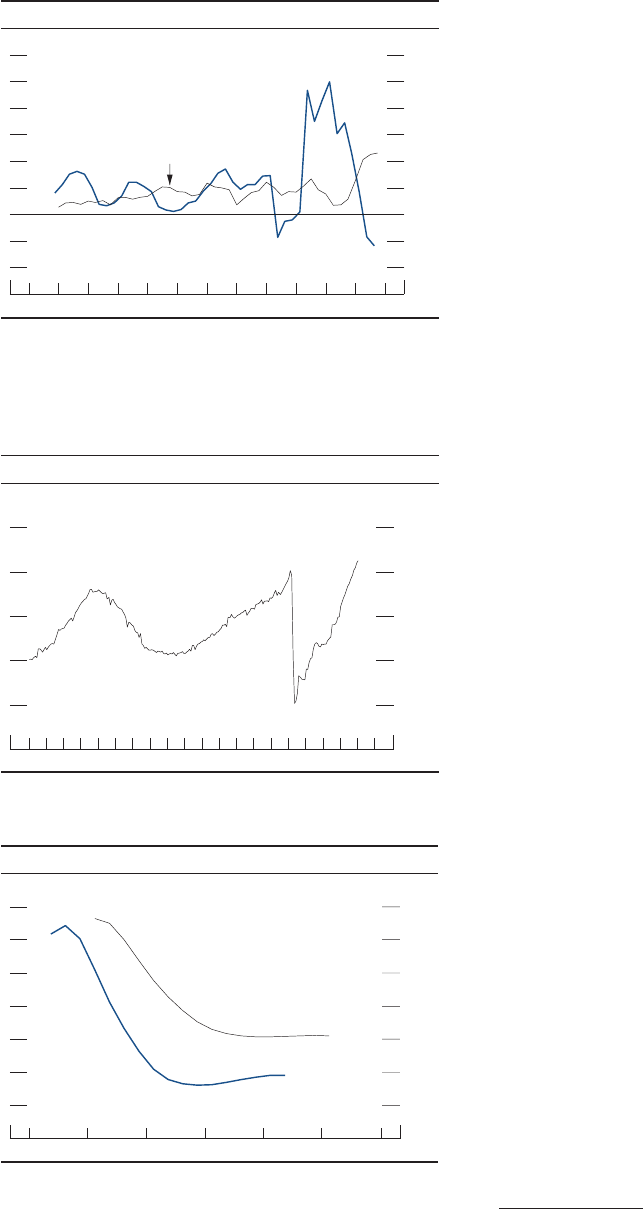
24 PART 1: RECENT ECONOMIC AND FINANCIAL DEVELOPMENTS
budget position overall (gure27). Although
state tax revenues weakened in 2023—mainly
reecting a normalization of receipts from
elevated levels in the previous year as well
as the eects of recently enacted tax cuts
in some states—taxes as a percentage of
GDP remained above recent historical
norms. Moreover, states’ total balances (that
is, including rainy day fund balances and
previous-year surplus funds) continued to
be near all-time highs. Nevertheless, budget
situations varied widely across the states, with
some states—particularly those that depend
heavily on capital gains tax collections—facing
tighter budget conditions. At the local level,
overall property tax receipts rose briskly
in2023.
. . . contributing to brisk growth in
employment and construction spending
Employment in state and local governments
rose strongly in 2023, as some pandemic-
related headwinds, such as an increase in
retirements, have abated and wages became
more competitive relative to those in the
private sector (gure28). Similarly, real
construction outlays grew rapidly, reecting
easing bottlenecks and support from federal
grants. By the end of 2023, both employment
and construction spending were roughly back
to their pre-pandemic levels.
Financial Developments
The expected level of the federal funds
rate over the next few years is now higher
than it was last June on net
Market-based measures of the expected federal
funds rate rose considerably over the summer
and early fall before moving down toward the
end of 2023. On net, the market-implied policy
rate path rose notably for year-end 2024, and
somewhat more modestly for year-end 2025
and 2026 (gure29).
7
Financial market prices
imply that the federal funds rate will decline
7. These measures are based on market prices for
overnight index swaps for the eective federal funds rate
and are not adjusted for term premiums.
18.5
19.0
19.5
20.0
20.5
Millions of jobs
2024202220202018201620142012201020082006
Monthly
28. State and local government payroll employment
S
OURCE
: Bureau of Labor Statistics via Haver Analytics.
June 1, 2023
2.5
3.0
3.5
4.0
4.5
5.0
5.5
Percent
202820272026202520242023
29. Market-implied federal funds rate path
Quarterly
February 27, 2024
N
OTE
: The federal funds rate path is implied by quotes on overnight
index swaps—a derivative contract tied to the eective federal funds rate.
The implied path as of June 1, 2023, is compared with that as of
February 27, 2024. The path is estimated with a spline approach,
assuming a term premium of 0 basis points. The June 1, 2023, path
extends through 2027:Q2 and the February 27, 2024, path through
2028:Q1.
S
OURCE
: Bloomberg; Federal Reserve Board sta estimates.
Total state taxes
10
5
+
_
0
5
10
15
20
25
30
Percent change from year earlier
202320212019201720152013
27. State and local tax receipts
Quarterly
N
OTE
: Receipts shown are year-over-year percent changes of 4-quarter
moving averages, begin in 2012:Q4, and extend through 2023:Q3.
Property taxes are primarily collected by local governments.
S
OURCE
: U.S. Census Bureau, Quarterly Summary of State and Loca
l
Government Tax Revenue.
Property taxes
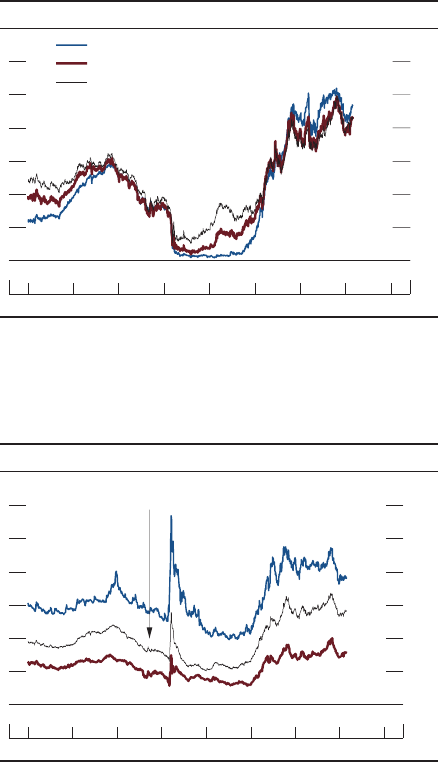
MONETARY POLICY REPORT: MARCH 2024 25
from current levels following the March2024
FOMC meeting, reaching about 4.6percent
and about 3.7percent by year-end 2024
and year-end 2025, respectively. Consistent
with these market-implied measures, survey
respondents in the Blue Chip Financial
Forecasts published at the beginning of
February expect the policy rate to begin to
decrease in the second quarter of 2024 and
reach 4.4percent by year-end 2024. On net,
respondents have signicantly revised upward
their expectations of the federal funds rate
path since last June’s survey.
Yields on long-term U.S. nominal Treasury
securities uctuated considerably
Yields on long-term nominal Treasury
securities began to increase in the spring of
2023 and rose markedly through mid-October
before reversing course sharply, with the
10-year Treasury yield reaching a peak of
about 5percent before falling to just below
4percent by the end of last year (gure30).
So far this year, long-term nominal Treasury
yields have increased, with the 10-year
Treasury yield rising to about 4.4percent by
late February. In contrast, short-term Treasury
yields have been little changed, on net, since
early June.
Yields on other long-term debt uctuated
with Treasury yields
Corporate bond yields declined across credit
categories since June, on net, amid sizable
uctuations that accompanied the observed
large movements in long-term Treasury
yields (gure31). Spreads on corporate
bonds over comparable-maturity Treasury
securities narrowed notably, on net, especially
for speculative-grade bonds, to levels in the
lower range of their historical distributions.
Similarly, municipal bond spreads over
comparable-maturity Treasury securities
narrowed substantially since June and are
now fairly low relative to their historical
distributions across credit ratings. Overall,
corporate and municipal credit quality
remained solid, with a low volume of defaults
in both markets despite some increase in
corporate bond defaults.
2-year
5-year
0
1
2
3
4
5
6
Percent
20242023202220212020201920182017
30. Yields on nominal Treasury securities
Daily
S
OURCE
: Department of the Treasury via Haver Analytics.
10-year
High-yield corporate
Municipal
0
2
4
6
8
10
12
Percent
20242023202220212020201920182017
31. Corporate bond yields, by securities rating, and
municipal bond yield
Daily
Investment-grade corporate
N
OTE: Investment-grade corporate reects the eective yield of the
ICE Bank of America Merrill Lynch (BofAML) triple-B U.S.
Corporate
Index (C0A4). High-yield corporate reects the eective yield of the ICE
BofAML High Yield Index (H0A0). Municipal reects the yield to worst
of the ICE BofAML U.S. Municipal Securities Index (U0A0).
SOURCE: ICE Data Indices, LLC, used with permission.
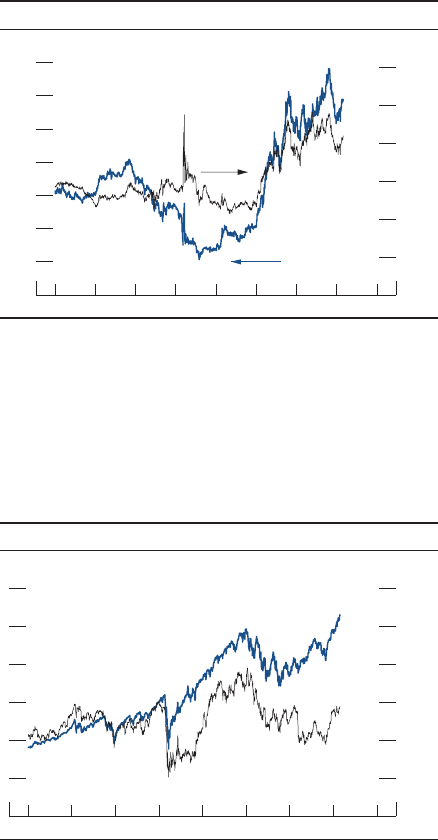
26 PART 1: RECENT ECONOMIC AND FINANCIAL DEVELOPMENTS
Yields on agency mortgage-backed securities
(MBS)—an important pricing factor for home
mortgage interest rates—rose notably over the
summer before falling back down toward the
end of last year (gure32). So far this year,
yields on agency MBS have increased, standing
in late February at levels notably above those
in June2023. The MBS spread decreased
slightly since June, on net, but remained
elevated relative to pre-pandemic levels, at least
partly due to high interest rate volatility, which
reduces the value of holding MBS.
Broad equity price indexes increased
The S&P 500 index increased signicantly
since June, on net, above the record-high levels
seen at the end of 2021 (gure33). Following
a substantial decline over late summer and
early fall, the S&P 500 index recovered
toward the end of the year, as long-term
interest rates declined, and continued to rise
over the start of 2024. Meanwhile, small-cap
rms, whose equity prices have signicantly
underperformed broad equity indexes,
experienced substantial increases in their
equity valuations in recent months amid better
economic prospects, including expectations of
a less restrictive monetary policy. Bank equity
prices rose, on net, retracing some of the
declines that had occurred over the rst half of
2023 and that had been associated with strains
in the banking sector. In the case of the largest
banks, equity prices rose above their early-2023
levels; regional bank equity prices had only
a partial retracement. One-month option-
implied volatility on the S&P 500 index—
theVIX—increased moderately until late
October but subsequently declined to reach
levels somewhat lower than those prevailing
in early June. (For a discussion of nancial
stability issues, see the box “Developments
Related to Financial Stability.”)
Yield
0
50
100
150
200
250
Basis points
1
2
3
4
5
6
7
20242023202220212020201920182017
32. Yield and spread on agency mortgage-backed
securities
Percent
Spread
N
OTE: The data are daily. Yield shown is for the uniform
mortgage-backed securities 30-year current coupon, the coupon rate at
which new mortgage-backed securities would be priced at par, or face,
value for dates after May 31, 2019; for earlier dates, the yield shown is for
the Fannie Mae 30-year current coupon. Spread shown is to the average
of the 5-year and 10-year nominal Treasury yields.
S
OURCE: Department of the Treasury; J.P. Morgan. Courtesy of J.P.
Morgan Chase & Co., Copyright 2024.
S&P 500 index
50
75
100
125
150
175
December 31, 2019 = 100
20242023202220212020201920182017
33. Equity prices
Daily
Dow Jones bank index
S
OURCE: S&P Dow Jones Indices LLC via Bloomberg. (For Dow
Jones Indices licensing information, see the note on the Contents page.)
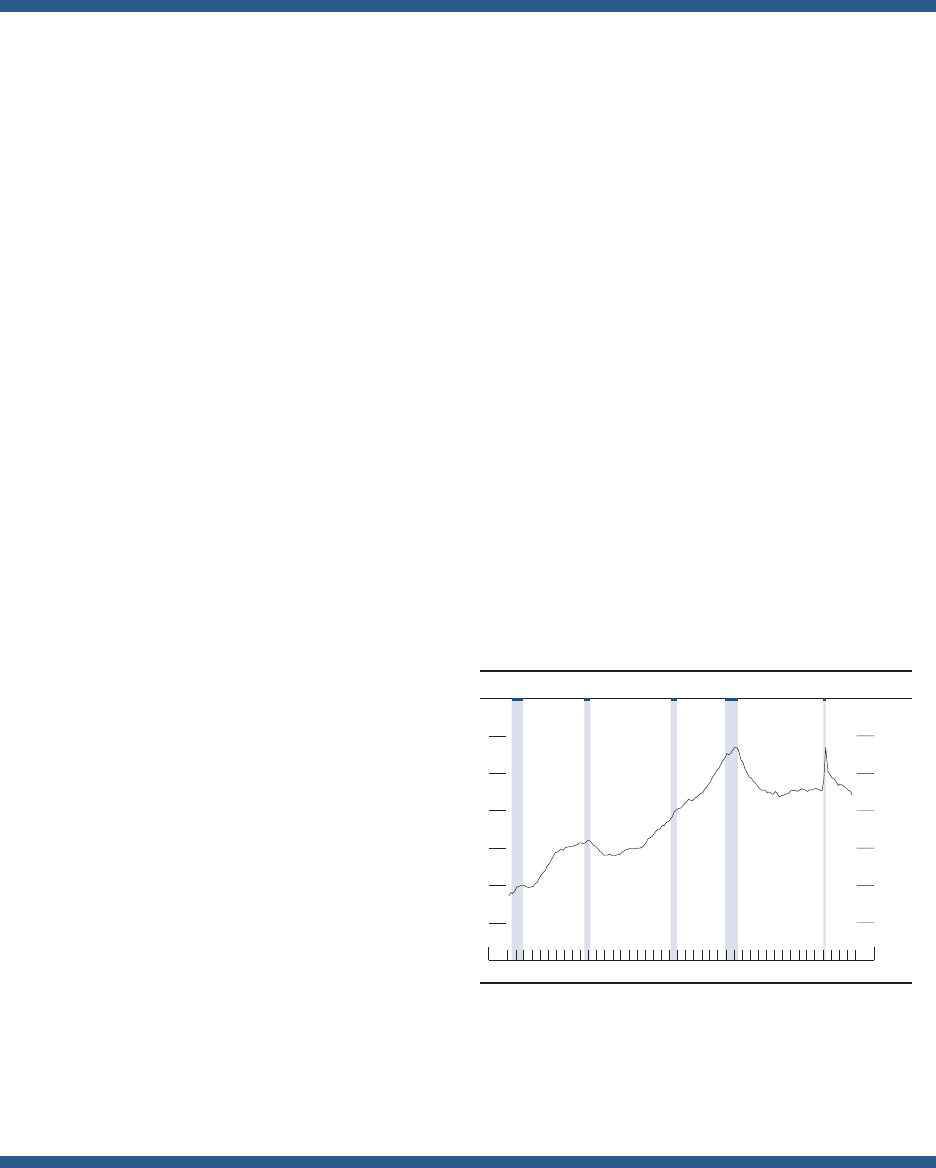
MONETARY POLICY REPORT: MARCH 2024 27
non nancial businesses by private credit funds and
other private investors has been growing rapidly. While
risks from leverage and investor redemption appear
limited, the sector remains opaque, making it dif cult
to assess vulnerabilities.
Vulnerabilities in the nancial sector remain
notable, as losses in the fair value of long-dated bank
assets remain signi cant. Risk-based capital ratios
increased broadly across all bank categories and sit
well above regulatory minimums, driven both by robust
bank pro tability and by a decrease in shareholder
payouts at the largest banks. Credit quality at banks
remained strong, although the quality of CRE loans
backed by of ce, retail, and multifamily buildings
continued its decline, a result of the lower demand
for downtown real estate prompted by the shift toward
telework. Some smaller regional and community banks
with high concentrations of CRE loans are also highly
reliant on uninsured deposits, potentially compounding
vulnerabilities. Leverage at hedge funds stabilized
at a high level as the Treasury cash–futures basis
This discussion reviews vulnerabilities in the U.S.
nancial system. The framework used by the Federal
Reserve Board for assessing the resilience of the U.S.
nancial system focuses on nancial vulnerabilities
in four broad areas: asset valuations, business and
household debt, leverage in the nancial sector, and
funding risks. Acute stress in the banking system has
receded since last spring, and banks’ regulatory risk-
based capital ratios remained solid and increased
broadly, as bank pro ts were robust and banks reduced
capital distributions. Nonetheless, declines in the
fair value of xed-rate assets at some banks have
been sizable relative to regulatory capital. Valuation
pressures increased modestly, with equity markets close
to all-time highs in real terms and real estate prices still
high relative to fundamentals. Credit to non nancial
businesses and households continued to decrease
relative to gross domestic product (GDP), and this ratio
now sits close to its 20-year low. However, funding
vulnerabilities remain notable. Hedge fund leverage
is elevated, partly due to elevated activity in the cash–
futures basis trade.
Broad equity prices are now at levels close to
historical highs, driven mostly by performance of the
largest companies. Nominal long-term Treasury yields
rose to a 15-year peak in October but have now fallen
to levels close to those from a year ago. Commercial
real estate (CRE) prices continued to decline, especially
in the of ce, retail, and multifamily sectors, and
low levels of transactions in the of ce sector likely
indicated that prices had not yet fully re ected the
sector’s weaker fundamentals. Prices of single-family
residential properties, which held steady through the
rst quarter of 2023, have started rising again, albeit
modestly, and remain high relative to market rents.
Vulnerabilities arising from household and
non nancial business leverage remain moderate. The
combined debt of both sectors as a share of GDP sat
close to its lowest level in 20years and continues to
decrease ( gure A). In the household sector, balance
sheets remain strong, and homeowners’ equity shares
of houses are now at their highest levels in at least
30years. Non nancial businesses’ ability to service
debt also remains adequate, as the pass-through of
higher policy rates has so far been muted by the large
share of long-term xed-rate debt. Direct lending to
Developments Related to Financial Stability
(continued on next page)
.8
1.0
1.2
1.4
1.6
1.8
Ratio
2023201620092002199519881981
A. Private nonnancial-sector credit-to-GDP ratio
Quarterly
NOTE:Data extend through 2023:Q3. The shaded bars with top cap
s
indicate periods of business recession as dened by the National
Bureau
of Economic Research: July 1981 to November 1982, July 1990 to Marc
h
1991, March 2001 to November 2001, December 2007 to June 2009, an
d
February 2020 to April 2020. GDP is gross domestic product.
S
OURCE: Federal Reserve Board, Statistical Release Z.1, “Financia
l
Accounts of the United States”; Bureau of Economic Analysis,
national
income and product accounts; Federal Reserve Board sta calculations.

28 PART 1: RECENT ECONOMIC AND FINANCIAL DEVELOPMENTS
second half of 2023, mostly because of increases in
retail prime funds.
A routine survey of market contacts on salient
shocks to nancial stability highlights several important
risks. Adverse developments in longer-term interest
rates could potentially strain credit supply in vulnerable
sectors. A related risk, the reemergence of banking-
sector stress at some institutions, might further constrain
the supply of credit, particularly at banks with large
CRE concentration and a high fraction of uninsured
deposits. Geopolitical risks remain salient, including
Russia’s war against Ukraine and potential spillovers of
the Israel–Hamas war, and could cause strains in parts
of the U.S. nancial system.
Developments Related to Financial Stability (continued)
trade continued to grow, suggesting a risk of sudden
deleveraging if volatility in Treasury markets increases
unexpectedly. Leverage at life insurers also increased,
although to levels near the middle of its historical
distribution.
In terms of funding risks, liquidity remains ample,
and deposits have stabilized recently. The number of
banks with large declines in fair value relative to their
regulatory capital and heavy reliance on uninsured
deposits has declined signi cantly since March2023.
Overall, banks’ reliance on short-term wholesale
funding remained much lower than the typical range
before the banking reforms of the previous decade.
Money market funds continued to grow throughout the
MONETARY POLICY REPORT: MARCH 2024 29
Major asset markets functioned in
an orderly way, but liquidity has
remainedlow
Treasury securities market functioning
has continued to be orderly, but liquidity
remained low by historical standards. The
persistence of low liquidity is broadly in line
with enduring high interest rate volatility, as
future economic conditions and the policy
rate path remain particularly uncertain.
Market depth—a measure of the availability
of contracts at the best quoted prices—for
Treasury securities remains near historically
low levels, particularly in the case of short-
term Treasury securities. With regard to
liquidity in the equity market, market depth
based on S&P500 futures was little changed
and remained somewhat low compared with
pre-COVID levels. Corporate and municipal
secondary bond markets continued to function
well; transaction costs in these markets were
fairly low by historical standards.
Short-term funding market conditions
remained stable
Conditions in overnight bank funding and
repurchase agreement (repo) markets remained
stable. Since June, the eective federal
funds rate and other unsecured overnight
rates have been a few basis points below
the interest rate on reserve balances, while
the Secured Overnight Financing Rate has
been at or slightly above the oering rate on
the overnight reverse repurchase agreement
(ON RRP) facility. Take-up at the ONRRP
facility has declined substantially since June.
This decline reects a signicant increase in
the net supply of Treasury bills and relatively
more attractive rates on alternative short-term
investments such as private repo.
Money market funds (MMFs), the largest
investors in the ON RRP facility, accounted
for much of the decline in ON RRP take-up as
they made a substantial reallocation of their
investments toward Treasury bills and private
repo. Both prime and government MMFs
have seen a notable increase in assets under
management since June, as relatively favorable
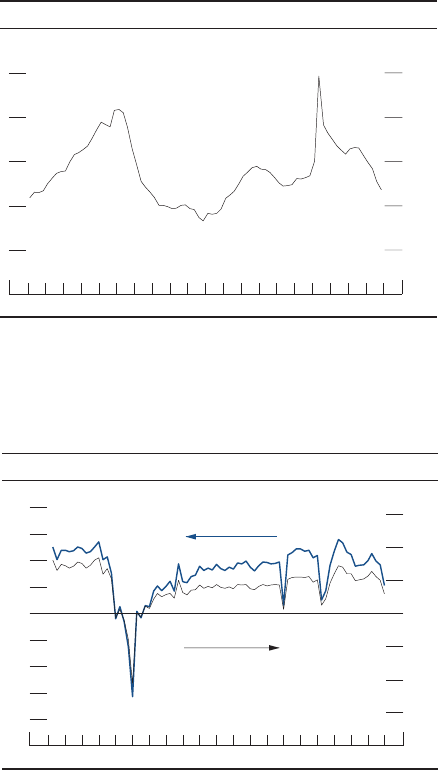
30 PART 1: RECENT ECONOMIC AND FINANCIAL DEVELOPMENTS
yields continue to attract funds previously
held on deposit in the banking sector.
Weighted average maturities at both prime and
government MMFs increased in anticipation
of fewer policy rate increases.
Bank credit growth continued to slow
over the second half of 2023
The slowdown in bank credit growth was
broad based, with growth in outstanding
balances for all major loan categories slowing
from earlier in the year, likely reecting
the eects of higher interest rates, tighter
credit availability, and economic uncertainty
(gure34). Banks in the Senior Loan Ocer
Opinion Survey on Bank Lending Practices
reported tighter standards and weaker demand
over the third and fourth quarters, continuing
trends for standards and demand that have
been reported since the middle of 2022.
Delinquency rates on bank loans generally
rose in the second half of 2023—with the
largest increases for commercial real estate
and consumer loans—but remained around
ranges observed before the pandemic except
for consumer loans. Bank protability moved
down in the second half of 2023 to levels
below those that prevailed before the pandemic
(gure35).
International Developments
Foreign economic growth slowed in the
second half of 2023
Following a rebound in early 2023, foreign
activity was subdued overall in the second
half of last year, although with some variation
across countries. In advanced foreign
economies (AFEs), several factors restrained
growth, including the tightening of monetary
policy over the past two years—which weighed
on credit growth and investment—and an
erosion of real household incomes amid
high ination rates. In Europe, ongoing
structural adjustment to higher energy prices
also continued to hinder the performance of
energy-intensive sectors. Economic indicators
point to continued weakness in AFE growth in
early 2024.
Return on assets
30
20
10
+
_
0
10
20
30
Percent, annual rate
2.0
1.5
1.0
.5
+
_
0
.5
1.0
1.5
2.0
2005 2008 2011 2014 2017 2020 2023
35. Protability of bank holding companies
Percent, annual rate
Return on equity
N
OTE
:The data are quarterly.
S
OURCE: Federal Reserve Board, Form FR Y-9C, Consolidated
Financial Statements for Holding Companies.
55
60
65
70
75
Percent
2023202020172014201120082005
34. Ratio of total commercial bank credit to nominal
gross domestic product
Quarterly
S
OURCE
: Federal Reserve Board, Statistical Release H.8, “Assets and
Liabilities of Commercial Banks in the United States”; Bureau o
f
Economic Analysis via Haver Analytics.
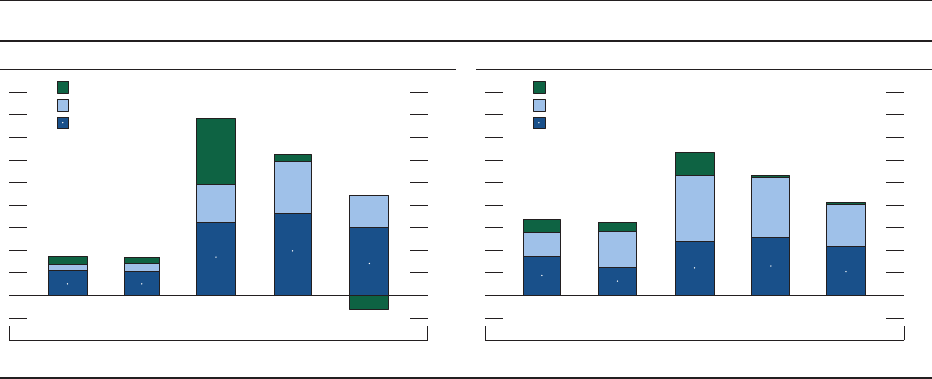
MONETARY POLICY REPORT: MARCH 2024 31
In China, a post-pandemic boost to economic
growth early in 2023 faded by the second
quarter, and property-sector weakness and
sluggish domestic demand have remained
a constraint on economic activity. Policy
stimulus targeting infrastructure and
manufacturing investment bolstered Chinese
growth in the second half of the year, enabling
the government to meet its 2023 growth target.
In emerging market economies (EMEs)
other than China, economic activity slowed
in the second half of last year but was more
resilient overall than in the AFEs. Industrial
production in emerging Asia excluding China
began recovering, supported by a rebound in
global demand for high-tech products that was
driven in part by the articial intelligence and
electric vehicle sectors.
Ination abroad has continued to ease
but remains elevated
Foreign headline ination has continued to
decline since the middle of last year, reecting
lower core and food ination (gure36).
Both the subsiding eects of past global
supply bottlenecks and the drag on demand
from monetary policy tightening have eased
1
+
_
0
1
2
3
4
5
6
7
8
9
Percent
2017–19
avg.
2020–21
avg.
2022 2023:H1 2023:H2
Advanced foreign economies
NOTE: The advanced foreign economy aggregate is the average of Canada, the euro area, and the U.K., weighted by shares of U.S. non-oil good
s
imports.
The emerging market economy aggregate is the average of Argentina, Brazil, Chile, Colombia, Hong Kong, India, Indonesia, Israel, Malaysia
,
Mexico,
the Philippines, Russia, Saudi Arabia, Singapore, South Korea, Taiwan, Thailand, and Vietnam, weighted by shares of U.S. non-oil good
s
imports,
and begins in 2017:Q2. The ination measure is the Harmonised Index of Consumer Prices for the euro area and the consumer price index
for
other economies. The data show percent changes from year-ago levels.
S
OURCE: Federal Reserve Board sta calculations; Haver Analytics.
Energy
Food
Core
1
+
_
0
1
2
3
4
5
6
7
8
9
Percent
2017–19
avg.
2020–21
avg.
2022 2023:H12023:H2
Emerging market economies
Energy
Food
Core
36. Components of foreign consumer price ination
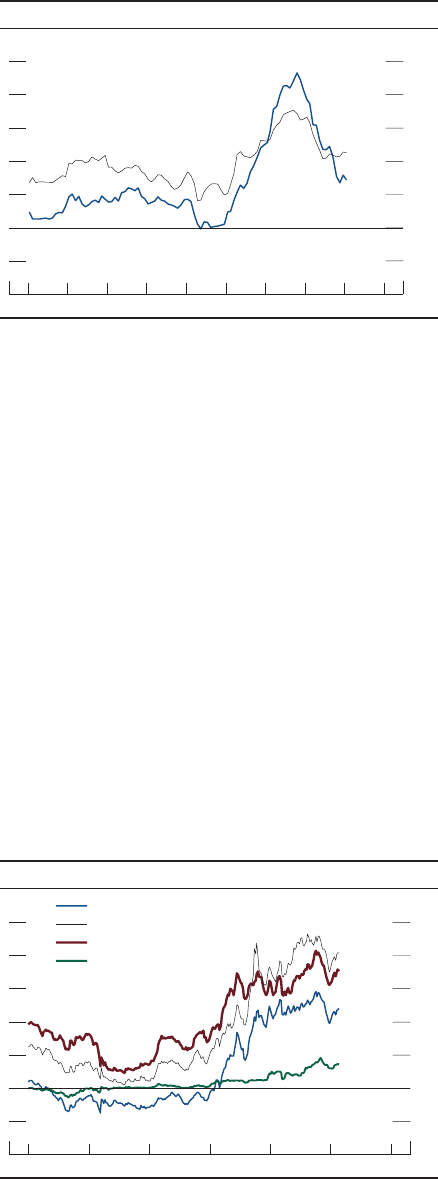
32 PART 1: RECENT ECONOMIC AND FINANCIAL DEVELOPMENTS
inationary pressures (gure37). However, the
pace of disination has varied across sectors
and countries. The deceleration in goods
prices abroad has generally outpaced that in
services prices, as in the U.S. Ination remains
above target in Europe but has been running
near zero in China. Although the are-up in
geopolitical tensions in the Middle East and
accompanying disruptions to shipping through
the Red Sea have had only limited eects on
consumer prices in general and on global
energy prices in particular, further escalation
in tensions could disrupt global momentum
toward restoring lower ination.
Foreign central banks are maintaining a
restrictive monetary policy stance
Most foreign central banks paused their
interest rate hikes in the second half of last
year and have since held policy rates steady,
acknowledging the cumulative tightening
of policy and progress in lowering ination.
Policy rate paths implied by nancial market
pricing suggest that many AFE central banks
are expected to begin reducing interest rates in
2024. Several EME central banks have already
begun easing monetary policy. However,
foreign central banks have generally continued
to emphasize in their communications that
progress toward achieving their ination goals
could slow or even reverse, including from
resilience in labor markets, wage growth, or
geopolitical developments leading to higher
commodity prices and trade costs.
Financial conditions abroad have been
volatile but have eased, on balance,
since mid-2023
Near-dated AFE sovereign yields declined
toward the end of last year as central banks
signaled they had reached or neared the end of
policy rate tightening. Longer-term sovereign
yields unwound most of the increase registered
earlier in 2023 (gure38). One exception was
Japan, where the central bank widened the
band around its yield curve control target,
allowing yields on 10-year government
securities to increase, on net, in 2023.
Germany
Japan
Canada
1
+
_
0
1
2
3
4
5
Percent
2019 2020 2021 2022 2023 2024
38. Nominal 10-year government bond yields in
selected advanced foreign economies
Weekly
N
OTE
: The data are weekly averages of daily benchmark yields and
extend through February 23, 2024.
S
OURCE
: Bloomberg.
U.K.
AFEs ex. Japan
2
+
_
0
2
4
6
8
10
Percent change from year earlier
2016 2017 2018 2019 2020 2021 2022 2023 2024
37. Consumer price ination in foreign economies
Monthly
EMEs ex. China
N
OTE: The advanced foreign economy (AFE) aggregate is the average
of Canada, the euro area, and the U.K., weighted by shares of U.S.
non-oil goods imports. The emerging market economy (EME) aggregate
is the average of Argentina, Brazil, Chile, Colombia, Hong Kong,
India,
Indonesia, Israel, Malaysia, Mexico, the Philippines, Russia, Saudi
Arabia, Singapore, South Korea, Taiwan, Thailand, and Vietnam,
weighted by shares of U.S. non-oil goods imports. The ination measure
is the Harmonised Index of Consumer Prices for the euro area and the
consumer price index for other economies.
S
OURCE
: Federal Reserve Board sta calculations; Haver Analytics.

MONETARY POLICY REPORT: MARCH 2024 33
Since mid-2023, the broad dollar index—a
measure of the exchange value of the
dollar against a trade-weighted basket of
foreign currencies—increased slightly on net
(gure39). The dollar index was volatile,
increasing signicantly as U.S. yields rose from
July to October and then reversing most of
these increases as U.S. yields declined.
Many major foreign equity indexes rose across
AFEs and EMEs, although gains were near
zero in the U.K., consistent with stagnant
economic activity (gure40). Chinese equity
prices were an exception, with declines amid
pessimism about growth prospects and a
pullback by foreign investors from Chinese
markets. Flows to EME-focused investment
funds turned negative in mid-2023, as yields
on advanced-economy bonds rose more than
those in emerging economies. These outows
eased toward the end of the year as AFE
yields fell. EME sovereign spreads narrowed
moderately last year.
75
80
85
90
95
100
105
110
115
Week ending December 27, 2019 = 100
2014 2016 2018 2020 2022 2024
39. U.S. dollar exchange rate index
Weekly
Dollar appreciation
N
OTE: The data, which are in foreign currency units per dollar, are
weekly averages of daily values of the broad dollar index and
extend
through February 23, 2024. As indicated by the arrow, increases in the
data reect U.S. dollar appreciation and decreases reect U.S. dollar
depreciation.
S
OURCE: Federal Reserve Board sta calculations; Federal Reserve
Board, Statistical Release H.10, “Foreign Exchange Rates.”
Japan
U.K.
Euro area
70
80
90
100
110
120
130
140
150
160
170
180
Week ending January 8, 2016 = 100
2016 2017 2018 2019 20202021202220232024
40. Equity indexes for selected foreign economies
Weekly
NOTE: The data are weekly averages of daily data and extend through
February 23, 2024.
S
OURCE: For the euro area, Dow Jones Euro Stoxx Index; for Japan
,
Tokyo Stock Price Index; for China, Shanghai Composite Index; for the
U.K., FTSE 100 Index; all via Bloomberg. (For Dow Jones Indices
licensing information, see the note on the Contents page.)
China
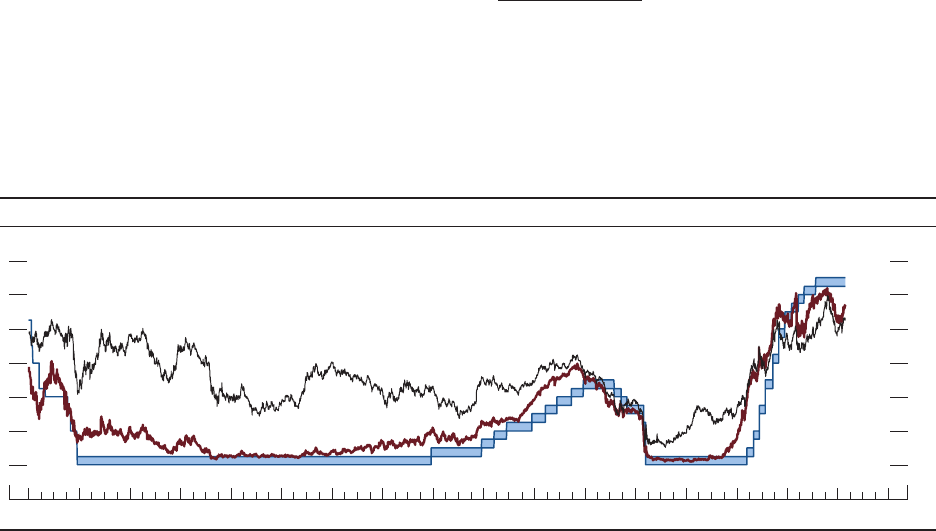
35
After one additional increase in July, the
Federal Open Market Committee has
held the federal funds rate steady . . .
The Federal Open Market Committee
(FOMC) has maintained the target range for
the federal funds rate at 5¼ to 5½percent
since its July2023 meeting (gure41). The
Committee views the policy rate as likely at
its peak for this tightening cycle; since early
2022, the FOMC raised the target range
a total of 525 basis points. The FOMC’s
policy tightening actions have reected its
commitment to return ination to its 2percent
objective. Restoring price stability is essential
to achieve a sustained period of strong labor
market conditions that benet all.
As labor market tightness has eased and
progress on ination has continued, the risks
to achieving the Committee’s employment and
ination goals have been moving into better
balance. Even so, the Committee remains
highly attentive to ination risks and is acutely
aware that high ination imposes signicant
hardship, especially on those least able to
meet the higher costs of essentials, like food,
housing, and transportation. In considering
any adjustments to the target range for the
federal funds rate, the Committee will carefully
assess incoming data, the evolving outlook,
and the balance of risks. The Committee does
not expect it will be appropriate to reduce
the target range until it has gained greater
condence that ination is moving sustainably
toward 2percent.
. . . and has continued the process of
signicantly reducing its holdings of
Treasury and agency securities
The FOMC began reducing its securities
holdings in June2022 and, since then,
has continued to implement its plan for
signicantly reducing the size of the Federal
Reserve’s balance sheet in a predictable
manner.
8
Since September2022, principal
payments from securities held in the System
8. See the May4, 2022, press release regarding the
Plans for Reducing the Size of the Federal Reserve’s
Balance Sheet, available on the Board’s website at https://
www.federalreserve.gov/newsevents/pressreleases/
monetary20220504b.htm.
Part 2
monetary PoLicy
Target federal funds rate
2-year Treasury rate
0
1
2
3
4
5
6
Percent
2008 2009 2010 2011 2012 2013 2014 2015 2016 2017 2018 2019 2020 2021 2022 2023 2024
41.
Selected interest rates
Daily
10-year Treasury rate
N
OTE
: The 2-year and 10-year Treasury rates are the constant-maturity yields based on the most actively traded securities.
S
OURCE
: Department of the Treasury; Federal Reserve Board.

36 PART 2: MONETARY POLICY
Open Market Account (SOMA) have been
reinvested only to the extent that they exceeded
monthly caps of $60billion per month for
Treasury securities and $35billion per month
for agency debt and agency mortgage-backed
securities. As a result of these actions, the
SOMA holdings of Treasury and agency
securities have declined about $1.4trillion
since the start of balance sheet reduction to
around $7.1trillion, a level equivalent to about
25percent of U.S. nominal gross domestic
product as compared with a peak of 35percent
reached at the end of 2021 (gure42). Despite
this decline in SOMA holdings, reserve
balances increased $217billion, to a level of
around $3.5trillion, as the corresponding
decline in the Federal Reserve’s liabilities
was concentrated in usage of the overnight
reverse repurchase agreement facility. (See the
box “Developments in the Federal Reserve’s
Balance Sheet and Money Markets.”)
The FOMC has stated that it intends to
maintain securities holdings at amounts
consistent with implementing monetary
policy eciently and eectively in its ample-
reserves regime. To ensure a smooth transition,
the FOMC intends to slow and then stop
reductions in its securities holdings when
reserve balances are somewhat above the level
that the FOMC judges to be consistent with
ample reserves. Once balance sheet runo has
ceased, reserve balances will likely continue
to decline at a slower pace—reecting growth
in other Federal Reserve liabilities—until
the FOMC judges that reserve balances are
at an ample level. Thereafter, the FOMC
will manage securities holdings as needed to
maintain ample reserves over time.
The FOMC will continue to monitor the
implications of incoming information for
the economic outlook
As already indicated, the FOMC is strongly
committed to returning ination to its
2percent objective, and, in considering any
adjustments to the target range for the federal
funds rate, the Committee will carefully assess
incoming data, the evolving outlook, and
the balance of risks. Its assessments will take
into account a wide range of information,
including readings on labor market conditions,
ination pressures and ination expectations,
9
6
3
+
_
0
3
6
9
Trillions of dollars
20242023202220212020201920182017201620152014201320122011201020092008
42. Federal Reserve assets and liabilities
Weekly
Other assets
Credit and liquidity facilities
Agency debt and mortgage-backed securities holdings
Treasury securities held outright
Federal Reserve notes in circulation
Deposits of depository institutions
Reverse repurchase agreements
Capital and other liabilities
N
OTE
: “Other assets” includes repurchase agreements, FIMA (Foreign and International Monetary Authorities) repurchase agreements, and unamortized
premiums and discounts on securities held outright. “Credit and liquidity facilities” consists of primary, secondary, and seasonal credit; term auction credit;
central bank liquidity swaps; support for Maiden Lane, Bear Stearns Companies, Inc., and AIG; and other credit and liquidity facilities, including the Primary
Dealer Credit Facility, the Asset-Backed Commercial Paper Money Market Mutual Fund Liquidity Facility, the Commercial Paper Funding Facility, the Term
Asset-Backed Securities Loan Facility, the Primary and Secondary Market Corporate Credit Facilities, the Paycheck Protection Program Liquidity Facility, the
Municipal Liquidity Facility, and the Main Street Lending Program. “Agency debt and mortgage-backed securities holdings” includes agency residential
mortgage-backed securities and agency commercial mortgage-backed securities. “Capital and other liabilities” includes the U.S. Treasury General Account and
the U.S. Treasury Supplementary Financing Account. The key identies shaded areas in order from top to bottom. The data extend through February 21, 2024.
S
OURCE
: Federal Reserve Board, Statistical Release H.4.1, “Factors Aecting Reserve Balances.”
MONETARY POLICY REPORT: MARCH 2024 37
and nancial and international developments.
The Committee has noted that it is also
prepared to adjust its approach to reducing the
size of the balance sheet in light of economic
and nancial developments.
In addition to considering a wide range of
economic and nancial data, the FOMC
gathers information from business contacts
and other informed parties around the
country, as summarized in the Beige Book.
The Federal Reserve has regular arrangements
under which it hears from a broad range of
participants in the U.S. economy about how
monetary policy aects people’s daily lives
and livelihoods. In particular, the Federal
Reserve has continued to gather insights into
these matters through the Fed Listens initiative
and the Federal Reserve System’s community
development outreach.
Policymakers also routinely consult
prescriptions for the policy interest rate
provided by various monetary policy rules.
These rule prescriptions can provide useful
benchmarks for the FOMC. However, simple
rules cannot capture all of the complex
considerations that go into the formation
of appropriate monetary policy, and many
practical considerations make it undesirable
for the FOMC to adhere strictly to the
prescriptions of any specic rule. Nevertheless,
some principles of good monetary policy can
be brought out by examining these simple
rules. (See the box “Monetary Policy Rules in
the Current Environment.”)
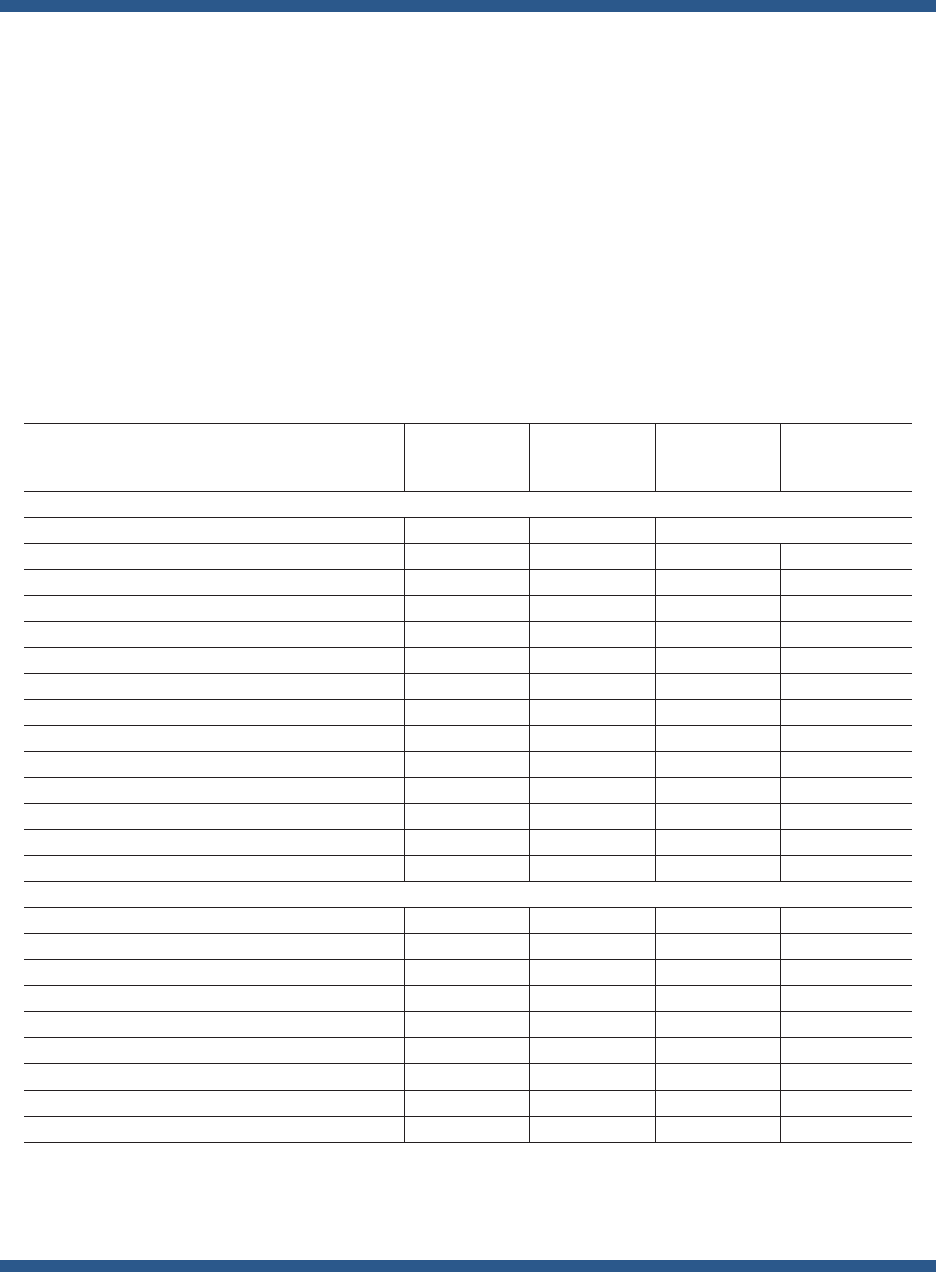
38 PART 2: MONETARY POLICY
in June2022 ( gures A and B). This discussion reviews
recent developments in the Federal Reserve’s balance
sheet and money market conditions.
While the reduction in the size of the SOMA portfolio
has continued as planned, amid the banking-sector
developments of spring 2023, the Federal Reserve
provided liquidity to help ensure the stability of the
banking system and the ongoing provision of money
The Federal Open Market Committee (FOMC)
continued to reduce the size of the Federal Reserve’s
System Open Market Account (SOMA) portfolio,
consistent with its plans for reducing the size of the
Federal Reserve’s balance sheet. Since the time of the
June2023 report, total Federal Reserve assets have
decreased $806 billion, leaving the total size of the
balance sheet at $7.6 trillion, $1.3 trillion smaller since
the reduction in the size of the SOMA portfolio began
Developments in the Federal Reserve’s Balance Sheet
and Money Markets
A. Balance sheet comparison
Billions of dollars
February 21, 2024 June14, 2023
Change
(since June2023)
Change (since
Fed’s balance sheet
reduction began on
June 1, 2022)
Assets
Total securities
Treasury securities 4,661 5,160 −499 −1,109
Agency debt and MBS 2,417 2,561 −144 −293
Net unamortized premiums 274 298 −24 −63
Repurchase agreements 0 0 0 0
Loans and lending facilities
PPPLF 3 8 −5 −17
Discount window 2 4 −2 2
BTFP 164 102 62 164
Other credit extensions 0 180 −180 0
Other loans and lending facilities
15 28 −13 −20
Central bank liquidity swaps 0 0 0 0
Other assets 44 48 −4 2
Total assets 7,582 8,388 −806 −1,333
Liabilities
Federal Reserve notes 2,280 2,292 −12 50
Reserves held by depository institutions 3,523 3,306 217 166
Reverse repurchase agreements
Foreign o cial and international accounts 340 328 12 74
Others 575 2,109 −1,534 −1,390
U.S. Treasury General Account 789 135 654 8
Other deposits 164 220 −56 −84
Other liabilities and capital −89 −2 −87 −157
Total liabilities and capital 7,582 8,388 −806 −1,333
N: MBS is mortgage-backed securities. PPPLF is Paycheck Protection Program Liquidity Facility. BTFP is Bank Term Funding Program. Components may not sum to
totals because of rounding.
S: Federal Reserve Board, Statistical Release H.4.1, “Factors A ecting Reserve Balances.”
(continued)
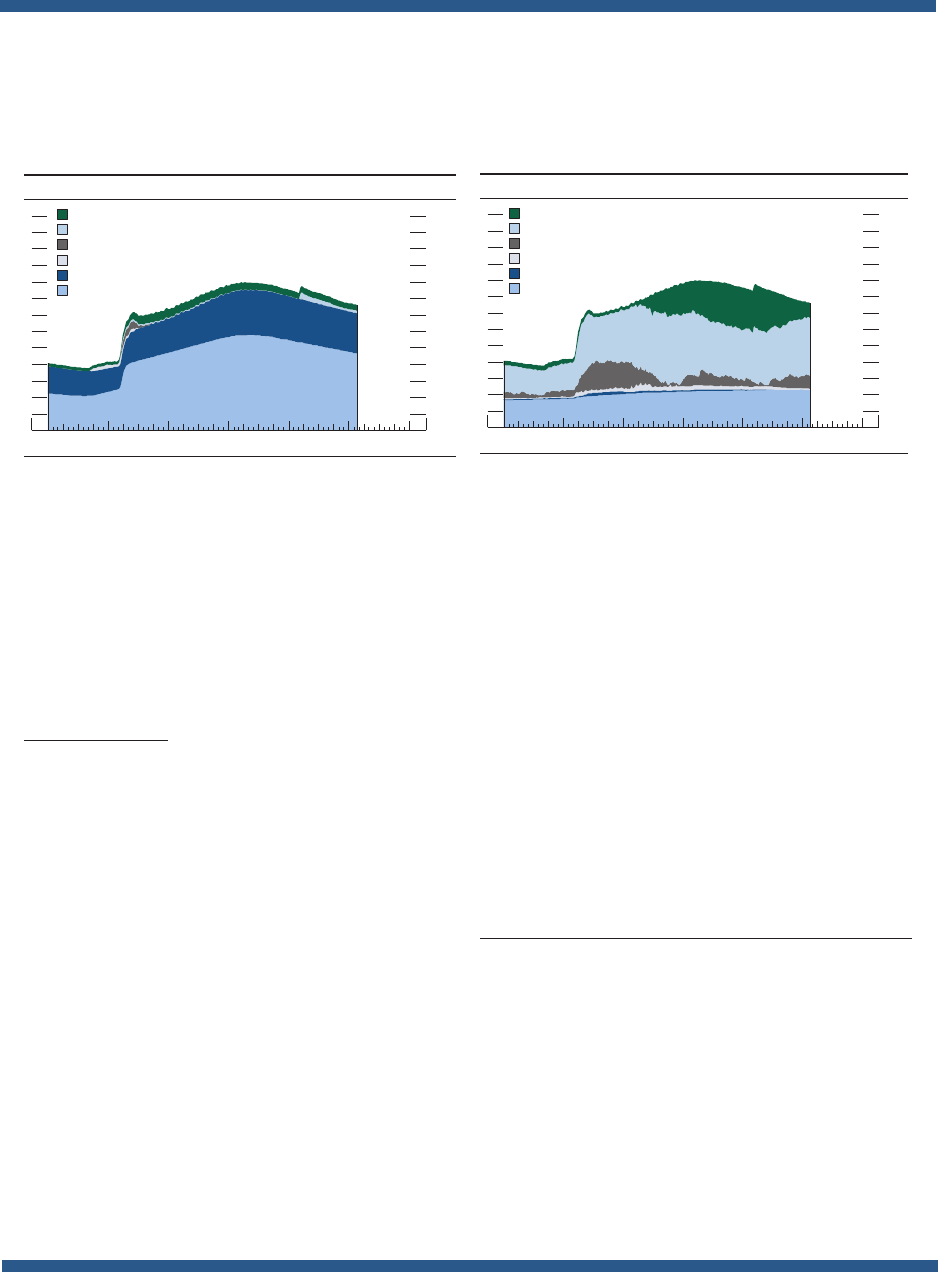
MONETARY POLICY REPORT: MARCH 2024 39
Despite the ongoing reduction in the Federal
Reserve’s securities holdings, reserve balances—the
largest liability item on the Federal Reserve’s balance
sheet—have increased $217 billion since June2023,
given other changes in the composition of the Federal
Reserve’s liabilities over this period.
3
Since June2023,
usage of the overnight reverse repurchase agreement
(ON RRP) facility has declined $1.5 trillion, while
balances in the Treasury General Account have
increased $654 billion ( gures A and C). On net,
changes in these and other nonreserve liabilities have
resulted in an increase in reserve balances.
After remaining above $2 trillion during the rst half
of 2023, usage of the ON RRP facility has declined to
the current interest rate environment. After March11, 2024,
banks and other DIs will continue to have ready access to
the discount window to meet liquidity needs. For additional
information, see Board of Governors of the Federal Reserve
System (2024), “Federal Reserve Board Announces the Bank
Term Funding Program (BTFP) Will Cease Making New
Loans as Scheduled on March11,” press release, January24,
https://www.federalreserve.gov/newsevents/pressreleases/
monetary20240124a.htm.
3. Reserve balances consist of deposits held at the Federal
Reserve Banks by DIs, such as commercial banks, savings
banks, credit unions, thrift institutions, and U.S. branches
and agencies of foreign banks. Reserve balances allow DIs to
facilitate daily payment ows, both in ordinary times and in
stress scenarios, without borrowing funds or selling assets.
and credit to the economy.
1
Loans under the Bank Term
Funding Program—which made additional funding and
liquidity available to eligible depository institutions to
support American businesses and households and which
will cease making new loans as scheduled on March11,
2024—have increased $62billion since June2023
( gure A).
2
1. The loans that were extended to depository institutions
(DIs) placed into Federal Deposit Insurance Corporation
(FDIC) receivership in March2023 have been fully repaid.
The Federal Reserve Banks’ loans to these DIs are secured
by pledged collateral, and the FDIC provides repayment
guarantees. For additional information, see Board of Governors
of the Federal Reserve System (2024), “Additional Information
on Other Credit Extensions,” webpage, January4, https://www.
federalreserve.gov/monetarypolicy/additional-information-on-
other-credit-extensions.htm.
2. The Bank Term Funding Program (BTFP) was established
under section 13(3) of the Federal Reserve Act with the
approval of the Secretary of the Treasury. The BTFP offers loans
of up to one year to banks, savings associations, credit unions,
and other eligible DIs against collateral such as U.S. Treasury
securities, U.S. agency securities, and U.S. agency mortgage-
backed securities. For more details, see Board of Governors
of the Federal Reserve System (2024), “Bank Term Funding
Program,” webpage, February 13, https://www.federalreserve.
gov/financial-stability/bank-term-funding-program.htm.
The interest rate applicable to new BTFP loans has been
adjusted such that the rate on new loans extended from
January25, 2024, through program expiration will be no
lower than the interest rate on reserve balances in effect on
the day the loan is made. This rate adjustment ensures that
the BTFP continues to support the goals of the program in
1
2
3
4
5
6
7
8
9
10
11
12
13
Trillions of dollars
2019 2020 2021 2022 2023 2024
B. Federal Reserve assets
Weekly
N
OTE
: MBS is mortgage-backed securities. The key identies shaded areas
in
order from top to bottom. The data extend through February 21, 2024.
S
OURCE
: Federal Reserve Board, Statistical Release H.4.1, “Factors A
ecting
Reserve Balances.”
Other assets
Loans
Central bank liquidity swaps
Repurchase agreements
Agency debt and MBS
Treasury securities
held outright
1
2
3
4
5
6
7
8
9
10
11
12
13
Trillions of dollars
2019 2020 2021 2022 2023 2024
C. Federal Reserve liabilities
Weekly
N
OTE
: “Capital and other liabilities” includes Treasury contributions and is
negative on February 21, 2024, because of the deferred asset that the Federal
Reserve reports. The key identies shaded areas in order from top to bottom. The
data extend through February 21, 2024.
S
OURCE
: Federal Reserve Board, Statistical Release H.4.1, “Factors Aecting
Reserve Balances.”
Reverse repurchase agreements
Deposits of depository institutions (reserves)
U.S. Treasury General Account
Other deposits
Capital and other liabilities
Federal Reserve notes
(continued on next page)

40 PART 2: MONETARY POLICY
Reserve’s deferred asset increased $82 billion since last
June to a level of $152 billion.
4
Negative net income
and the associated deferred asset do not affect the
Federal Reserve’s conduct of monetary policy or its
ability to meet its nancial obligations.
5
4. The deferred asset is equal to the cumulative shortfall of
net income and represents the amount of future net income
that will need to be realized before remittances to the Treasury
resume. Although remittances are suspended at the time of this
report, over the past decade and a half, the Federal Reserve
has remitted over $1trillion to the Treasury.
5. Net income is expected to turn positive again as interest
expenses fall, and remittances will resume once the temporary
deferred asset falls to zero. As a result of the ongoing
reduction in the size of the Federal Reserve’s balance sheet,
it is expected that interest expenses will fall over time in line
with the decline in the Federal Reserve’s liabilities.
about $575 billion amid the ongoing reduction in the
Federal Reserve’s balance sheet and the substantial
increase in net supply of Treasury securities. Reduced
usage of the ON RRP facility largely re ects money
market funds shifting their portfolio toward higher-
yielding investments, including Treasury bills and
private-market repurchase agreements.
The ON RRP facility is intended to help keep the
effective federal funds rate within the target range. The
facility continued to serve this intended purpose, and
the Federal Reserve’s administered rates—the interest
rate on reserve balances and the ON RRP offering
rate—were highly effective at maintaining the effective
federal funds rate within the target range as the FOMC
tightened the stance of monetary policy.
The Federal Reserve’s expenses have continued to
exceed its income over recent months. The Federal
Federal Reserve’s Balance Sheet and Money Markets (continued)

MONETARY POLICY REPORT: MARCH 2024 41
these rules, along with a “balanced approach
(shortfalls)” rule, which responds to the unemployment
rate only when it is higher than its estimated longer-
run level.
2
All of the simple rules shown embody key
design principles of good monetary policy, including
the requirement that the policy rate should be adjusted
by enough over time to ensure a return of in ation to
the central bank’s longer-run objective and to anchor
longer-term in ation expectations at levels consistent
with that objective.
All ve rules feature the difference between in ation
and the FOMC’s longer-run objective of 2percent. The
ve rules use the unemployment rate gap, measured
as the difference between an estimate of the rate of
unemployment in the longer run (u
t
LR
) and the current
unemployment rate; the rst-difference rule includes
the change in the unemployment rate gap rather
than its level.
3
All but the rst-difference rule include
an estimate of the neutral real interest rate in the
longerrun (r
t
LR
).
4
rule is based on a rule suggested by Athanasios Orphanides
(2003), “Historical Monetary Policy Analysis and the Taylor
Rule,” Journal of Monetary Economics, vol. 50 (July), pp.983–
1022. A review of policy rules is provided in John B.Taylor
and John C. Williams (2011), “Simple and Robust Rules for
Monetary Policy,” in Benjamin M. Friedman and Michael
Woodford, eds., Handbook of Monetary Economics, vol.3B
(Amsterdam: North-Holland), pp. 829–59. The same volume
of the Handbook of Monetary Economics also discusses
approaches to deriving policy rate prescriptions other than
through the use of simple rules.
2. The balanced-approach (shortfalls) rule responds
asymmetrically to unemployment rates above or below their
estimated longer-run value: When unemployment is above
that value, the policy rates are identical to those prescribed by
the balanced-approach rule, whereas when unemployment
is below that value, policy rates do not rise because of
further declines in the unemployment rate. As a result, the
prescription of the balanced-approach (shortfalls) rule has
been less restrictive than that of the balanced-approach rule
since 2022:Q1.
3. Implementations of simple rules often use the output
gap as a measure of resource slack in the economy. The rules
described in gureA instead use the unemployment rate gap
because that gap better captures the FOMC’s statutory goal
to promote maximum employment. Movements in these
alternative measures of resource utilization tend to be highly
correlated. For more information, see the note below gureA.
4. The neutral real interest rate in the longer run (
r
t
LR
) is
the level of the real federal funds rate that is expected to be
consistent, in the longer run, with maximum employment
and stable in ation. Like u
t
LR
, r
t
LR
is determined largely by
nonmonetary factors. The rst-difference rule shown in
gureA does not require an estimate of r
t
LR
, a feature that is
touted by proponents of such rules as providing an element of
As part of their monetary policy deliberations,
policymakers regularly consult the prescriptions
of a variety of simple interest rate rules without
mechanically following the prescriptions of any
particular rule. Simple interest rate rules relate a
policy interest rate, such as the federal funds rate, to a
small number of other economic variables—typically
including the current deviation of in ation from its
target value and a measure of resource slack in the
economy.
Since 2021, in ation has run above the Federal
Open Market Committee’s (FOMC) 2percent longer-
run objective, and labor market conditions have been
tight. Although in ation remains elevated, it has eased
considerably over the past year, and labor supply and
demand have come into better balance. Against this
backdrop, the simple monetary policy rules considered
in this discussion have called for elevated levels of the
federal funds rate over 2021, 2022, and the rst half of
2023, but the rates prescribed by these rules have now
declined to values close to the current target range for
the federal funds rate at 5¼ to5½percent. In support
of its goals of maximum employment and in ation at
the rate of 2percent over the longer run, the FOMC has
maintained the federal funds rate at 5¼ to5½percent
since July while continuing to reduce its holdings
of Treasury securities and agency debt and agency
mortgage-backed securities.
Selected Policy Rules: Descriptions
In many economic models, desirable economic
outcomes can be achieved over time if monetary
policy responds to changes in economic conditions
in a manner that is predictable and adheres to some
key design principles. In recognition of this idea,
economists have analyzed many monetary policy
rules, including the well-known Taylor(1993) rule, the
“balanced approach” rule, the “adjusted Taylor(1993)”
rule, and the “ rst difference” rule.
1
FigureA shows
1. The Taylor(1993) rule was introduced in John B.Taylor
(1993), “Discretion versus Policy Rules in Practice,” Carnegie-
Rochester Conference Series on Public Policy, vol. 39
(December), pp. 195–214. The balanced-approach rule was
analyzed in John B. Taylor (1999), “A Historical Analysis of
Monetary Policy Rules,” in John B. Taylor, ed., Monetary Policy
Rules (Chicago: University of Chicago Press), pp. 319–41. The
adjusted Taylor(1993) rule was studied in David Reifschneider
and John C. Williams (2000), “Three Lessons for Monetary
Policy in a Low-In ation Era,” Journal of Money, Credit and
Banking, vol. 32 (November), pp. 936–66. The rst-difference
Monetary Policy Rules in the Current Environment
(continued on next page)

42 PART 2: MONETARY POLICY
Monetary Policy Rules (continued)
prescribed by the standard Taylor(1993) rule until after
the economy begins to recover.
Policy Rules: Limitations
As benchmarks for monetary policy, simple
policy rules have important limitations. One of these
limitations is that the simple policy rules mechanically
respond to only a small set of economic variables and
thus necessarily abstract from many of the factors that
the FOMC considers when it assesses the appropriate
setting of the policy rate. In addition, the structure of
the economy and current economic conditions differ
in important respects from those prevailing when
the simple policy rules were originally devised and
proposed. As a result, most simple policy rules do not
Unlike the other simple rules featured here,
the adjusted Taylor(1993) rule recognizes that the
federal funds rate cannot be reduced materially
below the effective lower bound (ELB). By contrast,
during the pandemic-induced recession, the standard
Taylor(1993) rule prescribed policy rates that were far
below zero. To make up for the cumulative shortfall in
policy accommodation following a recession during
which the federal funds rate is constrained by its ELB,
the adjusted Taylor(1993) rule prescribes delaying
the return of the policy rate to the (positive) levels
robustness. However, this rule has its own shortcomings. For
example, research suggests that this sort of rule often results
in greater volatility in employment and in ation than what
would be obtained under the Taylor(1993) and balanced-
approachrules.
A. Monetary policy rules
Balanced-approach rule
Balanced-approach (shortfalls) rule
First-dierence rule
Taylor (1993) rule
Adjusted Taylor (1993) rule
N: R
t
T93
, R
t
BA
, R
t
BAS
, R
t
T93adj
, and R
t
FD
represent the values of the nominal federal funds rate prescribed by the Taylor (1993),
balanc
ed-approach, balanced-approach (shortfalls), adjusted Taylor (1993), and rst-dierence rules, respectively.
R
t−1
denotes the realized nominal federal funds rate for quarter t−1, π
t
is the 4-quarter price ination for quarter t, u
t
is the unemployment
ra
te in quarter t , and r
t
LR
is the level of the neutral real federal funds rate in the longer run that is expected to be consistent with sustaining
ma
ximum employment and ination at the Federal Open Market Committee’s 2percent longer-run objective, π
LR
. In addition, u
t
LR
is the rate
of
unemployment expected in the longer run. Z
t
is the cumulative sum of past deviations of the federal funds rate from the prescriptions of th
e
Ta
ylor (1993) rule when that rule prescribes setting the federal funds rate below an eective lower bound (ELB) of 12.5 basis points.
The Taylor (1993) rule and other policy rules are generally written in terms of the deviation of real output from its full capacity level. In
thes
e equations, the output gap has been replaced with the gap between the rate of unemployment in the longer run and its actual level (using
a
rela
tionship known as Okun’s law) to represent the rules in terms of the unemployment rate. The rules are implemented as responding to core
pe
rsonal consumption expenditures (PCE) ination rather than to headline PCE ination because current and near-term core ination rates
te
nd to outperform headline ination rates as predictors of the medium-term behavior of headline ination. Box note 1 provides references fo
r
th
e policy rules.
R
t
T93
= r
t
LR
+ π
t
+ 0.5(π
t
− π
LR
) + (u
t
LR
− u
t
)
R
t
FD
= R
t−1
+ 0.5(π
t
− π
LR
) + (u
t
LR
− u
t
) − (u
t
L
−
R
4
− u
t−4
)
R
t
T93adj
= max{R
t
T93
− Z
t
,
ELB}
R
t
BAS
= r
t
LR
+ π
t
+ 0.5(π
t
− π
LR
) + 2min{(u
t
LR
− u
t
), 0}
R
t
BA
= r
t
LR
+ π
t
+ 0.5(π
t
− π
LR
) + 2(u
t
LR
− u
t
)
(continued)
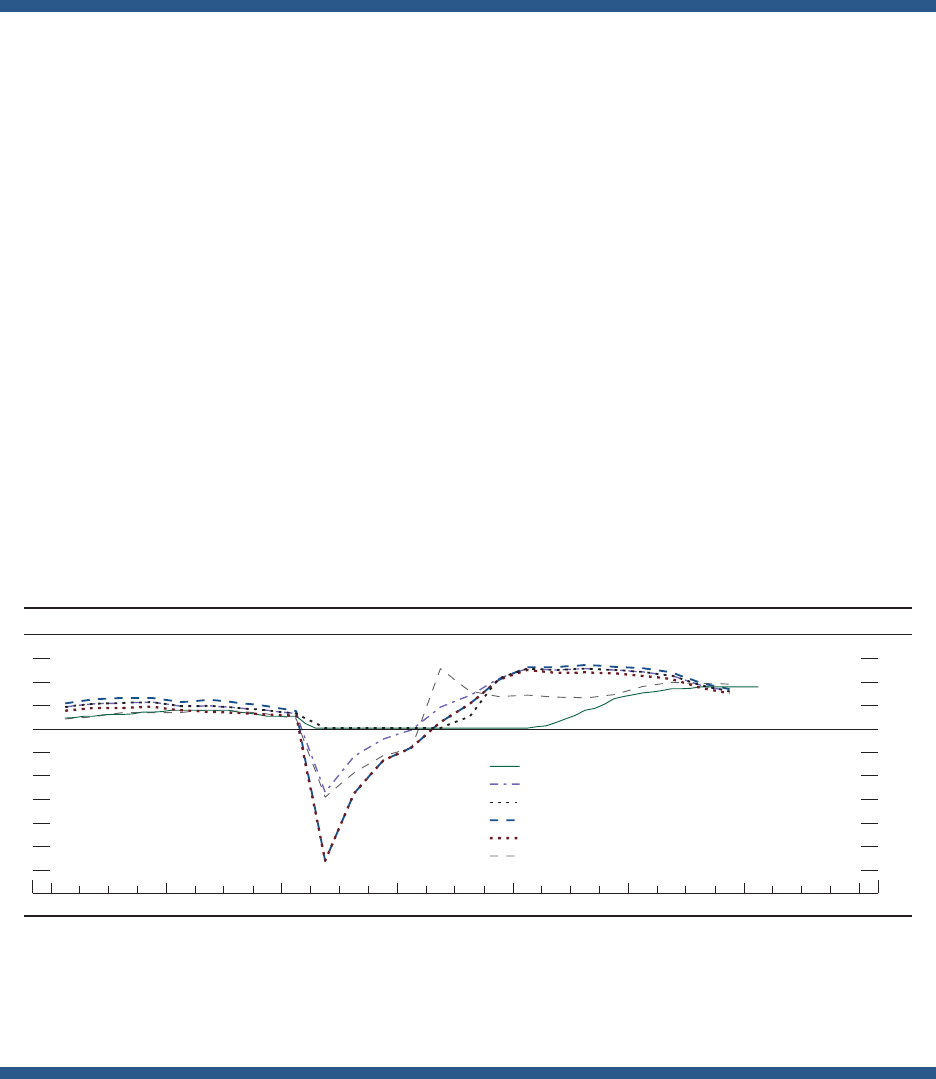
MONETARY POLICY REPORT: MARCH 2024 43
considered. For each quarterly period, the gure reports
the policy rates prescribed by the rules, taking as given
the prevailing economic conditions and survey-based
estimates of u
t
LR
and r
t
LR
at the time. All of the rules
considered called for a highly accommodative stance
of monetary policy in response to the pandemic-driven
recession, followed by positive values as in ation
picked up and labor market conditions strengthened. In
2022 and during the rst half of 2023, the prescriptions
of the simple rules for the federal funds rate were
between 4 and 8percent; these values are well above
the levels observed before the pandemic and re ect, in
large part, elevated in ation readings. Because in ation
has eased recently, the policy rates prescribed by these
rules have now declined to values that are close to the
federal funds rate.
take into account the ELB on interest rates, which limits
the extent to which the policy rate can be lowered to
support the economy. This constraint was particularly
evident during the pandemic-driven recession, when
the lower bound on the policy rate motivated the
FOMC’s other policy actions to support the economy.
Relatedly, another limitation is that simple policy rules
do not explicitly take into account other important tools
of monetary policy, such as balance sheet policies.
Finally, simple policy rules are not forward looking
and do not allow for important risk-management
considerations, associated with uncertainty about
economic relationships and the evolution of the
economy, that factor into FOMC decisions.
Selected Policy Rules: Prescriptions
FigureB shows historical prescriptions for
the federal funds rate under the ve simple rules
First-dierence rule
Taylor (1993) rule
Balanced-approach rule
Federal funds rate
Balanced-approach (shortfalls) rule
18
15
12
9
6
3
+
_
0
3
6
9
Percent
2024202320222021202020192018
B. Historical federal funds rate prescriptions from simple policy rules
NOTE: The rules use historical values of core personal consumption expenditures ination, the unemployment rate, and, where applicable,
historical
values
of the midpoint of the target range for the federal funds rate. Quarterly projections of longer-run values for the federal funds rate,
the
unemployment
rate, and ination used in the computation of the rules’ prescriptions are interpolations to quarterly values of projections from
the
Survey
of Primary Dealers. The rules’ prescriptions are quarterly, and the federal funds rate data are the monthly average of the daily midpoint of
the
target range for the federal funds rate and extend through February 2024.
SOURCE: Federal Reserve Bank of Philadelphia; Federal Reserve Bank of New York, Survey of Primary Dealers; Federal Reserve Board sta
estimates.
Adjusted Taylor (1993) rule
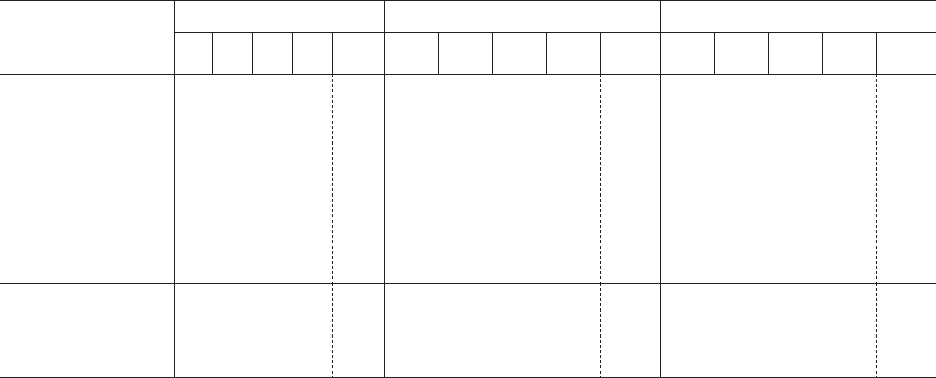
45
In conjunction with the Federal Open
Market Committee (FOMC) meeting held on
December12–13, 2023, meeting participants
submitted their projections of the most likely
outcomes for real gross domestic product
(GDP) growth, the unemployment rate, and
ination for each year from 2023 to 2026
and over the longer run. Each participant’s
projections were based on information
available at the time of the meeting, together
with her or his assessment of appropriate
monetary policy—including a path for the
federal funds rate and its longer-run value—
and assumptions about other factors likely
to aect economic outcomes. The longer-
run projections represent each participant’s
assessment of the value to which each variable
would be expected to converge, over time,
under appropriate monetary policy and in the
absence of further shocks to the economy.
“Appropriate monetary policy” is dened as
the future path of policy that each participant
deems most likely to foster outcomes for
economic activity and ination that best
satisfy his or her individual interpretation of
the statutory mandate to promote maximum
employment and price stability.
Part 3
summary of economic Projections
The following material was released after the conclusion of the December12–13, 2023, meeting of
the Federal Open Market Committee.
Table 1. Economic projections of Federal Reserve Board members and Federal Reserve Bank presidents, under their
individual assumptions of projected appropriate monetary policy, December2023
Percent
Variable
Median
1
Central tendency
2
Range
3
2023 2024 2025 2026
Longer
run
2023 2024 2025 2026
Longer
run
2023 2024 2025 2026
Longer
run
Change in real GDP ..... 2.6 1.4 1.8 1.9 1.8 2.5–2.7 1.2–1.7 1.5–2.0 1.8–2.0 1.7–2.0 2.5–2.7 0.8–2.5 1.4–2.5 1.6–2.5 1.6–2.5
September projection 2.1 1.5 1.8 1.8 1.8 1.9–2.2 1.2–1.8 1.6–2.0 1.7–2.0 1.7–2.0 1.8–2.6 0.4–2.5 1.4–2.5 1.6–2.5 1.6–2.5
Unemployment rate ..... 3.8 4.1 4.1 4.1 4.1 3.8 4.0–4.2 4.0–4.2 3.9–4.3 3.8–4.3 3.7–4.0 3.9–4.5 3.8–4.7 3.8–4.7 3.5–4.3
September projection 3.8 4.1 4.1 4.0 4.0 3.7–3.9 3.9–4.4 3.9–4.3 3.8–4.3 3.8–4.3 3.7–4.0 3.7–4.5 3.7–4.7 3.7–4.5 3.5–4.3
PCE ination .......... 2.8 2.4 2.1 2.0 2.0 2.7–2.9 2.2–2.5 2.0–2.2 2.0 2.0 2.7–3.2 2.1–2.7 2.0–2.5 2.0–2.3 2.0
September projection 3.3 2.5 2.2 2.0 2.0 3.2–3.4 2.3–2.7 2.0–2.3 2.0–2.2 2.0 3.1–3.8 2.1–3.5 2.0–2.9 2.0–2.7 2.0
Core PCE ination
4
..... 3.2 2.4 2.2 2.0 3.2–3.3 2.4–2.7 2.0–2.2 2.0–2.1 3.2–3.7 2.3–3.0 2.0–2.6 2.0–2.3
September projection 3.7 2.6 2.3 2.0 3.6–3.9 2.5–2.8 2.0–2.4 2.0–2.3 3.5–4.2 2.3–3.6 2.0–3.0 2.0–2.9
Memo: Projected
appropriate policy path
Federal funds rate ....... 5.4 4.6 3.6 2.9 2.5 5.4 4.4–4.9 3.1–3.9 2.5–3.1 2.5–3.0 5.4 3.9–5.4 2.4–5.4 2.4–4.9 2.4–3.8
September projection 5.6 5.1 3.9 2.9 2.5 5.4–5.6 4.6–5.4 3.4–4.9 2.5–4.1 2.5–3.3 5.4–5.6 4.4–6.1 2.6–5.6 2.4–4.9 2.4–3.8
N: Projections of change in real gross domestic product (GDP) and projections for both measures of ination are percent changes from the fourth quarter of the previous year to
the fourth quarter of the year indicated. PCE ination and core PCE ination are the percentage rates of change in, respectively, the price index for personal consumption expenditures
(PCE) and the price index for PCE excluding food and energy. Projections for the unemployment rate are for the average civilian unemployment rate in the fourth quarter of the year
indicated. Each participant’s projections are based on his or her assessment of appropriate monetary policy. Longer-run projections represent each participant’s assessment of the rate
to which each variable would be expected to converge under appropriate monetary policy and in the absence of further shocks to the economy. The projections for the federal funds rate
are the value of the midpoint of the projected appropriate target range for the federal funds rate or the projected appropriate target level for the federal funds rate at the end of the spec-
ied calendar year or over the longer run. The September projections were made in conjunction with the meeting of the Federal Open Market Committee on September19–20,2023.
One participant did not submit longer-run projections for the change in real GDP, the unemployment rate, or the federal funds rate in conjunction with the September19–20, 2023,
meeting, and one participant did not submit such projections in conjunction with the December12–13, 2023, meeting.
1. For each period, the median is the middle projection when the projections are arranged from lowest to highest. When the number of projections is even, the median is the average
of the two middle projections.
2. The central tendency excludes the three highest and three lowest projections for each variable in each year.
3. The range for a variable in a given year includes all participants’ projections, from lowest to highest, for that variable in that year.
4. Longer-run projections for core PCE ination are not collected.
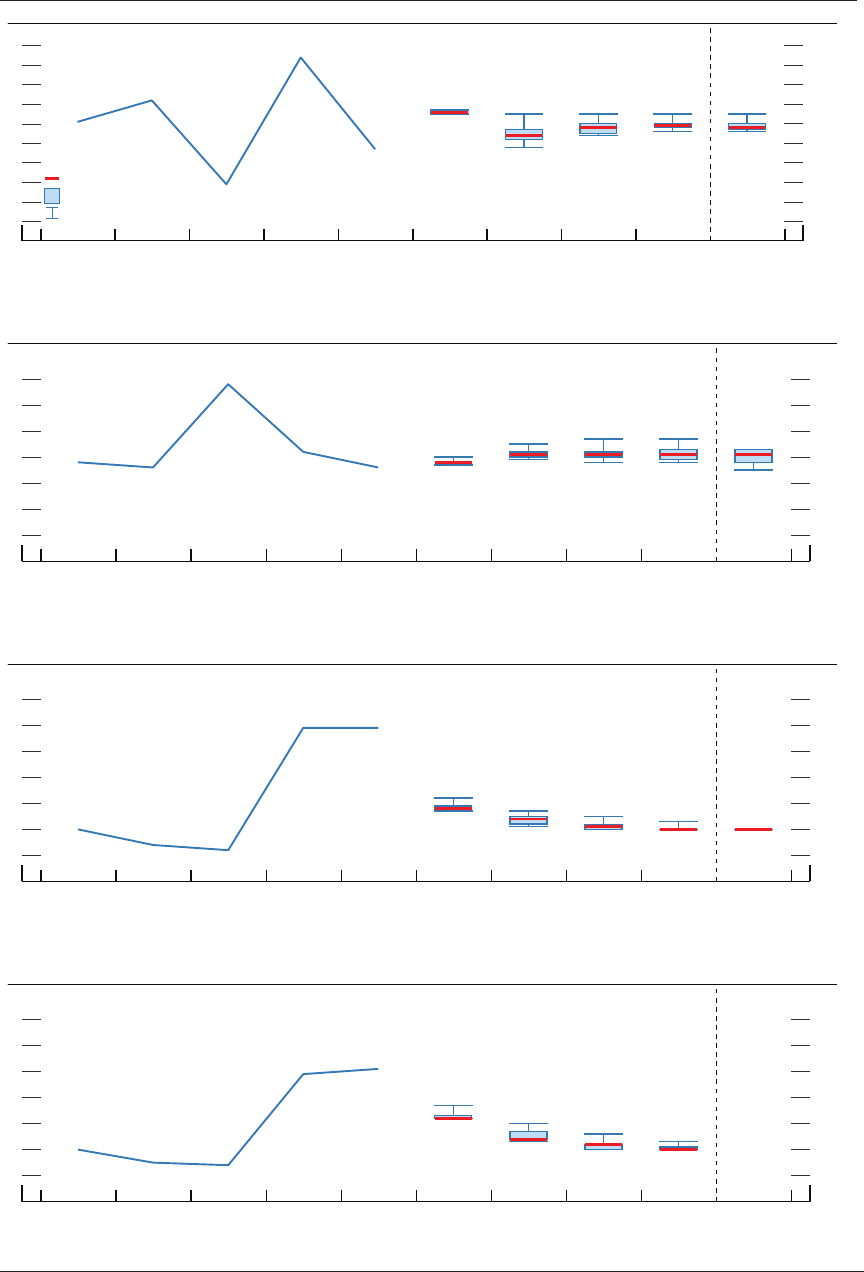
46 PART 3: SUMMARY OF ECONOMIC PROJECTIONS
Figure 1. Medians, central tendencies, and ranges of economic projections, 2023–26 and over the longer run
N: Denitions of variables and other explanations are in the notes to table 1. The data for the actual values of the
variables are annual.
−3
−2
−1
0
1
2
3
4
5
6
2018 20192020202120222023202420252026
Median of projections
Central tendency of projections
Range of projections
Actual
Percent
Change in real GDP
Longer
run
1
2
3
4
5
6
7
2018 2019 2020 2021 2022 2023 2024 2025 2026
Percent
Unemployment rate
Longer
run
1
2
3
4
5
6
7
2018 2019 2020 2021 2022 2023 2024 2025 2026
Percent
PCE inflation
Longer
run
1
2
3
4
5
6
7
2018 2019 2020 2021 2022 2023 2024 2025 2026
Percent
Core PCE inflation
Longer
run
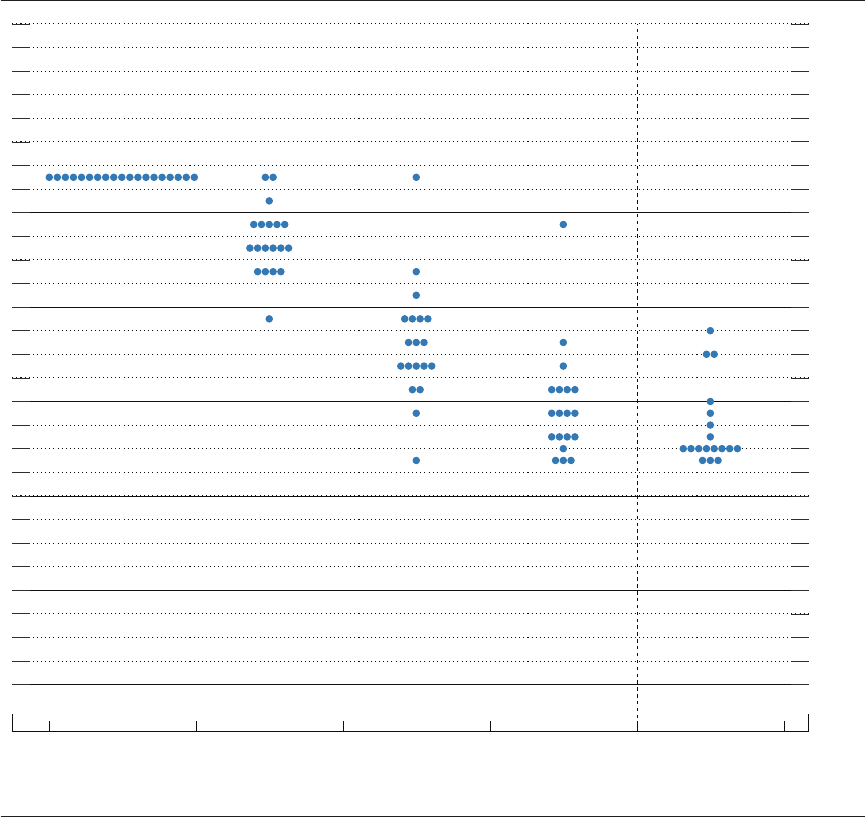
MONETARY POLICY REPORT: MARCH 2024 47
Figure 2. FOMC participants’ assessments of appropriate monetary policy: Midpoint of target range or target
level for the federal funds rate
N: Each shaded circle indicates the value (rounded to the nearest 1/8 percentage point) of an individual participant’s
judgment of the midpoint of the appropriate target range for the federal funds rate or the appropriate target level for the
federal funds rate at the end of the specied calendar year or over the longer run. One participant did not submit
longer-run projections for the federal funds rate.
0.0
0.5
1.0
1.5
2.0
2.5
3.0
3.5
4.0
4.5
5.0
5.5
6.0
6.5
7.0
2023 2024 2025 2026
Longer run
Percent
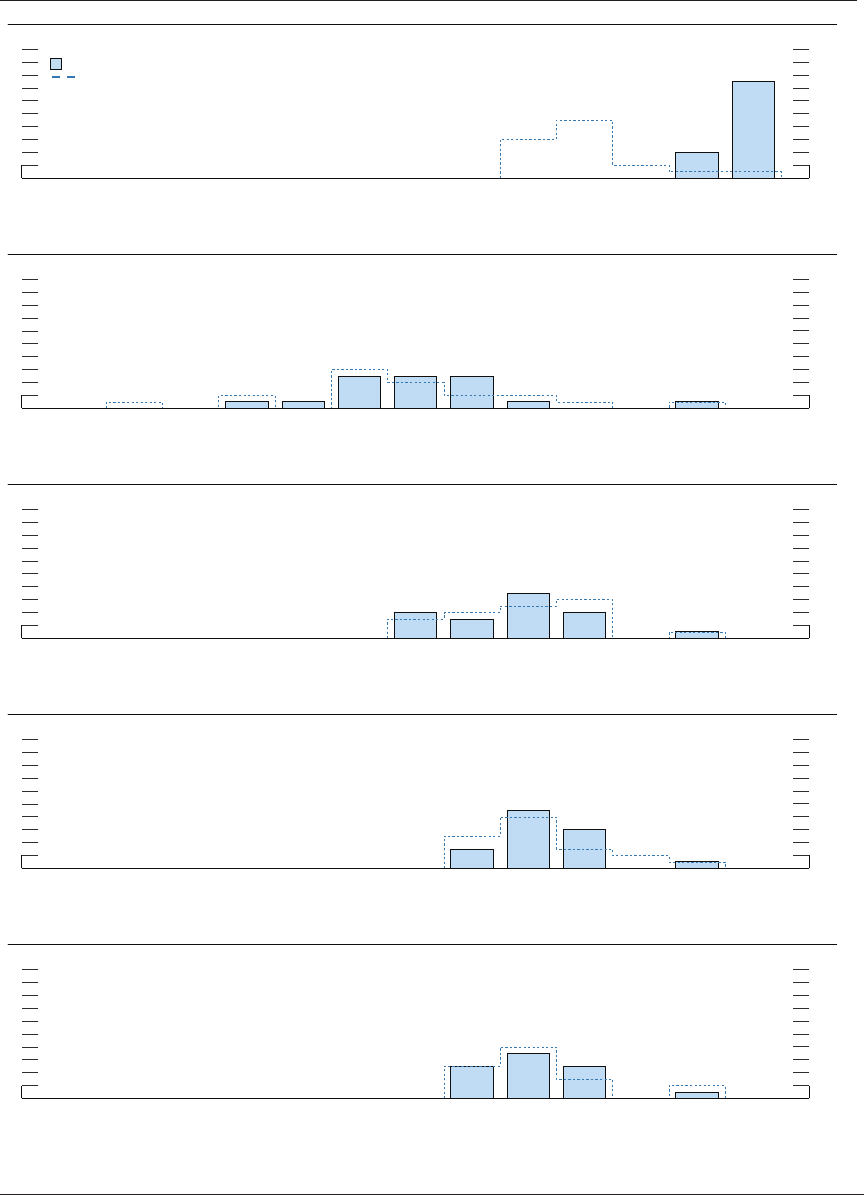
48 PART 3: SUMMARY OF ECONOMIC PROJECTIONS
Figure 3.A. Distribution of participants’ projections for the change in real GDP, 2023–26 and over the longer run
N: Denitions of variables and other explanations are in the notes to table 1.
2
4
6
8
10
12
14
16
18
20
0.2−
0.3
0.4−
0.5
0.6−
0.7
0.8−
0.9
1.0−
1.1
1.2−
1.3
1.4−
1.5
1.6−
1.7
1.8−
1.9
2.0−
2.1
2.2−
2.3
2.4−
2.5
2.6−
2.7
Percent range
December projections
September projections
Number of participants
2023
2
4
6
8
10
12
14
16
18
20
0.2−
0.3
0.4−
0.5
0.6−
0.7
0.8−
0.9
1.0−
1.1
1.2−
1.3
1.4−
1.5
1.6−
1.7
1.8−
1.9
2.0−
2.1
2.2−
2.3
2.4−
2.5
2.6−
2.7
Percent range
Number of participants
2024
2
4
6
8
10
12
14
16
18
20
0.2−
0.3
0.4−
0.5
0.6−
0.7
0.8−
0.9
1.0−
1.1
1.2−
1.3
1.4−
1.5
1.6−
1.7
1.8−
1.9
2.0−
2.1
2.2−
2.3
2.4−
2.5
2.6−
2.7
Percent range
Number of participants
2025
2
4
6
8
10
12
14
16
18
20
0.2−
0.3
0.4−
0.5
0.6−
0.7
0.8−
0.9
1.0−
1.1
1.2−
1.3
1.4−
1.5
1.6−
1.7
1.8−
1.9
2.0−
2.1
2.2−
2.3
2.4−
2.5
2.6−
2.7
Percent range
Number of participants
2026
2
4
6
8
10
12
14
16
18
20
0.2−
0.3
0.4−
0.5
0.6−
0.7
0.8−
0.9
1.0−
1.1
1.2−
1.3
1.4−
1.5
1.6−
1.7
1.8−
1.9
2.0−
2.1
2.2−
2.3
2.4−
2.5
2.6−
2.7
Percent range
Number of participants
Longer run

MONETARY POLICY REPORT: MARCH 2024 49
Figure 3.B. Distribution of participants’ projections for the unemployment rate, 2023–26 and over the longer run
N: Denitions of variables and other explanations are in the notes to table 1.
2
4
6
8
10
12
14
16
18
20
3.2−
3.3
3.4−
3.5
3.6−
3.7
3.8−
3.9
4.0−
4.1
4.2−
4.3
4.4−
4.5
4.6−
4.7
Percent range
December projections
September projections
Number of participants
2023
2
4
6
8
10
12
14
16
18
20
3.2−
3.3
3.4−
3.5
3.6−
3.7
3.8−
3.9
4.0−
4.1
4.2−
4.3
4.4−
4.5
4.6−
4.7
Percent range
Number of participants
2024
2
4
6
8
10
12
14
16
18
20
3.2−
3.3
3.4−
3.5
3.6−
3.7
3.8−
3.9
4.0−
4.1
4.2−
4.3
4.4−
4.5
4.6−
4.7
Percent range
Number of participants
2025
2
4
6
8
10
12
14
16
18
20
3.2−
3.3
3.4−
3.5
3.6−
3.7
3.8−
3.9
4.0−
4.1
4.2−
4.3
4.4−
4.5
4.6−
4.7
Percent range
Number of participants
2026
2
4
6
8
10
12
14
16
18
20
3.2−
3.3
3.4−
3.5
3.6−
3.7
3.8−
3.9
4.0−
4.1
4.2−
4.3
4.4−
4.5
4.6−
4.7
Percent range
Number of participants
Longer run
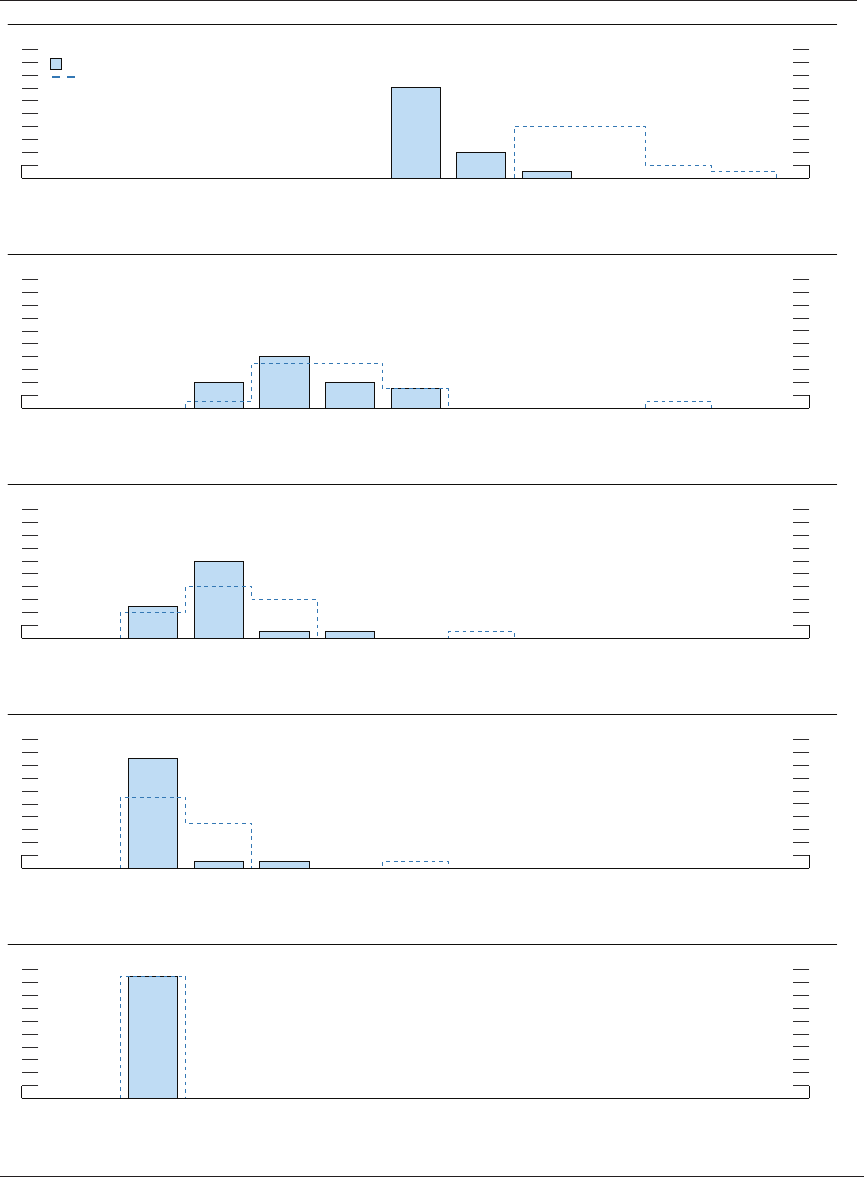
50 PART 3: SUMMARY OF ECONOMIC PROJECTIONS
Figure 3.C. Distribution of participants’ projections for PCE ination, 2023–26 and over the longer run
N: Denitions of variables and other explanations are in the notes to table 1.
2
4
6
8
10
12
14
16
18
20
1.7−
1.8
1.9−
2.0
2.1−
2.2
2.3−
2.4
2.5−
2.6
2.7−
2.8
2.9−
3.0
3.1−
3.2
3.3−
3.4
3.5−
3.6
3.7−
3.8
Percent range
December projections
September projections
Number of participants
2023
2
4
6
8
10
12
14
16
18
20
1.7−
1.8
1.9−
2.0
2.1−
2.2
2.3−
2.4
2.5−
2.6
2.7−
2.8
2.9−
3.0
3.1−
3.2
3.3−
3.4
3.5−
3.6
3.7−
3.8
Percent range
Number of participants
2024
2
4
6
8
10
12
14
16
18
20
1.7−
1.8
1.9−
2.0
2.1−
2.2
2.3−
2.4
2.5−
2.6
2.7−
2.8
2.9−
3.0
3.1−
3.2
3.3−
3.4
3.5−
3.6
3.7−
3.8
Percent range
Number of participants
2025
2
4
6
8
10
12
14
16
18
20
1.7−
1.8
1.9−
2.0
2.1−
2.2
2.3−
2.4
2.5−
2.6
2.7−
2.8
2.9−
3.0
3.1−
3.2
3.3−
3.4
3.5−
3.6
3.7−
3.8
Percent range
Number of participants
2026
2
4
6
8
10
12
14
16
18
20
1.7−
1.8
1.9−
2.0
2.1−
2.2
2.3−
2.4
2.5−
2.6
2.7−
2.8
2.9−
3.0
3.1−
3.2
3.3−
3.4
3.5−
3.6
3.7−
3.8
Percent range
Number of participants
Longer run

MONETARY POLICY REPORT: MARCH 2024 51
Figure 3.D. Distribution of participants’ projections for core PCE ination, 2023–26
N: Denitions of variables and other explanations are in the notes to table 1.
2
4
6
8
10
12
14
16
18
20
1.7−
1.8
1.9−
2.0
2.1−
2.2
2.3−
2.4
2.5−
2.6
2.7−
2.8
2.9−
3.0
3.1−
3.2
3.3−
3.4
3.5−
3.6
3.7−
3.8
3.9−
4.0
4.1−
4.2
Percent range
December projections
September projections
Number of participants
2023
2
4
6
8
10
12
14
16
18
20
1.7−
1.8
1.9−
2.0
2.1−
2.2
2.3−
2.4
2.5−
2.6
2.7−
2.8
2.9−
3.0
3.1−
3.2
3.3−
3.4
3.5−
3.6
3.7−
3.8
3.9−
4.0
4.1−
4.2
Percent range
Number of participants
2024
2
4
6
8
10
12
14
16
18
20
1.7−
1.8
1.9−
2.0
2.1−
2.2
2.3−
2.4
2.5−
2.6
2.7−
2.8
2.9−
3.0
3.1−
3.2
3.3−
3.4
3.5−
3.6
3.7−
3.8
3.9−
4.0
4.1−
4.2
Percent range
Number of participants
2025
2
4
6
8
10
12
14
16
18
20
1.7−
1.8
1.9−
2.0
2.1−
2.2
2.3−
2.4
2.5−
2.6
2.7−
2.8
2.9−
3.0
3.1−
3.2
3.3−
3.4
3.5−
3.6
3.7−
3.8
3.9−
4.0
4.1−
4.2
Percent range
Number of participants
2026
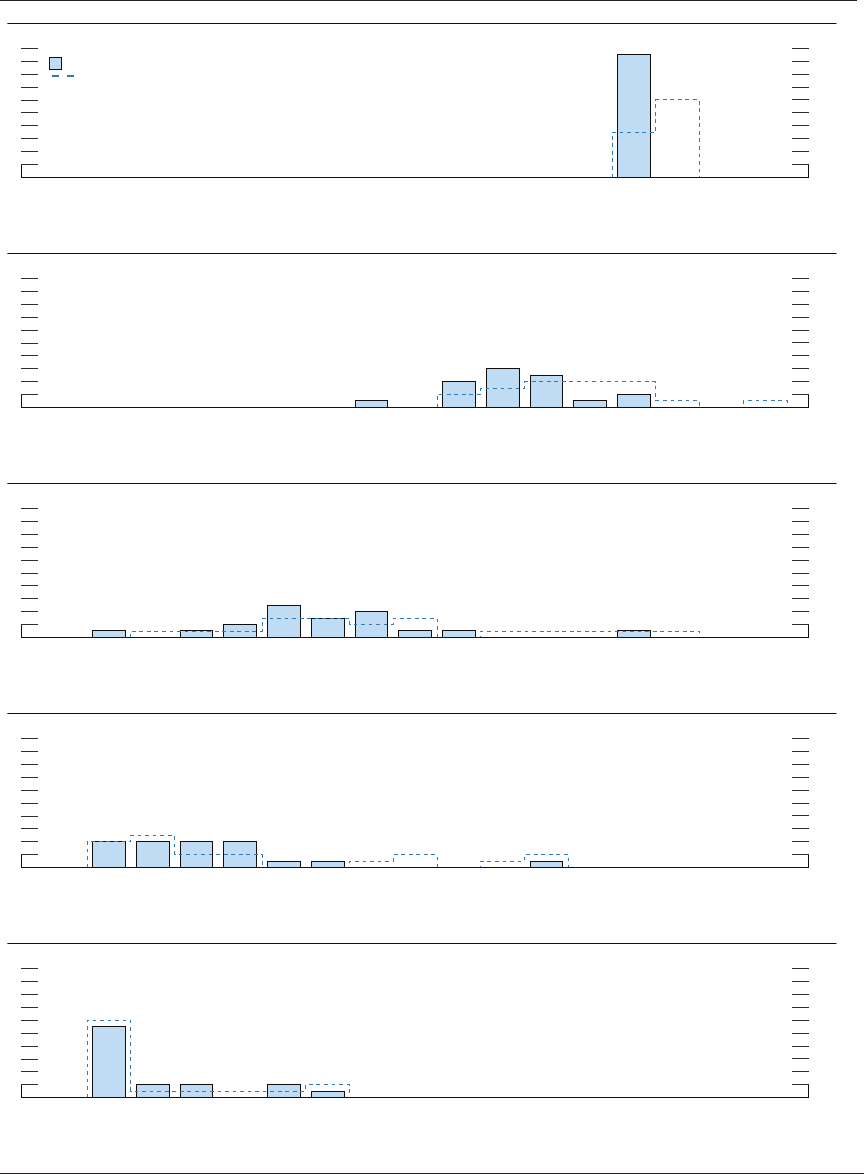
52 PART 3: SUMMARY OF ECONOMIC PROJECTIONS
Figure 3.E. Distribution of participants’ judgments of the midpoint of the appropriate target range for the
federal funds rate or the appropriate target level for the federal funds rate, 2023–26 and over the longer run
N: Denitions of variables and other explanations are in the notes to table 1.
2
4
6
8
10
12
14
16
18
20
2.13−
2.37
2.38−
2.62
2.63−
2.87
2.88−
3.12
3.13−
3.37
3.38−
3.62
3.63−
3.87
3.88−
4.12
4.13−
4.37
4.38−
4.62
4.63−
4.87
4.88−
5.12
5.13−
5.37
5.38−
5.62
5.63−
5.87
5.88−
6.12
6.13−
6.37
Percent range
December projections
September projections
Number of participants
2023
2
4
6
8
10
12
14
16
18
20
2.13−
2.37
2.38−
2.62
2.63−
2.87
2.88−
3.12
3.13−
3.37
3.38−
3.62
3.63−
3.87
3.88−
4.12
4.13−
4.37
4.38−
4.62
4.63−
4.87
4.88−
5.12
5.13−
5.37
5.38−
5.62
5.63−
5.87
5.88−
6.12
6.13−
6.37
Percent range
Number of participants
2024
2
4
6
8
10
12
14
16
18
20
2.13−
2.37
2.38−
2.62
2.63−
2.87
2.88−
3.12
3.13−
3.37
3.38−
3.62
3.63−
3.87
3.88−
4.12
4.13−
4.37
4.38−
4.62
4.63−
4.87
4.88−
5.12
5.13−
5.37
5.38−
5.62
5.63−
5.87
5.88−
6.12
6.13−
6.37
Percent range
Number of participants
2025
2
4
6
8
10
12
14
16
18
20
2.13−
2.37
2.38−
2.62
2.63−
2.87
2.88−
3.12
3.13−
3.37
3.38−
3.62
3.63−
3.87
3.88−
4.12
4.13−
4.37
4.38−
4.62
4.63−
4.87
4.88−
5.12
5.13−
5.37
5.38−
5.62
5.63−
5.87
5.88−
6.12
6.13−
6.37
Percent range
Number of participants
2026
2
4
6
8
10
12
14
16
18
20
2.13−
2.37
2.38−
2.62
2.63−
2.87
2.88−
3.12
3.13−
3.37
3.38−
3.62
3.63−
3.87
3.88−
4.12
4.13−
4.37
4.38−
4.62
4.63−
4.87
4.88−
5.12
5.13−
5.37
5.38−
5.62
5.63−
5.87
5.88−
6.12
6.13−
6.37
Percent range
Number of participants
Longer run

MONETARY POLICY REPORT: MARCH 2024 53
Figure 4.A. Uncertainty and risks in projections of GDP growth
N: The blue and red lines in the top panel show actual values and median projected values, respectively, of the
percent change in real gross domestic product (GDP) from the fourth quarter of the previous year to the fourth quarter of
the year indicated. The condence interval around the median projected values is assumed to be symmetric and is based on
root mean squared errors of various private and government forecasts made over the previous 20 years; more information
about these data is available in table 2. Because current conditions may dier from those that prevailed, on average, over
the previous 20 years, the width and shape of the condence interval estimated on the basis of the historical forecast errors
may not reect FOMC participants’ current assessments of the uncertainty and risks around their projections; these
current assessments are summarized in the lower panels. Generally speaking, participants who judge the uncertainty about
their projections as “broadly similar” to the average levels of the past 20 years would view the width of the condence
interval shown in the historical fan chart as largely consistent with their assessments of the uncertainty about their
projections. Likewise, participants who judge the risks to their projections as “broadly balanced” would view the
condence interval around their projections as approximately symmetric. For denitions of uncertainty and risks in
economic projections, see the box “Forecast Uncertainty.”
Median projection and condence interval based on historical forecast errors
−3
−2
−1
0
1
2
3
4
5
6
2018 2019 2020 2021 2022 2023 2024 2025 2026
Median of projections
70% confidence interval
Actual
Percent
Change in real GDP
FOMC participants’ assessmentsof uncertainty and risksaround their economic projections
2
4
6
8
10
12
14
16
18
20
Lower Broadly
similar
Higher
December projections
September projections
Number of participants
Uncertainty about GDP growth
2
4
6
8
10
12
14
16
18
20
Weighted to
downside
Broadly
balanced
Weighted to
upside
December projections
September projections
Number of participants
Risks to GDP growth
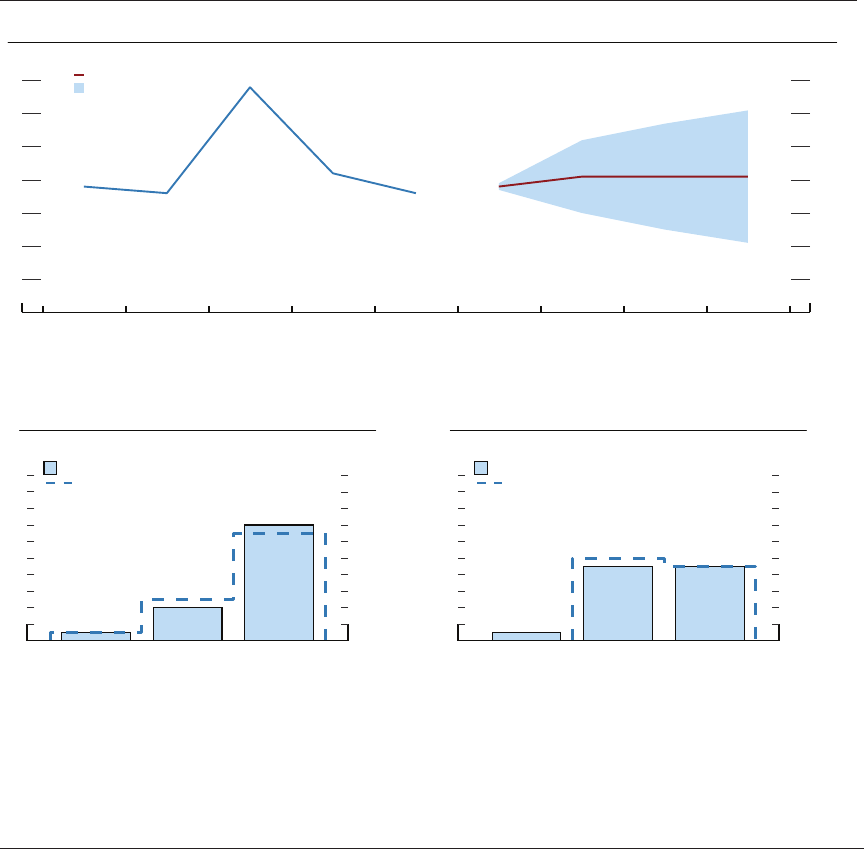
54 PART 3: SUMMARY OF ECONOMIC PROJECTIONS
Figure 4.B. Uncertainty and risks in projections of the unemployment rate
N: The blue and red lines in the top panel show actual values and median projected values, respectively, of the
average civilian unemployment rate in the fourth quarter of the year indicated. The condence interval around the median
projected values is assumed to be symmetric and is based on root mean squared errors of various private and government
forecasts made over the previous 20 years; more information about these data is available in table 2. Because current
conditions may dier from those that prevailed, on average, over the previous 20 years, the width and shape of the
condence interval estimated on the basis of the historical forecast errors may not reect FOMC participants’ current
assessments of the uncertainty and risks around their projections; these current assessments are summarized in the lower
panels. Generally speaking, participants who judge the uncertainty about their projections as “broadly similar” to the
average levels of the past 20 years would view the width of the condence interval shown in the historical fan chart as
largely consistent with their assessments of the uncertainty about their projections. Likewise, participants who judge the
risks to their projections as “broadly balanced” would view the condence interval around their projections as approxi-
mately symmetric. For denitions of uncertainty and risks in economic projections, see the box “Forecast Uncertainty.”
Median projection and condence interval based on historical forecast errors
1
2
3
4
5
6
7
2018 2019 2020 2021 2022 2023 2024 2025 2026
Median of projections
70% confidence interval
Actual
Percent
Unemployment rate
FOMC participants’ assessmentsof uncertainty and risksaround their economic projections
2
4
6
8
10
12
14
16
18
20
Lower Broadly
similar
Higher
December projections
September projections
Number of participants
Uncertainty about the unemployment rate
2
4
6
8
10
12
14
16
18
20
Weighted to
downside
Broadly
balanced
Weighted to
upside
December projections
September projections
Number of participants
Risks to the unemployment rate
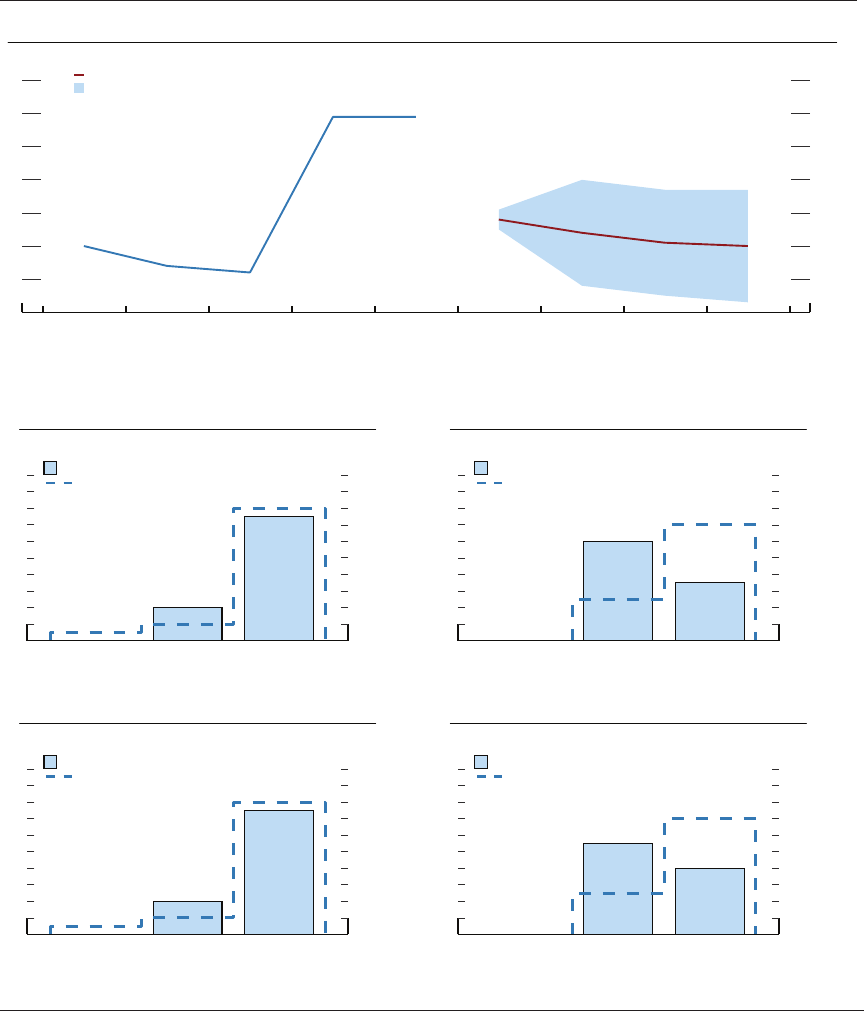
MONETARY POLICY REPORT: MARCH 2024 55
Figure 4.C. Uncertainty and risks in projections of PCE ination
N: The blue and red lines in the top panel show actual values and median projected values, respectively, of the
percent change in the price index for personal consumption expenditures (PCE) from the fourth quarter of the previous
year to the fourth quarter of the year indicated. The condence interval around the median projected values is assumed to
be symmetric and is based on root mean squared errors of various private and government forecasts made over the
previous 20 years; more information about these data is available in table 2. Because current conditions may dier from
those that prevailed, on average, over the previous 20 years, the width and shape of the condence interval estimated on
the basis of the historical forecast errors may not reect FOMC participants’ current assessments of the uncertainty and
risks around their projections; these current assessments are summarized in the lower panels. Generally speaking,
participants who judge the uncertainty about their projections as “broadly similar” to the average levels of the past
20 years would view the width of the condence interval shown in the historical fan chart as largely consistent with their
assessments of the uncertainty about their projections. Likewise, participants who judge the risks to their projections as
“broadly balanced” would view the condence interval around their projections as approximately symmetric. For
denitions of uncertainty and risks in economic projections, see the box “Forecast Uncertainty.”
Median projection and condence interval based on historical forecast errors
1
2
3
4
5
6
7
2018 2019 2020 2021 2022 2023 2024 2025 2026
Median of projections
70% confidence interval
Actual
Percent
PCE inflation
FOMC participants’ assessmentsof uncertainty and risksaround their economic projections
2
4
6
8
10
12
14
16
18
20
Lower Broadly
similar
Higher
December projections
September projections
Number of participants
Uncertainty about PCE inflation
2
4
6
8
10
12
14
16
18
20
Weighted to
downside
Broadly
balanced
Weighted to
upside
December projections
September projections
Number of participants
Risks to PCE inflation
2
4
6
8
10
12
14
16
18
20
Lower Broadly
similar
Higher
December projections
September projections
Number of participants
Uncertainty about core PCE inflation
2
4
6
8
10
12
14
16
18
20
Weighted to
downside
Broadly
balanced
Weighted to
upside
December projections
September projections
Number of participants
Risks to core PCE inflation
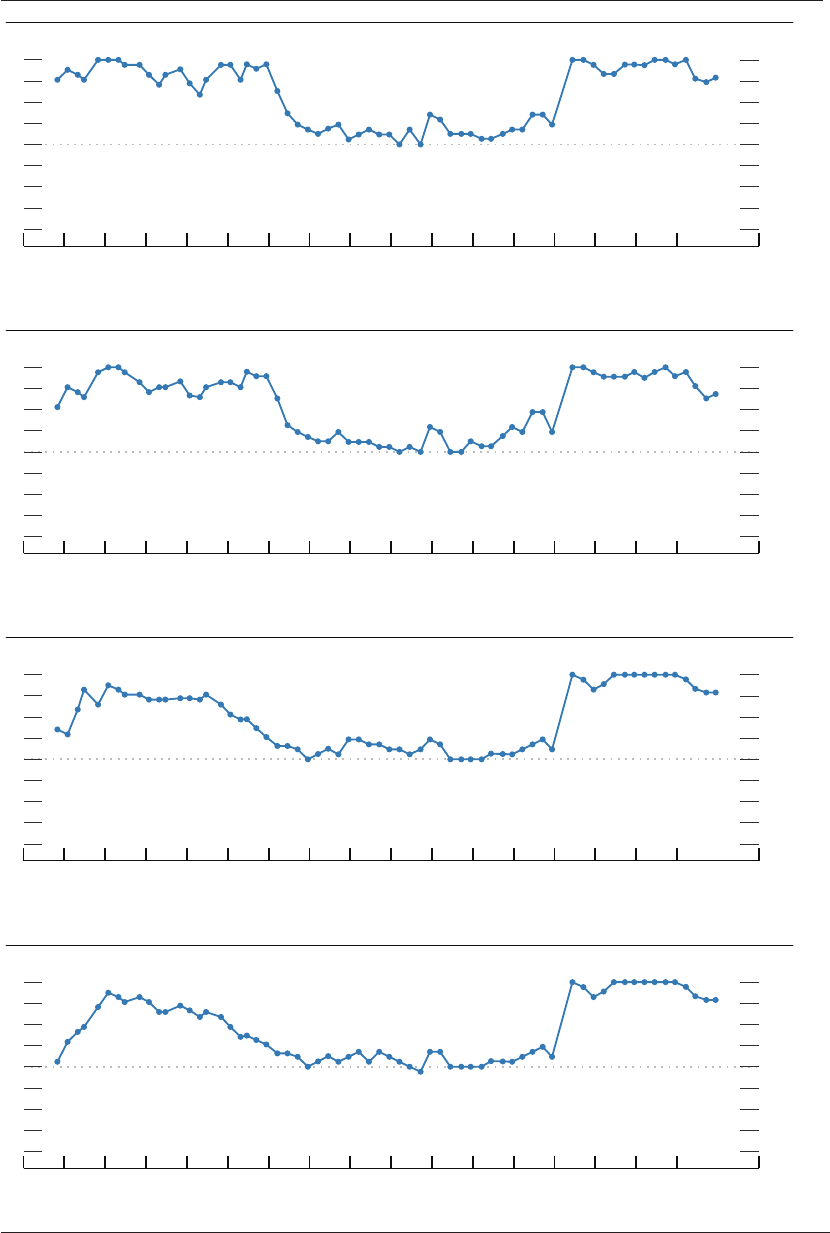
56 PART 3: SUMMARY OF ECONOMIC PROJECTIONS
Figure 4.D. Diusion indexes of participants’ uncertainty assessments
N: For each SEP, participants provided responses to the question “Please indicate your judgment of the uncertainty
attached to your projections relative to the levels of uncertainty over the past 20 years.” Each point in the diusion indexes
represents the number of participants who responded “Higher” minus the number who responded “Lower,” divided by the
total number of participants. Figure excludes March 2020 when no projections were submitted.
−1.00
−0.75
−0.50
−0.25
0.00
0.25
0.50
0.75
1.00
2007 2008 2009 2010 2011 2012 2013 2014 2015 2016 2017 2018 2019 2020 2021 2022 2023
Diffusion index
Change in real GDP
−1.00
−0.75
−0.50
−0.25
0.00
0.25
0.50
0.75
1.00
2007 2008 2009 2010 2011 2012 2013 2014 2015 2016 2017 2018 2019 2020 2021 2022 2023
Diffusion index
Unemployment rate
−1.00
−0.75
−0.50
−0.25
0.00
0.25
0.50
0.75
1.00
2007 2008 2009 2010 2011 2012 2013 2014 2015 2016 2017 2018 2019 2020 2021 2022 2023
Diffusion index
PCE inflation
−1.00
−0.75
−0.50
−0.25
0.00
0.25
0.50
0.75
1.00
2007 2008 2009 2010 2011 2012 2013 2014 2015 2016 2017 2018 2019 2020 2021 2022 2023
Diffusion index
Core PCE inflation
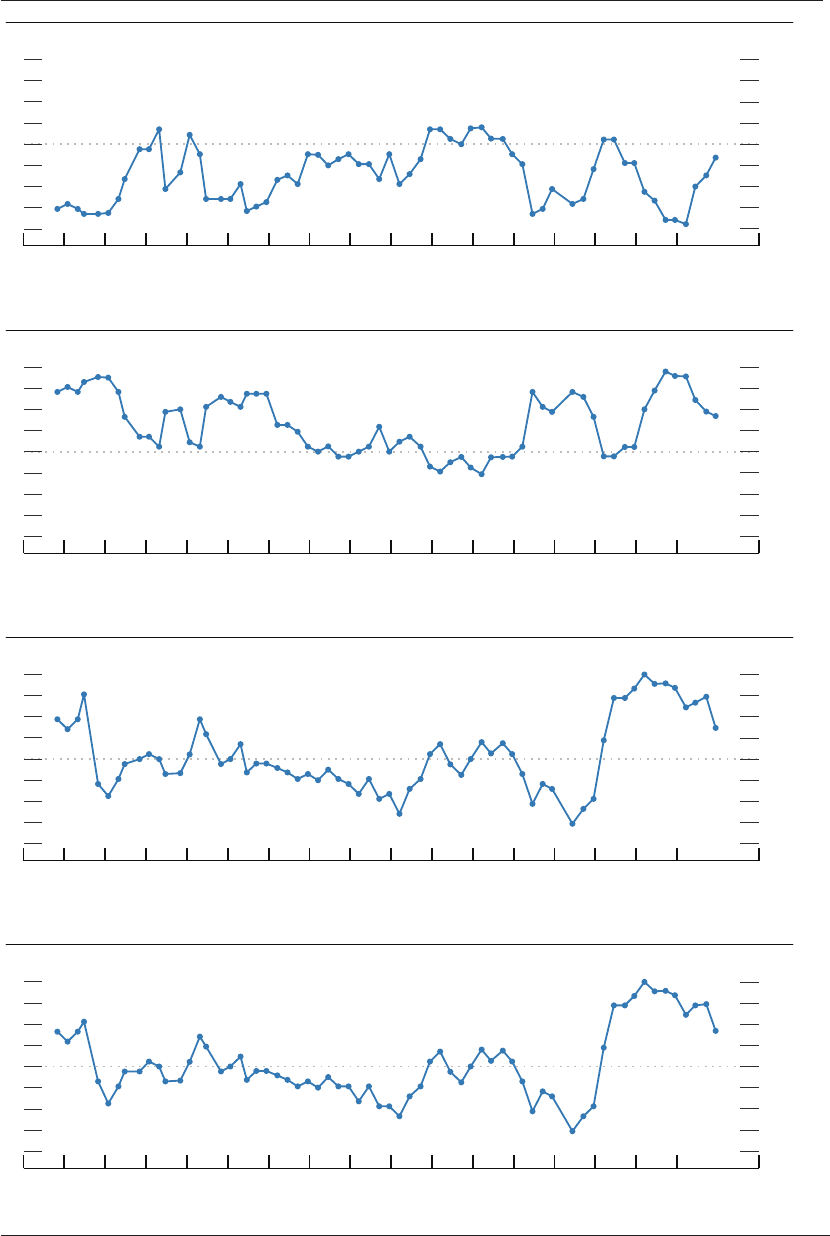
MONETARY POLICY REPORT: MARCH 2024 57
Figure 4.E. Diusion indexes of participants’ risk weightings
N: For each SEP, participants provided responses to the question “Please indicate your judgment of the risk
weighting around your projections.” Each point in the diusion indexes represents the number of participants who
responded “Weighted to the Upside” minus the number who responded “Weighted to the Downside,” divided by the total
number of participants. Figure excludes March 2020 when no projections were submitted.
−1.00
−0.75
−0.50
−0.25
0.00
0.25
0.50
0.75
1.00
2007 2008 2009 2010 2011 2012 2013 2014 2015 2016 2017201820192020202120222023
Diffusion index
Change in real GDP
−1.00
−0.75
−0.50
−0.25
0.00
0.25
0.50
0.75
1.00
2007 2008 2009 2010 2011 2012 2013 2014 2015 2016 2017201820192020202120222023
Diffusion index
Unemployment rate
−1.00
−0.75
−0.50
−0.25
0.00
0.25
0.50
0.75
1.00
2007 2008 2009 2010 2011 2012 2013 2014 2015 2016 2017201820192020202120222023
Diffusion index
PCE inflation
−1.00
−0.75
−0.50
−0.25
0.00
0.25
0.50
0.75
1.00
2007 2008 2009 2010 2011 2012 2013 2014 2015 2016 2017201820192020202120222023
Diffusion index
Core PCE inflation

58 PART 3: SUMMARY OF ECONOMIC PROJECTIONS
Figure 5. Uncertainty and risks in projections of the federal funds rate
N
: The blue and red lines are based on actual values and median projected values, respectively, of the Committee’s
ta
rget for the federal funds rate at the end of the year indicated. The actual values are the midpoint of the target range; the
me
dian projected values are based on either the midpoint of the target range or the target level. The condence interval
ar
ound the median projected values is based on root mean squared errors of various private and government forecasts
mad
e over the previous 20 years. The condence interval is not strictly consistent with the projections for the federal funds
ra
te, primarily because these projections are not forecasts of the likeliest outcomes for the federal funds rate, but rather
pr
ojections of participants’ individual assessments of appropriate monetary policy. Still, historical forecast errors provide
a b
road sense of the uncertainty around the future path of the federal funds rate generated by the uncertainty about the
macr
oeconomic variables as well as additional adjustments to monetary policy that may be appropriate to oset the eects
of s
hocks to the economy.
T
he condence interval is assumed to be symmetric except when it is truncated at zero - the bottom of the lowest target
ra
nge for the federal funds rate that has been adopted in the past by the Committee. This truncation would not be intended
t
o indicate the likelihood of the use of negative interest rates to provide additional monetary policy accommodation if
do
ing so was judged appropriate. In such situations, the Committee could also employ other tools, including forward
gu
idance and large-scale asset purchases, to provide additional accommodation. Because current conditions may dier
fr
om those that prevailed, on average, over the previous 20 years, the width and shape of the condence interval estimated
o
n the basis of the historical forecast errors may not reect FOMC participants’ current assessments of the uncertainty and
ri
sks around their projections.
* The condence interval is derived from forecasts of the average level of short-term interest rates in the fourth quarter
of t
he year indicated; more information about these data is available in table 2. The shaded area encompasses less than a
70 percent condence interval if the condence interval has been truncated at zero.
0
1
2
3
4
5
6
7
2018 2019 2020 2021 2022 2023 2024 2025 2026
Midpoint of target range
Median of projections
70% confidence interval*
Actual
Percent
Federal funds rate

MONETARY POLICY REPORT: MARCH 2024 59
Table 2. Average historical projection error ranges
Percentage points
Variable 2023 2024 2025 2026
Change in real GDP
1
....... ±0.8 ±1.7 ±2.1 ±2.2
Unemployment rate
1
....... ±0.1 ±1.1 ±1.6 ±2.0
Total consumer prices
2
..... ±0.3 ±1.6 ±1.6 ±1.7
Short-term interest rates
3
... ±0.1 ±1.4 ±1.9 ±2.5
N: Error ranges shown are measured as plus or minus the root mean squared
error of projections for 2003 through 2022 that were released in the winter by various
private and government forecasters. As described in the box “Forecast Uncertainty,”
under certain assumptions, there is about a 70 percent probability that actual
outcomes for real GDP, unemployment, consumer prices, and the federal funds rate
will be in ranges implied by the average size of projection errors made in the past.
For more information, see David Reifschneider and Peter Tulip (2017), “Gauging
the Uncertainty of the Economic Outlook Using Historical Forecasting Errors: The
Federal Reserve’s Approach,” Finance and Economics Discussion Series 2017-020
(Washington: Board of Governors of the Federal Reserve System, February), https://
dx.doi.org/10.17016/FEDS.2017.020.
1. Denitions of variables are in the general note to table1.
2. Measure is the overall consumer price index, the price measure that has been
most widely used in government and private economic forecasts. Projections are
percent changes on a fourth quarter to fourth quarter basis.
3. For Federal Reserve sta forecasts, measure is the federal funds rate. For other
forecasts, measure is the rate on 3-month Treasury bills. Projection errors are cal cu-
lated using average levels, in percent, in the fourth quarter.

60 PART 3: SUMMARY OF ECONOMIC PROJECTIONS
reported in table2 would imply a probability of about
70percent that actual GDP would expand within a
range of 2.2 to 3.8percent in the current year, 1.3 to
4.7percent in the second year, 0.9 to 5.1percent in
the third year, and 0.8 to 5.2percent in the fourth year.
The corresponding 70percent con dence intervals
for overall in ation would be 1.7 to 2.3percent in
the current year, 0.4 to 3.6percent in the second and
third years, and 0.3 to 3.7percent in the fourth year.
Figures 4.A through 4.C illustrate these con dence
bounds in “fan charts” that are symmetric and centered
on the medians of FOMC participants’ projections for
GDP growth, the unemployment rate, and in ation.
However, in some instances, the risks around the
projections may not be symmetric. In particular, the
unemployment rate cannot be negative; furthermore,
the risks around a particular projection might be tilted
to either the upside or the downside, in which case
the corresponding fan chart would be asymmetrically
positioned around the median projection.
Because current conditions may differ from those
that prevailed, on average, over history, participants
provide judgments as to whether the uncertainty
attached to their projections of each economic variable
is greater than, smaller than, or broadly similar to
typical levels of forecast uncertainty seen in the past
20years, as presented in table2 and re ected in the
widths of the con dence intervals shown in the top
panels of gures 4.A through 4.C. Participants’ current
assessments of the uncertainty surrounding their
projections are summarized in the bottom-left panels
The economic projections provided by the members
of the Board of Governors and the presidents of
the Federal Reserve Banks inform discussions of
monetary policy among policymakers and can aid
public understanding of the basis for policy actions.
Considerable uncertainty attends these projections,
however. The economic and statistical models and
relationships used to help produce economic forecasts
are necessarily imperfect descriptions of the real world,
and the future path of the economy can be affected
by myriad unforeseen developments and events. Thus,
in setting the stance of monetary policy, participants
consider not only what appears to be the most likely
economic outcome as embodied in their projections,
but also the range of alternative possibilities, the
likelihood of their occurring, and the potential costs to
the economy should they occur.
Table 2 summarizes the average historical accuracy
of a range of forecasts, including those reported in
past Monetary Policy Reports and those prepared
by the Federal Reserve Board’s staff in advance of
meetings of the Federal Open Market Committee
(FOMC). The projection error ranges shown in the
table illustrate the considerable uncertainty associated
with economic forecasts. For example, suppose a
participant projects that real gross domestic product
(GDP) and total consumer prices will rise steadily at
annual rates of, respectively, 3percent and 2percent.
If the uncertainty attending those projections is similar
to that experienced in the past and the risks around
the projections are broadly balanced, the numbers
Forecast Uncertainty
(continued)

MONETARY POLICY REPORT: MARCH 2024 61
assessments of appropriate monetary policy and are
on an end-of-year basis. However, the forecast errors
should provide a sense of the uncertainty around the
future path of the federal funds rate generated by the
uncertainty about the macroeconomic variables as
well as additional adjustments to monetary policy that
would be appropriate to offset the effects of shocks to
theeconomy.
If at some point in the future the con dence interval
around the federal funds rate were to extend below
zero, it would be truncated at zero for purposes of
the fan chart shown in gure5; zero is the bottom of
the lowest target range for the federal funds rate that
has been adopted by the Committee in the past. This
approach to the construction of the federal funds rate
fan chart would be merely a convention; it would
not have any implications for possible future policy
decisions regarding the use of negative interest rates to
provide additional monetary policy accommodation
if doing so were appropriate. In such situations, the
Committee could also employ other tools, including
forward guidance and asset purchases, to provide
additional accommodation.
While gures 4.A through 4.C provide information
on the uncertainty around the economic projections,
gure1 provides information on the range of views
across FOMC participants. A comparison of gure1
with gures 4.A through 4.C shows that the dispersion
of the projections across participants is much smaller
than the average forecast errors over the past 20years.
of those gures. Participants also provide judgments as
to whether the risks to their projections are weighted
to the upside, are weighted to the downside, or
are broadly balanced. That is, while the symmetric
historical fan charts shown in the top panels of gures
4.A through 4.C imply that the risks to participants’
projections are balanced, participants may judge that
there is a greater risk that a given variable will be above
rather than below their projections. These judgments
are summarized in the lower-right panels of gures 4.A
through 4.C.
As with real activity and in ation, the outlook
for the future path of the federal funds rate is subject
to considerable uncertainty. This uncertainty arises
primarily because each participant’s assessment of
the appropriate stance of monetary policy depends
importantly on the evolution of real activity and
in ation over time. If economic conditions evolve
in an unexpected manner, then assessments of the
appropriate setting of the federal funds rate would
change from that point forward. The nal line in
table2 shows the error ranges for forecasts of short-
term interest rates. They suggest that the historical
con dence intervals associated with projections
of the federal funds rate are quite wide. It should
be noted, however, that these con dence intervals
are not strictly consistent with the projections for
the federal funds rate, as these projections are not
forecasts of the most likely quarterly outcomes but
rather are projections of participants’ individual
63
AFE advanced foreign economy
BTFP Bank Term Funding Program
COVID-19 coronavirus disease 2019
CRE commercial real estate
DI depository institution
ELB eective lower bound
EME emerging market economy
EPOP ratio employment-to-population ratio
FDIC Federal Deposit Insurance Corporation
FOMC Federal Open Market Committee; also, the Committee
GDI gross domestic income
GDP gross domestic product
JOLTS Job Openings and Labor Turnover Survey
MBS mortgage-backed securities
MMF money market fund
ON RRP overnight reverse repurchase agreement
OPEC Organization of the Petroleum Exporting Countries
PCE personal consumption expenditures
repo repurchase agreement
SOMA System Open Market Account
S&P Standard & Poor’s
VIX implied volatility for the S&P 500 index
abbreviations

Board of Governors of the Federal Reserve System
For use at 11:00 a.m. EST
March 1, 2024
Monetary Policy rePort
March 1, 2024
